In this article you are going to learn everything about the northern pike. From his appearance to his lifestyle and -cycles to the most important tips for catching big pike. We answer the following questions (among others) in our ultimate guide to the Northern pike:
- What does a northern pike look like?
- Where do northern pike live?
- How long do nothern pike live – and how big do they get?
- What do northern pike eat?
- When do northern pike spawn?
- How to catch / fish for northern pike?
- What bait to use for northern pike?
Inhaltsverzeichnis:
- The Esocidae family
- Geographical distribution of the northern pike (plus map)
- The species of the genus Esox
- What does a northern pike look like?
- How long do nothern pike live and how big (weight and size) do they get?
- Which was the biggest pike ever caught (record)?
- The typical habitat: Where do northern pikes live?
- The life cycle of the northern pike
- When do northern pike spawn?
- Seasonal behaviour of the northern pike
- The best time and season to fish for pike
- Where is the best place to fish for pike in lakes?
- Where is the best place to fish for pike in rivers?
- The northern pike as a predator: How do they hunt and what is their preferred prey?
- Which is the best strategy to catch a northern pike?
- What is the best bait for pike fishing?
1. The Esocidae family
Esocidae is the family name of up to eleven different species. The northern pike (Esox lucius) belongs to the subgenus Esox. It is spread over the entire northern hemisphere from Asia over Europe to North America and ranks high on the list of the most common fish species on this planet. We can trace pike from China to the Chukchi Peninsula – the outermost point in eastern Siberia – across Russia to Europe.
- In Europe: Pike can be found in Finland and Sweden, but also in northern Italy, France and the west of Spain. Ireland and Great Britain also always promise big catches for great photoshootings.
- In Africa you can find Esox in Morocco.
- In North America the northern pike is widespread in large parts of Canada and up to the north of the Ohio River in the USA.
1.1 Geographical distribution of the northern pike (plus map)
The exact origin of the species Esox lucius is controversial. Many scientists believe that Europe is the cradle. However, some recent findings and various DNA analyses suggest that the species might have originated from North America. Wherever Esox originated from, since the same species exists in both continents (Europe and North America), it must have spread just recently. One can only speculate about the exact time. His current distribution includes the northern hemisphere from latitude 40 to 52.
The pike is a predator and has survived not only ice ages but also heat waves. He has proven its incredible adaptability to a wide variety of habitats. It is not without reason that we regard him as top predator guaranteeing fantastic catches.
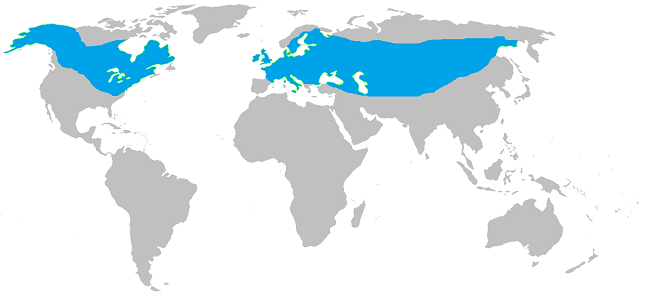
1.2 The species of the genus Esox
- Esox lucius – Pike (Europe), Northern Pike (North America).
- Esox reicherti – Amur Pike.
- Esox masquinongy – Musky.
- Esox niger – Chain Picker.
- Esox americanus – Redfin and Grass Pickerels.
- Esox cisalpinus – Southern Pike (recently discovered in Italy in 2011)
- Esox aquitanicus – A species newly described in southwest France in 2014.
-
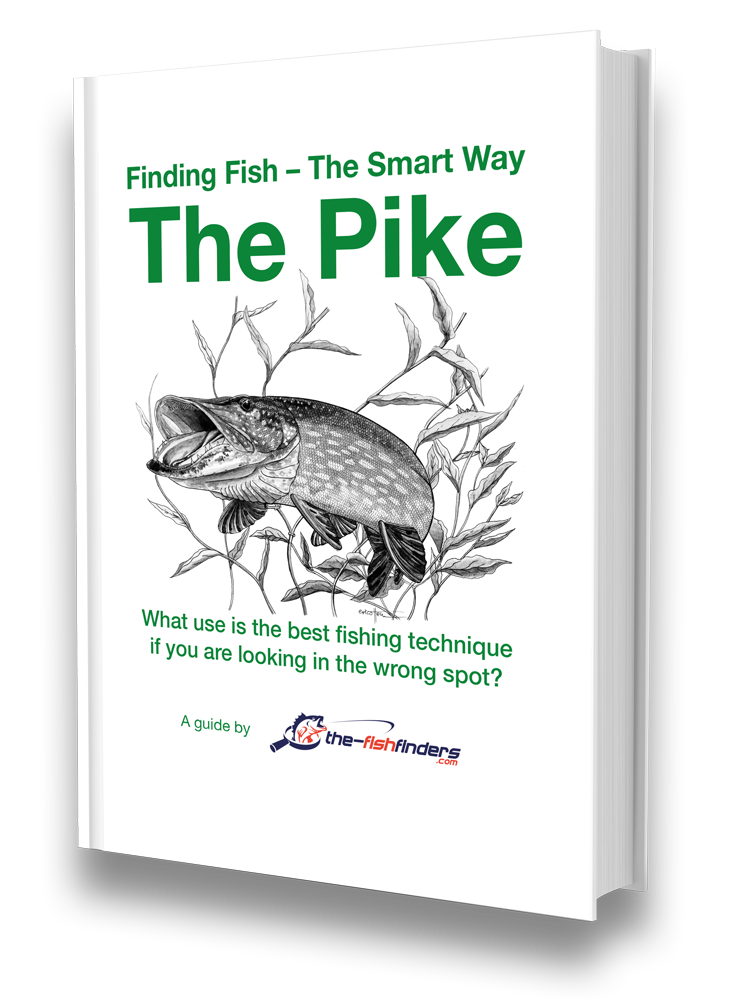
Finding Fish The Smart Way – The Pike
Download 40 pages now for free
This article is an excerpt from:
Reviews ( 64 )
1.2.1 The (northern) pike – Esox lucius: A predator fish
Esox lucius is a top predator in fresh water. But although we have already discovered a lot about the pike through decades of scientific investigation and records, we still have not succeeded in cultivating it on an industrial scale. That means breeding it for consumption in tanks and basins.
2. What does a northern pike look like?
In the following we would like to introduce you to the pike, its appearance and its most important characteristics. First in a short profile and then with more detailed descriptions of some of the most prominent ones of these.
- Family: Esocidae
- Genus: Pike
- Species: Pike
- Latin name: Esox lucius (Linnaeus, 1758)
- Size: Males up to 40“ (100 cm) – females up to approx. 60“ (150 cm).
- Weight: Up to 65 lbs (30 kg).
- Age: 15 to 30 years.
- Color: Dark brown to green with white and yellow stripes and dots.
- Eyes: Round and protruding.
- Food (What do Northern pike eat?) Smaller fish (one third to half their own size), invertebrates, rodents, frogs, lizards, water birds, etc.
- Geographical distribution: In the Northern hemisphere between the latitude 40 and 52.
- Habitat (Where do Northern pike live?): Clear to slightly turbid waters from fresh to brackish, as well standing (lakes) as flowing (rivers).
- In which depths does he live? Until 100 ft (30 m).
- Natural enemies: Full-grown only humans. At earlier livestages perch, minnows and waterfowl, as well as older northerns (cannibalism occurs in the finest families).
- Sexual maturity: From approximately 1-3 years or 15“ (40cm) on.
- Spawning season (When do Northern pike spawn?): In spring at water temperatures of approximately 6-12 °C.
- Oviposition: 1000-700 eggs per sqm, which are laid in batches of up to 60 in a Depth of 3-16 ft (1-5 m).
- Characteristic: Dependent on abundant vegetation until late adulthood to hide and protect from predators.
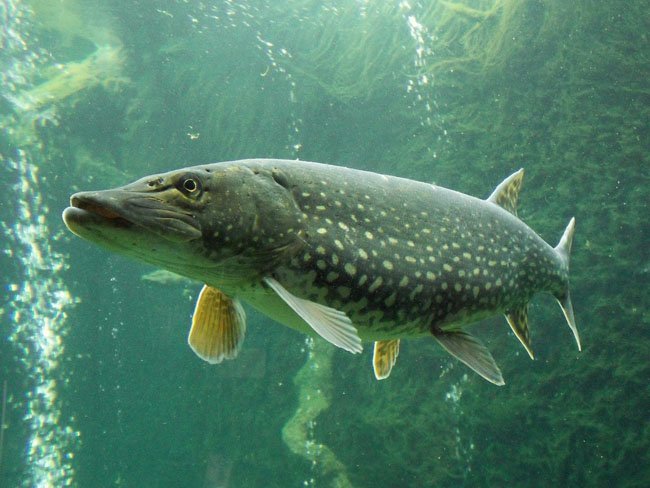
2.1 How long do nothern pike live and how big (weight and size) do they get?
- Age: Pike can live up to 15 – 30 years.
- Length / size: Males up to 40“ (100 cm), females up to 60“ (150 cm).
- Weight: A few specimens have broken the 45 lbs (20 kg) barrier — it are usually the females that hold these records. Pike in Europe and Asia are about the same length and weight. The conspecifics in North America usually do not grow as large. Here, the Musky tends to top the charts for both weight and length.
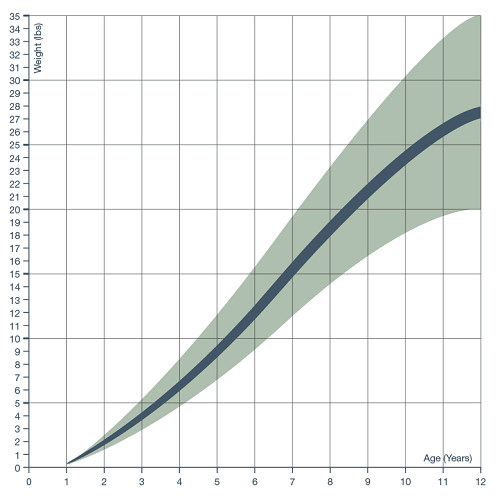
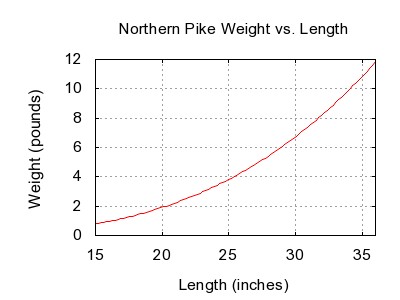
2.2 Which was the biggest pike ever caught (record)?
The biggest pike ever (officially confirmed world record) was caught nearly 30 years ago (October 1986) on Lake Grefeern (Germany) by Lothar Louis. The record fish weighed 25 kg (55 pound, 1-ounce) and reached a length of 136 cm (53.55 in).
In 2020, two more record pike (even bigger than the one just mentioned) were pulled out of the water.
- One in Bulgaria (Petar Filipov – 140 cm / 55.1 in and 25.3 kg / 55.8 lbs)
- and the other in the Czech Republic (Lukas Matejka – 133 cm / 52.4 in and 26.7 kg / 58.1 lbs).
However, neither of these catches has been confirmed so far as the new world record holder.
2.3 Further prominent characteristics of the northern pike
The pike can adapt itself optimally to its environment across different life stages.
- At a young age, it is covered with stripes so that it blends visually with plants and the environment.
- Once its size no longer allows it to hunt the shores effectively, the stripes give way to a dotted pattern. At this point the pike moves its habitat closer to the edges and the open water. Here, it blends with fine particles, the turbidity of the different water layers and the darkness of the depth.
Sharp teeth
The head of a pike is long. If it were an arrow, its head would be the arrowhead. There are two reasons why the pike is such a successful predator: Its eyes and its teeth. It has razor sharp teeth – and above all lots of them. These primarily sit in the jaw but also on the facial bones and palate. Some of them are slightly bent backward to prevent the prey from escaping. Anyone who has ever felt the teeth of a pike knows how sharp these little knives are. Hardly any prey escapes once pinned down by them.
Power and speed
Not only the pike‘s head but also its fins make him a successful predator. The latter are arranged in such a way that he can accelerate quickly from a hiding spot and grab its prey. Like a torpedo, he can pick up speed and push forward.
However, what is an advantage in some contexts can also be a disadvantage in others, because he cannot change direction quickly at this high speed. The pike is therefore less agile than other predators when attacking. For us anglers, this means that reeling in the bait too fast can cause a missed catch. This is because the pike is forced to launch its attack from an unfavorable position. We should therefore not reel too fast – or the pike will not be able to catch up.
-

Finding Fish The Smart Way – The Pike
Download 40 pages now for free
This article is an excerpt from:
Reviews ( 64 )
Martin
Hi Garry, i saw that contacting Jens has solved your problem. As written in the Order Mail, download is limited to 3 times. We introduced the limit to prevent fraud. However, if you lose your eBook in the future, please email us and you will of course get new downloads. Martin- Rated 1 out of 5
Garry Gregg
I bought the book online, but try as I might it would not save on my iPad mini 3, from the small amount i was able to read it looked very good. I was given a link that was promised to ALWAYS be available to me, but this was not the case! I wanted to learn how to find Pike in Lough Neagh, the largest lake in the U.K. but I can only fish it blind, useless. Make sure you can save this book BEFORE you buy. - Rated 5 out of 5
Andreas Eden
Unlike other reviewers, I am NOT in favor of shortening or streamlining. The detailed but not generalized aspects provided are scientifically sound and outline the respective topics exceedingly well. Looking forward to more of this, and keep up the great work! Martin
Hi Claus, Thank you for the info about the Tolino. So far, there have been no problems with the popular Android or Apple smartphones and tablets. We’ll take a look at it. Did the upload via the Tolino web reader not work either? Regards Martin- Rated 2 out of 5
Claus Erhard
The content is decent – maybe a little too detailed. Note: I bought the e-book version. The fact that you can’t print it out is alright (this option would be great though). However, I cannot read the PDF file on my Tolino. I uploaded it 1000 times, and nothing is displayed. So reading is only possible on the PC. Too bad! - Rated 5 out of 5
Dieter Gundacker
Highly recommended, lots of fascinating information. It is not easy to put the book down once you have started reading. - Rated 5 out of 5
Kurt Sattler
Great book. I also have “The Pikeperch”. Both are highly recommended. - Rated 5 out of 5
Mirko
A very well written book. - Rated 4 out of 5
Holzblinker
Among the advantages: -statistics and their interpretation -written in a simple and understandable way Among the disadvantages: -advertising -A lot of generally known information - Rated 3 out of 5
Bruno
Exciting content (****) with a tendency to be long-winded (**) - Rated 5 out of 5
Stefan
The book keeps what it promises. An all-around great book that stands out from the rest. The purchase was worth it! - Rated 5 out of 5
Fischfreund
A truly superb book. I also own the book on pikeperch and have to admit that they are two completely different books. There are very few overlaps, so I never had the feeling that I already knew a passage in the book. For this reason, I can unreservedly recommend the pike book. It was so much fun reading it and gradually learning more about the pike. - Rated 5 out of 5
Paul KraUS
An elaborate approach to the behavior of the fish to conclude your fishing behavior, etc. I also like that other professional opinions are taken into account and partly questioned and analyzed. You can learn a lot to save the one or the other unsuccessful day. Thank you! - Rated 5 out of 5
barney1at
I am impressed with the book! I have read many books about fishing, and this was by far the best. It reflects not only the experiences and interpretations of the authors but uses scientific studies as a basis. Some of the findings knocked my socks off, e.g., the distance of attention of the pike. Strong recommendation for anyone who wants to improve their pike fishing skills! - Rated 5 out of 5
Michael Hügel
Sehr gutes Buch hat mir weitergeholfen das Leben des Hechtes zu verstehen. - Rated 5 out of 5
frankadam67
Sehr, sehr schönes Buch mit vielen Informationen! Nun muss ich nur noch alles in die Tat umsetzen! Danke für das gut ausgearbeitete Buch! - Rated 5 out of 5
Thomas Asamer
Bin gerade am Lesen des Buches. Sehr interessant und informativ. Werde meine Hechtfänge sicherlich noch um einiges steigern können mit dem KnowHow des Buches! Weiter so!? - Rated 5 out of 5
Andre Scholz
Hallo Zusammen, ich kann nur sagen, das habt ihr wirklich sehr gut gemacht! Wahnsinnig informativ, Super gegliedert und mit vielen guten Tipps behaftet. Das Zanderbuch war schon ein Knaller!!! Ich freu mich schon auf das Barschbuch. Und nebenbei erwähnt, die Videolektionen Köderkurs 1 sind ebenfalls Mega spannend! Bitte weiter so machen…. Petri Andre - Rated 5 out of 5
Manfred Parbs
Ich finde die Bücher ” Der Hecht ” sowie ” Der Zander ” sind für erfahrene Angler und auch für den Anfänger sehr lehrreich und somit auch informativ gestaltet. Auch die vielen Tips haben mich persönlich schon so manches mal vor einem Schneidertag bewahrt. Ich besitze zudem auch noch das Buch ” Der grosse Echolotratgeber ” . Dieses Buch liefert gute Erklärungen für die Funktionen und Einstellungen von Echoloten. Desweiteren besitze ich auch noch zwei Angelkurse: zum einen Köderfarbe und zum anderen Der Deeper. Beide Kurse sind mit sehr viel Informationen und verständlichen Erklärungen gespickt die jederman sehr gut verstehen kann. Freue mich schon auf weitere Bücher. Ein grosser Dank als auch ein grosses Lob an das Fischfinderteam. Petri Heil & immer dicke Fische Manfred Parbs - Rated 4 out of 5
Fabius Voigt
Klasse Buch! Fundiertes Wissen auf gute Art und Weise zusammengefasst und übermittelt, damit Angler ihren Zielfisch besser verstehen. An einigen Ecken im Buch, wäre ein weitere genauere Ausarbeitung toll gewesen (wurde vom Autor aber selbst bemerkt und begründet). Desweiteren beruhen die meisten Angaben (90%) von Hechten aus Seen und leider nur sehr wenig aus Flüssen. Das sind meiner Meinung nach die einzigen Sachen die fehlen, aber ansonsten würde ich es als Bereicherung für jeden Angler beschreiben! - Rated 5 out of 5
Julia
Genau wie das Zanderbuch wieder der totale Hammer! Wobei für mich die Voraussetzungen etwas anders waren: Während ich meine Zanderfänge wirklich mal dringend etwas ankurbeln musste, fing ich alleine im vorigen Jahr 47 Hechte, es ging hier also eher um Optimierung. Und das ist voll gelungen! Massen von überaus hilfreichen Forschungsergebnissen, Statistiken und Tafeln. Ich bin beim Spinnangeln bisher zu viel gewandert und habe die einzelnen Spots zu kurz beangelt, das weiß ich jetzt. Und so ganz nebenbei ist mir jetzt noch klar, weshalb man in einigen durchaus interessanten Seen in meiner Umgebung von Juni bis Januar partout keinen Fisch fängt. Habe nämlich so einiges über die Schichtung gelernt, und dass eine Abkühlung eben nicht automatisch gleich Verbesserung bedeutet. Klasse! Her mit dem nächsten Buch bitte! - Rated 5 out of 5
Pascal Schlenker
Top nicht das letzte Buch für mich…. - Rated 5 out of 5
Heinz-Otto Schoel
Auf den 50zig Seiten, die ich bis jetzt gelesen habe ,bin ich begeistert. Aber die anderen Bücher über das Echolot und dem Zander waren sehr lehrreich. Weiter so. Freue mich schon auf das Barschbuch. - Rated 5 out of 5
Andreas Hillers
Modernes Fischen – Der Hecht. Ein sehr gut geschriebenes Buch. Bin begeistert von den vielen tollen Hilfestellungen. Sogar als erfahrener Angler kann hier bestimmt jeder noch den ein oder anderen Tipp für sich nutzen. Vielen lieben Dank, und weiter so für vielleicht weitere noch nicht erschienene Bücher über den Aal, Barsch, Karpfen etc. - Rated 5 out of 5
Stephandargel
Das Buch ist einfach nur klasse super beschrieben sehr verständlich beschrieben kann ich nur weiter empfehlen ? gebe dem Buch und dem Autor ne 1+ - Rated 5 out of 5
Rolf Wilde
Sehr praxisnah und auch mit viel Hintergrundinformationen gefülltes Buch. Ich habe über die Feiertage die ersten Seiten verschlungen. Sehr viele Details die ich noch bis zur Schonzeit versuche umzusetzen. - Rated 5 out of 5
Blankmaster
Die Referenz. Umfassend, kein blabla, über den Tellerrand hinausschauend, fundiert, sinnvolle und gut gemachte Graphiken, und das Ganze zu allem Überfluss auch noch unterhaltsam geschrieben. Als bekennender Wenigleser habe ich das Buch innerhalb von 3 Tagen einmal komplett durchgelesen. Uneingeschränkte Kaufempfehlung. - Rated 5 out of 5
Rudolf Knopf
Endlich ein Buch, welches man durchaus als Fachliteratur beschreiben kann. Es werden viele Erfahrungen, welche ich beim meiner Suche nach dem Hecht gemacht habe, bestätigt. Ebenso ist auch sehr viel Neues für mich in dem Buch, was ich bisher in meiner vieljährigen Anglerlaufbahn so nicht gewust habe. Absolute Kaufempfehlung. - Rated 5 out of 5
markus s
Großes Kompliment zum Buch! Ich fische seit meiner Kindheit auf Hecht (und das sind schon mehr als dreißig Jahre) und ich muss sagen, es gibt keine interessantere Lektüre zum Hecht! Viele eigene Theorien finde ich hier bestätigt, aber noch besser: Dieses Buch bietet auch wirklich neue Ansätze! - Rated 5 out of 5
Mitja
Beeindruckende Leistung von Euch, ein so komplexes Thema derart runterzubrechen, daß man das Buch in einem Rutsch durchlesen kann, ohne sich dauernd zu fragen: „verdammt, wovon labern die denn da?“ Superspannend: die Trophieklassifizierung und die Sache mit der Sprungschicht! Ich sehe meine Gewässer jetzt mit ganz anderen Augen und auf einmal kommen mir die 150 Kracher für das Anaconda-GTM gar nicht mehr so übertrieben teuer vor! Und weil es mir so gut gefallen hat, zieh ich mir morgen direkt das Echolot-Buch rein, das mit der Postbote heute morgen in den Kasten geworfen hat….für das Barschbuch hätte ich übrigens gerne einen Gutscheincode 🙂 Danke! Ich freu mich auf weitere spannende Lektüre aus eurem Stall… - Rated 5 out of 5
schoenfeld.oli
Absolut feine Lektüre. Ich gehe nach Lesen des Buches ganz anders ans Wasser. Zwischendrin etwas fader Stoff, der aber einfach dazu gehört. Dafür sind die spannenden Themen so spannend, dass ich nicht im Sitzen lesen konnte. - Rated 5 out of 5
Robert Häusler
Die beiden Autoren Martin Jacobs und Jens Biegemeier sind der Hammer. Ich habe schon viel gut recherchierte Medizinbücher gelesen und oft haben sie mir zu mehr Erfolg verholfen, dass das auch mal Zum Hechtangeln möglich wird ist großartig. Danke an dieses Meisterwerk! Ich habe mit dem Wissen aus dem Buch jetzt schon meinen Angelrekord auf Hecht gebrochen und bin mir sicher da geht noch was. Danke für eure Arbeit, den Fleiß und die Begeisterung die ihr geleistet haben müsst dieses moderne Fische finden für uns und unsrer Seekrokodiele zu ermöglichen. Petri Robert Häusler Martin
Edi, wir danken Dir und wünschen euch gute Fänge. Petri Martin vom Fischfindertestteam- Rated 5 out of 5
Edi Brader
Das beste Buch über die Fischerei auf Hecht, das ich bisher in Händen gehalten habe! Sehr ausführlich und praxisnah wird dem Einsteiger in diese Fischerei veranschaulicht worauf es ankommt und auch der eingefleischte Hechtprofi kann noch sehr viel Nützliches aus diesem Buch herausholen! Absolut EMPFEHLENSWERT! Besonders möchte ich das äußerst nette Team loben! Bei meiner Bestellung ging etwas schief, ich bekam zwei anstatt nur einer Ausgabe. Nach Rücksprache bedankten sie sich für die Information und sagten mir, dass das Zurücksenden ohnehin zu teuer wäre und ich das zweite Exemplar auch behalten dürfte. Danke Jungs, ihr habt gerade einem befreundeten Jungangler eine große Freude gemacht, ich werde euch auf jeden Fall weiterempfehlen! Macht weiter so! Petri Heil Edi Brader - Rated 5 out of 5
lusox
Prima Lektüre , wirklich zu empfehlen ! Besonders gut fand ich das Kapitel mit der Ködergröße. Ebenso das Kapitel mit den Standplätzen und die Rolle der Vegetation Ich habe viele Anregungen daraus mitgenommen und bin mal gespannt wie sich meine Hechtfänge verbessern. Weiter so ! - Rated 5 out of 5
Stefan Fischer
Ich finde, das Buch “Der Hecht” lüftete viele Geheminisse. Hatte das Buch “Der Zander” auch, alles top tock. Hoffentlich folgt das Buch auch über den Barsch, evtl. Waller/Wels. Mir fehlt die Anglerpraxis. Das Buch “Das große Echolot” ist auch klasse. Weiter studieren!!! ^^ Namaste und Petri Fischer Stefan - Rated 5 out of 5
Lasse Wiedenhöft
Wie schon beim Zanderbuch werden für alle denkbaren Situationen (Jahreszeiten, Gewässer, Wetter etc.) hilfreiche Tipps zur Strategieverbesserung gegeben. Dabei helfen die Ergebnisse aus diversen Versuchen und Tests den Hecht und sein Verhalten besser zu verstehen. Gerade die wissenschaftliche Begleitung in Kombination mit eigenen Erfahrungen hat mir schon nach wenigen Kapiteln neue Ideen vermittelt! - Rated 5 out of 5
Johann Burgstaller
Wie bereits “Der Zander”, ist auch die Hechtausgabe wieder jeden Cent wert. Ein must-have für jeden Raubfischangler. Tolle Studien, jede Menge neue Erkenntnisse und enifach zu lesen. Na dann nichts wie auf zum “Der Barsch”! - Rated 5 out of 5
Barschhunter
Das Buch ist Euch wirklich super gelungen!!!!! Es ist sehr informativ und es ist für jeden etwas dabei, ob man nun Anfänger im Angeln ist oder ein erfahrener Angler ist. Man kann immer noch was dazu lernen. Für mich persönlich war das Kapitel “Jagd und Beute” sehr interessant und spannend und möchte deswegen keine einzelnen Punkt hervorheben. Macht weiter so und ich freue mich schon auf Euer nächstes Buch “Modernes Fische Finden Der Barsch” mein persölicher favorite Fisch. Dickes Petrie Barschhunter - Rated 5 out of 5
Andre Scholz
Genauso spannend und aufschlussreich wie das Zander Buch! Wenn man seinen Zielfisch besser verstehen möchte und mehr Erfolg haben will, kommt man nicht um das Buch herum! Allein die Thematik um die Wassertemperaturen, einfach irre! Volle 5 Sterne und Danke für so viel geilen Input! Petri Andre - Rated 5 out of 5
Andreas F.
Sehr schön finde ich die Aufmachung des Buches und die logisch aufbauenden Kapitel. Das Lesen macht viel Spaß. Hier treffen die Autoren genau den richtigen Ton, einen “mitzunehmen”, obwohl die Grundlagen ja wissenschaftlich/biologisch sind. Es ist nicht einfach, plausibel und allgemein verständlich, verschiedene wissenschaftliche Erkenntnisse miteinander zu verknüpfen und hieraus die passenden Schlussfolgerungen zu ziehen. Das ist jedoch durchaus gelungen. Abläufe in der Natur sind nie statisch sondern unterliegen Abweichungen, es gibt aber Tendenzen. Deshalb kann es nicht immer genaue Gesetzmäßigkeiten geben. Hierauf weist das Buch in verschiedenen Kapitel immer wieder hin. Hier hätte ein grundlegender Hinweis in der Einleitung m.e. jedoch ausgereicht. Randnotiz: Ein Absatz erscheint wortgleich an zwei Stellen (S. 11, 1.Abs. und S. 15 3. Abs.). Im Ergebnis ist es ein Buch, was sogar enthusiastischen Raubfischanglern richtig weiterhilft! Meine Erwartungshaltung wurde sogar übertroffen. Ich freue mich auf euer Barschbuch! Vielen Dank! - Rated 5 out of 5
Pascal Kreutzmann
Wie die beiden Bücher zuvor hat mich auch das Buch über den Hecht mal wieder total begeistert. Unglaublich was ihr für einen Aufwand betreiben müsst um all dieses Wissen und die Studien zusammen zu tragen. Besonders interessant fand ich zb. die Frage danach wieviele Hechte sich denn in so einem Gewässer aufhalten. An wievielen Fischen man vorbei angelt. Das war echt interessant. Ebenso die Standplätze der Fische zu den verschiedenen Jahreszeiten und wie sehr vieles von der Wassertemperatur abhängt finde ich sehr Aufschlussreich. Auch über das fressen und gefressen werden kann man einiges erfahren. Jetzt ist mir klar warum der Hecht die Beute am liebsten am Kopf packt und sie möglichst schnell verschlingen muss. Tja die Themenvielfalt ist echt groß. Was mich noch interessiert hätte….wie/was sieht der Hecht durch seine Augen ? Was für Farben nimmt er wahr etc ? Aber das wäre eventuell zu speziell ?! Freue mich auf das nächste Buch! Bloß nicht nachlassen und genauso ausführlich weiter machen. Danke dafür. Ps…ich rezensiere aus Überzeugung , nicht wegen einem Gummifisch ! Grüße und Petri Pascal - Rated 5 out of 5
Ralf B.
Genauso interessant und prall gefüllt mit wertvollen Infos wie das Zanderbuch, einfach TOP! - Rated 5 out of 5
Bickes
Sehr gut strukuriert, sehr informativ, mir hat es definitiv geholfen, meine Taktik zu verbessern und selbstbewusster meine Stellen auszuwählen. - Rated 5 out of 5
opto
Habe alle 3 Bücher! Bin begeistert und dankbar!! Interessieren würde mich warum gerade der Hecht an einem Tag wie verrückt beißt und am nächsten Tag bei absolut gleichen Bedingungen am selben Ort wie ausgestorben erscheint! Interessieren würde mich auch wie der Zander als Augentier mit Sichtigkeiten unter 5cm klarkommt! (Hochwasser) Diese Fragen beschäftigen mich schon ein ganzes Anglerleben. - Rated 5 out of 5
Adrian Drzezla
Das Buch hat sehr viele Informationen über unseren Esox Lucius;). Jedes Kapitel ist sehr spannend und reichhaltig an Informationen. Nach diesem Buch habe ich meine Angelstrategie verbessern können und ich habe nun eine andere Ansicht von unserem Hecht im Wasser bekomme. Petri ! „ sehr empfehlenswert , Genau so wie die letzten Bücher von Fischfindertest“ - Rated 5 out of 5
Evgenij
Suuuper Buch, genau so wie das Zander Buch. Bin total begeistert. Sieht wie eine Doktorarbeit aus. Wissenschaftlich überprüft mit Verweisen, vielen Abbildungen und vielen praktischen Tips. Freue mich auf die neue Bücher! - Rated 5 out of 5
Daniel
Ich kann das Buch jedem Raubfischangler weiterempfehlen. Viele neue und nützliche Informationen rund um unseren Zielfisch Nr. 1. Tolle Arbeit! - Rated 5 out of 5
Jörg
Tolles Buch, hochinformativ von der ersten bis zur letzten Seite. Das Jahr des Hecht hat mir am besten gefallen. Man kann das Buch nur weiterempfehlen! - Rated 5 out of 5
Dirk Lindner
Top buch.umfangreich.logisch.sollte jeder haben.das Zander buch habe ich auch - Rated 5 out of 5
Jörg Thielke
Hoch interessant und verständlich geschrieben. In jedem Fall vollumfänglich weiterzuempfehlen. Danke Männers ? - Rated 5 out of 5
Stefan Klingbeil
Es war nicht anders zu erwarten. Nach dem Zander Buch bin ich wieder voll zufrieden.Die Bücher unterscheiden sich von anderen Büchern und Artikeln aus Zeitschriften. Mehr input brauch ich nicht. Alles erklärt und vernünftig erklärt. Ich lese wirklich nicht gerne Bücher. Aber hier ist es wie ein guter Krimi. Man kann nicht aufhören. Wir haben es alle gelesen und Diskutieren unser Wissen zusammen um es nochmal zu vertiefen. Jetzt freuen wir uns auf Der Barsch ? - Rated 5 out of 5
Jörg Rolle
Ein sehr gutes Buch so wie ich es erwartet habe nach dem ich Euer Zander-Buch gelesen habe. bin begeistert viele Tipps in Jagd und Beute,Umweltfaktoren,Lebensräume Kapitel 5.2.2 und Das Jahr des Hechtes.Habe noch nicht viel Erfahrung Hecht angeln ,das Buch hat mir viel Wissen übermittelt auch wenn ich noch nicht alles gelesen habe. Danke weiter so Petri - Rated 5 out of 5
Philipp
Kurz und knapp, Top! Wie auch bereits im Buch “Modernes Fische finden Der Zander” erneut abgeliefert. Besten Dank, macht weiter so! - Rated 5 out of 5
Ben
Glaube ich hab gerade vergessen die Sterne zu drücken! Auf jeden Fall 5 Sterne da es super verständlich geschrieben ist! Es beschreibt das Verhalten der Fische in verschiedenen Situationen und wenn man das versteht und nutzt fängt man sicher bald besser! Auch die Grafiken und Bilder vereinfachen es sehr gut. Bin sehr zufrieden und hoffe das noch eins für Barsche und Wels kommt! ?? - Rated 5 out of 5
Nico Drabner
Volle Punktzahl ?? Ein dickes Lob. Sehr schön aufgebaut. Am besten hat mir die Gewässeranalyse und die Aussage mit der Wassertemperatur gefallen, das passt zu 100% und Danke an den vielen nützlichen Tipps - Rated 5 out of 5
Kuhnert Giso
Also ich habe schon das Buch vom Zander gelesen. Und auch dieses Buch vom Hecht ist sehr Lehrreich mit vielen interessanten Kapiteln.. Ich bin noch nicht ganz durch mit dem lesen, aber ich weiß das es toll ist und mir auf alle Fälle weiter helfen wird um den ein oder anderen Hecht mehr an den Haken zu bekommen. Ich empfehle es auf alle Fälle weiter.. Und auch das nächste Buch über den Barsch werde ich mir holen. Macht weiter so fünf Sterne gibt’s vom mir. LG Giso - Rated 5 out of 5
David Götze
Hallo zusammen, ich habe mittlerweile alle 3 Bücher und kann ehrlich behaupten, dass es mir beim Angeln bzw. Fische finden sehr viel gebracht hat. Vorallem das Angeln unter Einfluss der Mitwelt (Wind, Temperatur…etc) lässt mich jetzt meine Spotwahl genauer überdenken. Vielen Dank dafür und ich freu mich schon auf den Barsch ^^ Petri David - Rated 4 out of 5
Peter
absolute Empfehlung - Rated 5 out of 5
Ben
Finde das Buch sehr gut! Genau wie das Zander Buch beschreibt es worauf es ankommt… das Verhalten der Fische in verschiedenen Situationen. Es ist verständlich erklärt und die Bilder und Grafiken machen es noch einfacher zu verstehen worauf es ankommt! Weiter so! Barsch und Wels können kommen? - Rated 5 out of 5
Kantor Alfred (Hatschi)
Ich habe viele Jahre viel Zeit verschwendet weil ich den Fisch nicht immer gefunden habe, dass Buch hilft wirklich die Fische zu finden. Ich habe es nicht nur gelesen sondern auch schon teilweise am Wochenende umgesetzt und das mit Erfolg (einige schöne Hechte), vielen dank ich freue mich auf euer nächstes Werk Der Barsch. Weiter so!!! Petri Heil Hatschi - Rated 5 out of 5
Patrick
Also ich muss jetzt mal eine Lanze brechen, es gibt doch noch qualitativ hochwertige Bücher zum Thema Fisch und dann noch direkt zum Thema Hecht, in einer Qualität die ihres gleichen sucht. Selten das ich derart im „Rausch“ ein Buch gelesen habe. Hut ab und weiter so. - Rated 5 out of 5
Tacklefever
Ich war sehr positiv überrascht. Der Anfänger erhält im ersten Teil des Buches wirklich brauchbares Basiswissen vermittelt. Und der ein oder andere Profi wird vielleicht sagen: “Mache ich doch immer so”. Und das ist doch das beste Lob für den ersten Teil des Buches. Aber wenn der Profi ehrlich ist, kann er wahrscheinlich schon zugeben, das ein oder andere gefunden zu haben was er vergessen hatte oder doch noch nicht wusste. Und richtig spannend für Anfänger und Profi ist der Hautteil des Buches, das Kapitel “Jahr des Hechtes”. Dieser Teil hat absolut zu Recht den meisten Platz im Buch bekommen. Bei den einfach gegliederten und nachvollziehbaren Abschnitten im Jahr des Hechtes findet sicher nicht nur der Anfänger sondern auch der Profi jede Menge tolle Infos. Meine volle Buchbesprechung findet ihr unter https://www.tacklefever.de/index.php?topic=7396.0 - Rated 5 out of 5
Andreas
Wie erwartet, ein sehr gutes Buch das nicht in dem Köderwahnsinn hinterherläuft. Besonders gut gefällt mir die Analyse der Wassertemperaturbereiche passend für meine großen See in Mecklenburg. Die Gewässeranalysen passen wie die Faust auf Auge auf dieses sehr große Gewässer. Die neuen Möglichkeiten und überragenden Fänge von einigen lokalen Guides erzielt werden, welche in Großen Teilen durch die gewaltigen Technologiesprünge im Echolotbereich und Bootsnavigation begründet sind, wurde hier sehr gut zusammengefasst. Eine Pflichtlektüre für jeden der sich an die großen Gewässer mit den noch größeren Fische wagen will. Definitiv 5 Sterne, das Buch wurde auch innerhalb von 2 Nachmittagen gelesen. Danke! - Rated 5 out of 5
Wolfgang Konter
Habe das Buch heute bekommen .Dafür erstmal ein großes Danke schön an Euch . Nach dem ersten Durchblättern war ich begeistert . Habe eigentlich auch nichts anderes erwartet . “Modernes Fische finden – Der Zander” habe ich ja schon lange durch und blättere immer wieder drin rum . Beide Bücher zeugen von viel Sachverstand und Erkenntnissen , die ich so nicht erwartet hätte . Einfach super und verständlich erklärt . Jetzt will ich nur hoffen , dass noch ein Barsch Buch auf dieses Duo folgt . Petri Heil Wolfgang Konter - Rated 5 out of 5
Catchmaster
Habe das Buch heute direkt durchgelesen. Es ist gut aufgebaut und es gibt viele nützliche Tip’s. Anfang Mai waren wir in Schweden auf Hecht angeln. Schade, dass ich dieses Buch nicht schon vorher hatte. Aufgrund der neuen Erkenntnis hätte ich bestimmt mehr Erfolg gehabt. An sich ein super Buch. Werde jetz die Tip’s in die Praxis umsetzen. Vielen Dank für dieses Buch. - Rated 5 out of 5
Jörg Rolle
Habe das Buch Heute erhalten und sofort durchgestöbert,bin Begeistert! Sehr schöne Aufmachung, gut Gegliedert und nicht zu wissenschaftlich so das es jeder Angler verstehen kann.Habe auch schon Kapitel gefunden die mir reichlich neues und gute Tipps für meine Angelpraxis gefunden. Weiter so!!!!!!! Petri Jörg Rolle
3. The typical habitat: Where do northern pikes live?
We know a great deal about the habitats of pike. Intensive research has been carried out on the subject since the 1950s. Some long-term studies were carried out over many years. For example, one study investigated the effects of a changing water level on the pike‘s growth. The study lasted from 1971 to 1992. That was not less than 22 years. Overally the researchers obtained very detailed results on the different growth rates with it. Many other studies also illustrate nicely how pike
- interact with different habitats,
- what the habitats have in common
- and what distinguishes them.
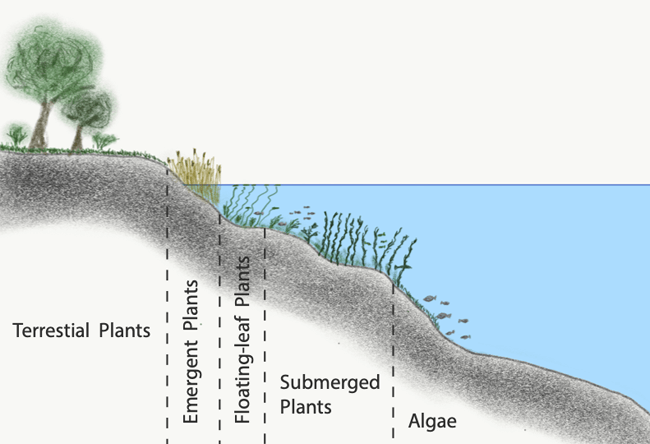
Vegetation is the anchor point of a pike‘s life. It needs vegetation to survive as well as oxygen to breathe. A healthy aquatic flora is therefore fundamental for a healthy pike population. Without a sufficient amount of water plants, there would be none.
From the spawn on (which is strongly correlated to plants) the underwater vegetation forms the basis of the life of the northern pike. They can hide between the plants from predators and stalk their own prey. The lurking behavior solidifies with increasing age and expresses itself in the „sit and wait“ tactic — pike use their natural camouflage between plants to wait motionless for prey to swim past and then strike at the right moment.
Besides that northern pike inhabit freshwater, are demersal and can inhabit waters from 0 to 30 m (0 – 100 feet). They occur in
- clear vegetated lakes,
- quiet pools
- and the backwaters of creeks
- as well as in small to large rivers.
3.1 The pike and its territory
Often, we oversimplify the pike‘s territory, not doing justice to this adaptable predator. Young pike regularly have only one fixed territory. The risk of falling prey to a larger predator is high, so they seldom leave their small shelter. During adulthood, the boundaries of their hunting grounds become blurred, and they have a larger radius of action. Studying this aspect of the pike‘s behavior is essential to our fishing success as it allows us to reliably locate our target.
The territorial behavior of the pike was first scientifically recorded in the 1940s and since then has been the subject of various studies more. One of the most famous studies dates back to 1977 when researchers investigated a 11 acres (4.5 ha) lake shore, dividing it into 330 ft (100 m) wide sections. After the spawning period, the researchers caught a few pike with the aid of electric fishing (applying direct current to the water).
The pike catched with this methode were marked and returned to the center of the catch zone. In autumn, the same pike were caught again. The results were astonishing:
- 80 % of all the pike were caught within a radius of just 330 ft (100 m) from their place of release.
- 11 % were caught between 330-660 ft (100-200 m) from the release spot
- And only 9 % were caught outside of that range.
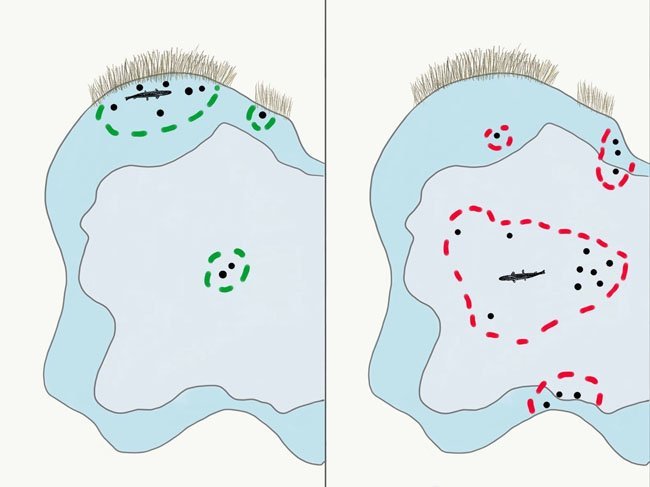
The behavior of pike within their territory was also studied. Some pike did not leave their 30 by 30 feet (ten by ten-meter) area for up to eleven months. Others moved to the reed in the morning and back to the open water at dawn – they did this all summer long. We should also not forget to mention that there were major seasonal differences in the behaviour of the of the observed specimens.
4. The life cycle of the northern pike
In this chapter we are going to have a closer look at the life cycle of the northern pike, starting at its very beginning and therefore with the answer to question
4.1 When do northern pike spawn?
In general pike reach their sexual maturity with two to three years of age. However, the size of the fish is more important than its mere age. As females increase in size, they can produce and spawn more eggs, which makes them more attractive to their male counterparts.
Seasonally speaking, the spawning season begins in early spring (between March and April) – depending on the water temperature also as early as February and reaching into May or even June – when the vegetation starts to grow.
That the time is not set in stone is due to the fact that a water temperature of about 40 degrees fahrenheit is required. A temperature that is reached at a different time of the year depending on the latitude.
Tip: In the pre-spawning period, just before and during the ice thaw in early spring, male and female pike feed almost feverishly to get in shape for the mating season. Just the opposite as our species. Therefore, this pre-spawning period is also highly favorable to catch a pike. However, be sure to check if pike fishing is allowed at your favorite fishing grounds at this season.
4.2 The spawning process
Males move into spawning grounds some time (days to weeks) before the actual spawning season begins in order to occupy the best positions.
Pike like to spawn in:
- Shallow weed beds.
- Sandy and silty areas over gravel or rocks.
- In the dead stems of rushes and reeds.
- All other areas with sufficient vegetation.
If they are river-dwelling pike, they will migrate upstream into shallow, weedy backwaters and pools. Lake-dwelling individuals migrate into shallow, weedy bays.
The females then join them for spawning exclusively. A female pike spawns up to 50,000 sticky and amber colored eggs, which are fertilized by the male and then attach to the surface of aquatic plants. Spawning normally occurs during daylight hours in shallow quiet areas with a weed bottom.
If an egg does not fall victim to a voracious crayfish, frog, turtle or other fish, then a so-called sac fry will hatch from it after about two weeks (with a necessary temeprature of between 45 and 66 degrees F). That is a baby pike, that gets it´s name from the large yolk sac that is still part of it´s body.
For another 10 days, it remains attached to the plant on which it hatched via a sticky droplet on its forehead. During this period, the newly hatched pike feeds exclusively on its yolk sac.
Only then does it become a swim-up fry, which makes short trips into the open water to capture tiny pieces of plankton. Most of the time, however, it still spends in the protection of its nest of aquatic plants.
After another month – and grown to the size of a human finger – the little fingerling already has enough muscles (as well as the first little teeth) to make real prey. Smaller fish of other species, which hatched later.
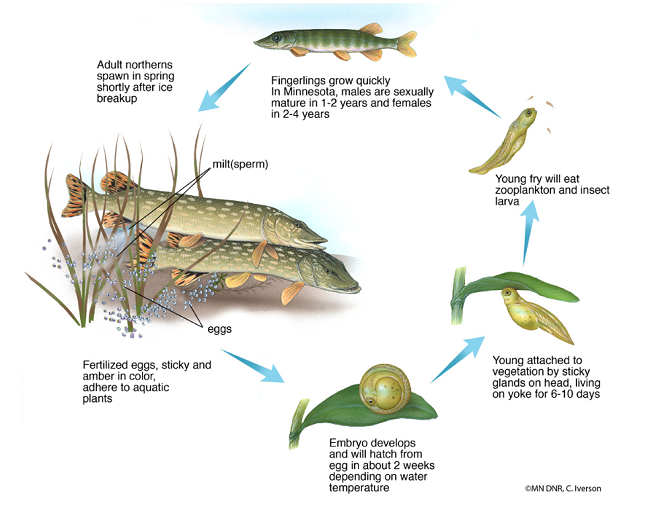
The schematic life-cycle of the Northern Pike. Picture Credit: University of Minnesota.
4.3 How big do northern pike get? (And how long do they live?)
Although pike grow at different rates, compared to many other fish, they grow faster and can reach the 20“ (50 cm) mark within the first year. Of course, that applies to some and not all individuals. However pike not only grow fast, but can also reach an impressive size. Regularly specimens are caught that reach beyond the 3-foot (1-meter) mark. Some are even over 50“ (130 cm) in length.
Pike can grow old, too. A bit less than half the pike populations are older than six or seven years. Few of them are older than 12 years. Under good conditions, some pike can even reach an age of over 20 years – we are usually talking about females here. They also grow faster than their male counterparts and thus reach bigger lengths.
If we look at the course of a year, it quickly becomes apparent why this is so. If we start our observation after the salmon season in April/May, all pike, no matter which sex, grow rapidly in the months after spawning. They feed far into the summer. While the development of the females fluctuates between normal to fast up until the next spawning season, the same cannot be said about the males.
In summer, the growth rate of the males decreases significantly. They even lose weight during this time, sometimes more than 10% of it. It is not until September that the males start feeding heavily again to grow until the next spawning season. They then gain up to a quarter of their weight again. From this circumstances we can draw very useful conclusions about the best time for pike fishing – growth implies that they are consuming more energy than they need.
There are also geographical differences in the growth rate of pike. Specimens that live between 40° to 44° latitude take about 8-10 years to reach 80 cm in length, while pike from 50° to 52° take closer to 15-20 years to do so.
-

Finding Fish The Smart Way – The Pike
Download 40 pages now for free
This article is an excerpt from:
Reviews ( 64 )
Martin
Hi Garry, i saw that contacting Jens has solved your problem. As written in the Order Mail, download is limited to 3 times. We introduced the limit to prevent fraud. However, if you lose your eBook in the future, please email us and you will of course get new downloads. Martin- Rated 1 out of 5
Garry Gregg
I bought the book online, but try as I might it would not save on my iPad mini 3, from the small amount i was able to read it looked very good. I was given a link that was promised to ALWAYS be available to me, but this was not the case! I wanted to learn how to find Pike in Lough Neagh, the largest lake in the U.K. but I can only fish it blind, useless. Make sure you can save this book BEFORE you buy. - Rated 5 out of 5
Andreas Eden
Unlike other reviewers, I am NOT in favor of shortening or streamlining. The detailed but not generalized aspects provided are scientifically sound and outline the respective topics exceedingly well. Looking forward to more of this, and keep up the great work! Martin
Hi Claus, Thank you for the info about the Tolino. So far, there have been no problems with the popular Android or Apple smartphones and tablets. We’ll take a look at it. Did the upload via the Tolino web reader not work either? Regards Martin- Rated 2 out of 5
Claus Erhard
The content is decent – maybe a little too detailed. Note: I bought the e-book version. The fact that you can’t print it out is alright (this option would be great though). However, I cannot read the PDF file on my Tolino. I uploaded it 1000 times, and nothing is displayed. So reading is only possible on the PC. Too bad! - Rated 5 out of 5
Dieter Gundacker
Highly recommended, lots of fascinating information. It is not easy to put the book down once you have started reading. - Rated 5 out of 5
Kurt Sattler
Great book. I also have “The Pikeperch”. Both are highly recommended. - Rated 5 out of 5
Mirko
A very well written book. - Rated 4 out of 5
Holzblinker
Among the advantages: -statistics and their interpretation -written in a simple and understandable way Among the disadvantages: -advertising -A lot of generally known information - Rated 3 out of 5
Bruno
Exciting content (****) with a tendency to be long-winded (**) - Rated 5 out of 5
Stefan
The book keeps what it promises. An all-around great book that stands out from the rest. The purchase was worth it! - Rated 5 out of 5
Fischfreund
A truly superb book. I also own the book on pikeperch and have to admit that they are two completely different books. There are very few overlaps, so I never had the feeling that I already knew a passage in the book. For this reason, I can unreservedly recommend the pike book. It was so much fun reading it and gradually learning more about the pike. - Rated 5 out of 5
Paul KraUS
An elaborate approach to the behavior of the fish to conclude your fishing behavior, etc. I also like that other professional opinions are taken into account and partly questioned and analyzed. You can learn a lot to save the one or the other unsuccessful day. Thank you! - Rated 5 out of 5
barney1at
I am impressed with the book! I have read many books about fishing, and this was by far the best. It reflects not only the experiences and interpretations of the authors but uses scientific studies as a basis. Some of the findings knocked my socks off, e.g., the distance of attention of the pike. Strong recommendation for anyone who wants to improve their pike fishing skills! - Rated 5 out of 5
Michael Hügel
Sehr gutes Buch hat mir weitergeholfen das Leben des Hechtes zu verstehen. - Rated 5 out of 5
frankadam67
Sehr, sehr schönes Buch mit vielen Informationen! Nun muss ich nur noch alles in die Tat umsetzen! Danke für das gut ausgearbeitete Buch! - Rated 5 out of 5
Thomas Asamer
Bin gerade am Lesen des Buches. Sehr interessant und informativ. Werde meine Hechtfänge sicherlich noch um einiges steigern können mit dem KnowHow des Buches! Weiter so!? - Rated 5 out of 5
Andre Scholz
Hallo Zusammen, ich kann nur sagen, das habt ihr wirklich sehr gut gemacht! Wahnsinnig informativ, Super gegliedert und mit vielen guten Tipps behaftet. Das Zanderbuch war schon ein Knaller!!! Ich freu mich schon auf das Barschbuch. Und nebenbei erwähnt, die Videolektionen Köderkurs 1 sind ebenfalls Mega spannend! Bitte weiter so machen…. Petri Andre - Rated 5 out of 5
Manfred Parbs
Ich finde die Bücher ” Der Hecht ” sowie ” Der Zander ” sind für erfahrene Angler und auch für den Anfänger sehr lehrreich und somit auch informativ gestaltet. Auch die vielen Tips haben mich persönlich schon so manches mal vor einem Schneidertag bewahrt. Ich besitze zudem auch noch das Buch ” Der grosse Echolotratgeber ” . Dieses Buch liefert gute Erklärungen für die Funktionen und Einstellungen von Echoloten. Desweiteren besitze ich auch noch zwei Angelkurse: zum einen Köderfarbe und zum anderen Der Deeper. Beide Kurse sind mit sehr viel Informationen und verständlichen Erklärungen gespickt die jederman sehr gut verstehen kann. Freue mich schon auf weitere Bücher. Ein grosser Dank als auch ein grosses Lob an das Fischfinderteam. Petri Heil & immer dicke Fische Manfred Parbs - Rated 4 out of 5
Fabius Voigt
Klasse Buch! Fundiertes Wissen auf gute Art und Weise zusammengefasst und übermittelt, damit Angler ihren Zielfisch besser verstehen. An einigen Ecken im Buch, wäre ein weitere genauere Ausarbeitung toll gewesen (wurde vom Autor aber selbst bemerkt und begründet). Desweiteren beruhen die meisten Angaben (90%) von Hechten aus Seen und leider nur sehr wenig aus Flüssen. Das sind meiner Meinung nach die einzigen Sachen die fehlen, aber ansonsten würde ich es als Bereicherung für jeden Angler beschreiben! - Rated 5 out of 5
Julia
Genau wie das Zanderbuch wieder der totale Hammer! Wobei für mich die Voraussetzungen etwas anders waren: Während ich meine Zanderfänge wirklich mal dringend etwas ankurbeln musste, fing ich alleine im vorigen Jahr 47 Hechte, es ging hier also eher um Optimierung. Und das ist voll gelungen! Massen von überaus hilfreichen Forschungsergebnissen, Statistiken und Tafeln. Ich bin beim Spinnangeln bisher zu viel gewandert und habe die einzelnen Spots zu kurz beangelt, das weiß ich jetzt. Und so ganz nebenbei ist mir jetzt noch klar, weshalb man in einigen durchaus interessanten Seen in meiner Umgebung von Juni bis Januar partout keinen Fisch fängt. Habe nämlich so einiges über die Schichtung gelernt, und dass eine Abkühlung eben nicht automatisch gleich Verbesserung bedeutet. Klasse! Her mit dem nächsten Buch bitte! - Rated 5 out of 5
Pascal Schlenker
Top nicht das letzte Buch für mich…. - Rated 5 out of 5
Heinz-Otto Schoel
Auf den 50zig Seiten, die ich bis jetzt gelesen habe ,bin ich begeistert. Aber die anderen Bücher über das Echolot und dem Zander waren sehr lehrreich. Weiter so. Freue mich schon auf das Barschbuch. - Rated 5 out of 5
Andreas Hillers
Modernes Fischen – Der Hecht. Ein sehr gut geschriebenes Buch. Bin begeistert von den vielen tollen Hilfestellungen. Sogar als erfahrener Angler kann hier bestimmt jeder noch den ein oder anderen Tipp für sich nutzen. Vielen lieben Dank, und weiter so für vielleicht weitere noch nicht erschienene Bücher über den Aal, Barsch, Karpfen etc. - Rated 5 out of 5
Stephandargel
Das Buch ist einfach nur klasse super beschrieben sehr verständlich beschrieben kann ich nur weiter empfehlen ? gebe dem Buch und dem Autor ne 1+ - Rated 5 out of 5
Rolf Wilde
Sehr praxisnah und auch mit viel Hintergrundinformationen gefülltes Buch. Ich habe über die Feiertage die ersten Seiten verschlungen. Sehr viele Details die ich noch bis zur Schonzeit versuche umzusetzen. - Rated 5 out of 5
Blankmaster
Die Referenz. Umfassend, kein blabla, über den Tellerrand hinausschauend, fundiert, sinnvolle und gut gemachte Graphiken, und das Ganze zu allem Überfluss auch noch unterhaltsam geschrieben. Als bekennender Wenigleser habe ich das Buch innerhalb von 3 Tagen einmal komplett durchgelesen. Uneingeschränkte Kaufempfehlung. - Rated 5 out of 5
Rudolf Knopf
Endlich ein Buch, welches man durchaus als Fachliteratur beschreiben kann. Es werden viele Erfahrungen, welche ich beim meiner Suche nach dem Hecht gemacht habe, bestätigt. Ebenso ist auch sehr viel Neues für mich in dem Buch, was ich bisher in meiner vieljährigen Anglerlaufbahn so nicht gewust habe. Absolute Kaufempfehlung. - Rated 5 out of 5
markus s
Großes Kompliment zum Buch! Ich fische seit meiner Kindheit auf Hecht (und das sind schon mehr als dreißig Jahre) und ich muss sagen, es gibt keine interessantere Lektüre zum Hecht! Viele eigene Theorien finde ich hier bestätigt, aber noch besser: Dieses Buch bietet auch wirklich neue Ansätze! - Rated 5 out of 5
Mitja
Beeindruckende Leistung von Euch, ein so komplexes Thema derart runterzubrechen, daß man das Buch in einem Rutsch durchlesen kann, ohne sich dauernd zu fragen: „verdammt, wovon labern die denn da?“ Superspannend: die Trophieklassifizierung und die Sache mit der Sprungschicht! Ich sehe meine Gewässer jetzt mit ganz anderen Augen und auf einmal kommen mir die 150 Kracher für das Anaconda-GTM gar nicht mehr so übertrieben teuer vor! Und weil es mir so gut gefallen hat, zieh ich mir morgen direkt das Echolot-Buch rein, das mit der Postbote heute morgen in den Kasten geworfen hat….für das Barschbuch hätte ich übrigens gerne einen Gutscheincode 🙂 Danke! Ich freu mich auf weitere spannende Lektüre aus eurem Stall… - Rated 5 out of 5
schoenfeld.oli
Absolut feine Lektüre. Ich gehe nach Lesen des Buches ganz anders ans Wasser. Zwischendrin etwas fader Stoff, der aber einfach dazu gehört. Dafür sind die spannenden Themen so spannend, dass ich nicht im Sitzen lesen konnte. - Rated 5 out of 5
Robert Häusler
Die beiden Autoren Martin Jacobs und Jens Biegemeier sind der Hammer. Ich habe schon viel gut recherchierte Medizinbücher gelesen und oft haben sie mir zu mehr Erfolg verholfen, dass das auch mal Zum Hechtangeln möglich wird ist großartig. Danke an dieses Meisterwerk! Ich habe mit dem Wissen aus dem Buch jetzt schon meinen Angelrekord auf Hecht gebrochen und bin mir sicher da geht noch was. Danke für eure Arbeit, den Fleiß und die Begeisterung die ihr geleistet haben müsst dieses moderne Fische finden für uns und unsrer Seekrokodiele zu ermöglichen. Petri Robert Häusler Martin
Edi, wir danken Dir und wünschen euch gute Fänge. Petri Martin vom Fischfindertestteam- Rated 5 out of 5
Edi Brader
Das beste Buch über die Fischerei auf Hecht, das ich bisher in Händen gehalten habe! Sehr ausführlich und praxisnah wird dem Einsteiger in diese Fischerei veranschaulicht worauf es ankommt und auch der eingefleischte Hechtprofi kann noch sehr viel Nützliches aus diesem Buch herausholen! Absolut EMPFEHLENSWERT! Besonders möchte ich das äußerst nette Team loben! Bei meiner Bestellung ging etwas schief, ich bekam zwei anstatt nur einer Ausgabe. Nach Rücksprache bedankten sie sich für die Information und sagten mir, dass das Zurücksenden ohnehin zu teuer wäre und ich das zweite Exemplar auch behalten dürfte. Danke Jungs, ihr habt gerade einem befreundeten Jungangler eine große Freude gemacht, ich werde euch auf jeden Fall weiterempfehlen! Macht weiter so! Petri Heil Edi Brader - Rated 5 out of 5
lusox
Prima Lektüre , wirklich zu empfehlen ! Besonders gut fand ich das Kapitel mit der Ködergröße. Ebenso das Kapitel mit den Standplätzen und die Rolle der Vegetation Ich habe viele Anregungen daraus mitgenommen und bin mal gespannt wie sich meine Hechtfänge verbessern. Weiter so ! - Rated 5 out of 5
Stefan Fischer
Ich finde, das Buch “Der Hecht” lüftete viele Geheminisse. Hatte das Buch “Der Zander” auch, alles top tock. Hoffentlich folgt das Buch auch über den Barsch, evtl. Waller/Wels. Mir fehlt die Anglerpraxis. Das Buch “Das große Echolot” ist auch klasse. Weiter studieren!!! ^^ Namaste und Petri Fischer Stefan - Rated 5 out of 5
Lasse Wiedenhöft
Wie schon beim Zanderbuch werden für alle denkbaren Situationen (Jahreszeiten, Gewässer, Wetter etc.) hilfreiche Tipps zur Strategieverbesserung gegeben. Dabei helfen die Ergebnisse aus diversen Versuchen und Tests den Hecht und sein Verhalten besser zu verstehen. Gerade die wissenschaftliche Begleitung in Kombination mit eigenen Erfahrungen hat mir schon nach wenigen Kapiteln neue Ideen vermittelt! - Rated 5 out of 5
Johann Burgstaller
Wie bereits “Der Zander”, ist auch die Hechtausgabe wieder jeden Cent wert. Ein must-have für jeden Raubfischangler. Tolle Studien, jede Menge neue Erkenntnisse und enifach zu lesen. Na dann nichts wie auf zum “Der Barsch”! - Rated 5 out of 5
Barschhunter
Das Buch ist Euch wirklich super gelungen!!!!! Es ist sehr informativ und es ist für jeden etwas dabei, ob man nun Anfänger im Angeln ist oder ein erfahrener Angler ist. Man kann immer noch was dazu lernen. Für mich persönlich war das Kapitel “Jagd und Beute” sehr interessant und spannend und möchte deswegen keine einzelnen Punkt hervorheben. Macht weiter so und ich freue mich schon auf Euer nächstes Buch “Modernes Fische Finden Der Barsch” mein persölicher favorite Fisch. Dickes Petrie Barschhunter - Rated 5 out of 5
Andre Scholz
Genauso spannend und aufschlussreich wie das Zander Buch! Wenn man seinen Zielfisch besser verstehen möchte und mehr Erfolg haben will, kommt man nicht um das Buch herum! Allein die Thematik um die Wassertemperaturen, einfach irre! Volle 5 Sterne und Danke für so viel geilen Input! Petri Andre - Rated 5 out of 5
Andreas F.
Sehr schön finde ich die Aufmachung des Buches und die logisch aufbauenden Kapitel. Das Lesen macht viel Spaß. Hier treffen die Autoren genau den richtigen Ton, einen “mitzunehmen”, obwohl die Grundlagen ja wissenschaftlich/biologisch sind. Es ist nicht einfach, plausibel und allgemein verständlich, verschiedene wissenschaftliche Erkenntnisse miteinander zu verknüpfen und hieraus die passenden Schlussfolgerungen zu ziehen. Das ist jedoch durchaus gelungen. Abläufe in der Natur sind nie statisch sondern unterliegen Abweichungen, es gibt aber Tendenzen. Deshalb kann es nicht immer genaue Gesetzmäßigkeiten geben. Hierauf weist das Buch in verschiedenen Kapitel immer wieder hin. Hier hätte ein grundlegender Hinweis in der Einleitung m.e. jedoch ausgereicht. Randnotiz: Ein Absatz erscheint wortgleich an zwei Stellen (S. 11, 1.Abs. und S. 15 3. Abs.). Im Ergebnis ist es ein Buch, was sogar enthusiastischen Raubfischanglern richtig weiterhilft! Meine Erwartungshaltung wurde sogar übertroffen. Ich freue mich auf euer Barschbuch! Vielen Dank! - Rated 5 out of 5
Pascal Kreutzmann
Wie die beiden Bücher zuvor hat mich auch das Buch über den Hecht mal wieder total begeistert. Unglaublich was ihr für einen Aufwand betreiben müsst um all dieses Wissen und die Studien zusammen zu tragen. Besonders interessant fand ich zb. die Frage danach wieviele Hechte sich denn in so einem Gewässer aufhalten. An wievielen Fischen man vorbei angelt. Das war echt interessant. Ebenso die Standplätze der Fische zu den verschiedenen Jahreszeiten und wie sehr vieles von der Wassertemperatur abhängt finde ich sehr Aufschlussreich. Auch über das fressen und gefressen werden kann man einiges erfahren. Jetzt ist mir klar warum der Hecht die Beute am liebsten am Kopf packt und sie möglichst schnell verschlingen muss. Tja die Themenvielfalt ist echt groß. Was mich noch interessiert hätte….wie/was sieht der Hecht durch seine Augen ? Was für Farben nimmt er wahr etc ? Aber das wäre eventuell zu speziell ?! Freue mich auf das nächste Buch! Bloß nicht nachlassen und genauso ausführlich weiter machen. Danke dafür. Ps…ich rezensiere aus Überzeugung , nicht wegen einem Gummifisch ! Grüße und Petri Pascal - Rated 5 out of 5
Ralf B.
Genauso interessant und prall gefüllt mit wertvollen Infos wie das Zanderbuch, einfach TOP! - Rated 5 out of 5
Bickes
Sehr gut strukuriert, sehr informativ, mir hat es definitiv geholfen, meine Taktik zu verbessern und selbstbewusster meine Stellen auszuwählen. - Rated 5 out of 5
opto
Habe alle 3 Bücher! Bin begeistert und dankbar!! Interessieren würde mich warum gerade der Hecht an einem Tag wie verrückt beißt und am nächsten Tag bei absolut gleichen Bedingungen am selben Ort wie ausgestorben erscheint! Interessieren würde mich auch wie der Zander als Augentier mit Sichtigkeiten unter 5cm klarkommt! (Hochwasser) Diese Fragen beschäftigen mich schon ein ganzes Anglerleben. - Rated 5 out of 5
Adrian Drzezla
Das Buch hat sehr viele Informationen über unseren Esox Lucius;). Jedes Kapitel ist sehr spannend und reichhaltig an Informationen. Nach diesem Buch habe ich meine Angelstrategie verbessern können und ich habe nun eine andere Ansicht von unserem Hecht im Wasser bekomme. Petri ! „ sehr empfehlenswert , Genau so wie die letzten Bücher von Fischfindertest“ - Rated 5 out of 5
Evgenij
Suuuper Buch, genau so wie das Zander Buch. Bin total begeistert. Sieht wie eine Doktorarbeit aus. Wissenschaftlich überprüft mit Verweisen, vielen Abbildungen und vielen praktischen Tips. Freue mich auf die neue Bücher! - Rated 5 out of 5
Daniel
Ich kann das Buch jedem Raubfischangler weiterempfehlen. Viele neue und nützliche Informationen rund um unseren Zielfisch Nr. 1. Tolle Arbeit! - Rated 5 out of 5
Jörg
Tolles Buch, hochinformativ von der ersten bis zur letzten Seite. Das Jahr des Hecht hat mir am besten gefallen. Man kann das Buch nur weiterempfehlen! - Rated 5 out of 5
Dirk Lindner
Top buch.umfangreich.logisch.sollte jeder haben.das Zander buch habe ich auch - Rated 5 out of 5
Jörg Thielke
Hoch interessant und verständlich geschrieben. In jedem Fall vollumfänglich weiterzuempfehlen. Danke Männers ? - Rated 5 out of 5
Stefan Klingbeil
Es war nicht anders zu erwarten. Nach dem Zander Buch bin ich wieder voll zufrieden.Die Bücher unterscheiden sich von anderen Büchern und Artikeln aus Zeitschriften. Mehr input brauch ich nicht. Alles erklärt und vernünftig erklärt. Ich lese wirklich nicht gerne Bücher. Aber hier ist es wie ein guter Krimi. Man kann nicht aufhören. Wir haben es alle gelesen und Diskutieren unser Wissen zusammen um es nochmal zu vertiefen. Jetzt freuen wir uns auf Der Barsch ? - Rated 5 out of 5
Jörg Rolle
Ein sehr gutes Buch so wie ich es erwartet habe nach dem ich Euer Zander-Buch gelesen habe. bin begeistert viele Tipps in Jagd und Beute,Umweltfaktoren,Lebensräume Kapitel 5.2.2 und Das Jahr des Hechtes.Habe noch nicht viel Erfahrung Hecht angeln ,das Buch hat mir viel Wissen übermittelt auch wenn ich noch nicht alles gelesen habe. Danke weiter so Petri - Rated 5 out of 5
Philipp
Kurz und knapp, Top! Wie auch bereits im Buch “Modernes Fische finden Der Zander” erneut abgeliefert. Besten Dank, macht weiter so! - Rated 5 out of 5
Ben
Glaube ich hab gerade vergessen die Sterne zu drücken! Auf jeden Fall 5 Sterne da es super verständlich geschrieben ist! Es beschreibt das Verhalten der Fische in verschiedenen Situationen und wenn man das versteht und nutzt fängt man sicher bald besser! Auch die Grafiken und Bilder vereinfachen es sehr gut. Bin sehr zufrieden und hoffe das noch eins für Barsche und Wels kommt! ?? - Rated 5 out of 5
Nico Drabner
Volle Punktzahl ?? Ein dickes Lob. Sehr schön aufgebaut. Am besten hat mir die Gewässeranalyse und die Aussage mit der Wassertemperatur gefallen, das passt zu 100% und Danke an den vielen nützlichen Tipps - Rated 5 out of 5
Kuhnert Giso
Also ich habe schon das Buch vom Zander gelesen. Und auch dieses Buch vom Hecht ist sehr Lehrreich mit vielen interessanten Kapiteln.. Ich bin noch nicht ganz durch mit dem lesen, aber ich weiß das es toll ist und mir auf alle Fälle weiter helfen wird um den ein oder anderen Hecht mehr an den Haken zu bekommen. Ich empfehle es auf alle Fälle weiter.. Und auch das nächste Buch über den Barsch werde ich mir holen. Macht weiter so fünf Sterne gibt’s vom mir. LG Giso - Rated 5 out of 5
David Götze
Hallo zusammen, ich habe mittlerweile alle 3 Bücher und kann ehrlich behaupten, dass es mir beim Angeln bzw. Fische finden sehr viel gebracht hat. Vorallem das Angeln unter Einfluss der Mitwelt (Wind, Temperatur…etc) lässt mich jetzt meine Spotwahl genauer überdenken. Vielen Dank dafür und ich freu mich schon auf den Barsch ^^ Petri David - Rated 4 out of 5
Peter
absolute Empfehlung - Rated 5 out of 5
Ben
Finde das Buch sehr gut! Genau wie das Zander Buch beschreibt es worauf es ankommt… das Verhalten der Fische in verschiedenen Situationen. Es ist verständlich erklärt und die Bilder und Grafiken machen es noch einfacher zu verstehen worauf es ankommt! Weiter so! Barsch und Wels können kommen? - Rated 5 out of 5
Kantor Alfred (Hatschi)
Ich habe viele Jahre viel Zeit verschwendet weil ich den Fisch nicht immer gefunden habe, dass Buch hilft wirklich die Fische zu finden. Ich habe es nicht nur gelesen sondern auch schon teilweise am Wochenende umgesetzt und das mit Erfolg (einige schöne Hechte), vielen dank ich freue mich auf euer nächstes Werk Der Barsch. Weiter so!!! Petri Heil Hatschi - Rated 5 out of 5
Patrick
Also ich muss jetzt mal eine Lanze brechen, es gibt doch noch qualitativ hochwertige Bücher zum Thema Fisch und dann noch direkt zum Thema Hecht, in einer Qualität die ihres gleichen sucht. Selten das ich derart im „Rausch“ ein Buch gelesen habe. Hut ab und weiter so. - Rated 5 out of 5
Tacklefever
Ich war sehr positiv überrascht. Der Anfänger erhält im ersten Teil des Buches wirklich brauchbares Basiswissen vermittelt. Und der ein oder andere Profi wird vielleicht sagen: “Mache ich doch immer so”. Und das ist doch das beste Lob für den ersten Teil des Buches. Aber wenn der Profi ehrlich ist, kann er wahrscheinlich schon zugeben, das ein oder andere gefunden zu haben was er vergessen hatte oder doch noch nicht wusste. Und richtig spannend für Anfänger und Profi ist der Hautteil des Buches, das Kapitel “Jahr des Hechtes”. Dieser Teil hat absolut zu Recht den meisten Platz im Buch bekommen. Bei den einfach gegliederten und nachvollziehbaren Abschnitten im Jahr des Hechtes findet sicher nicht nur der Anfänger sondern auch der Profi jede Menge tolle Infos. Meine volle Buchbesprechung findet ihr unter https://www.tacklefever.de/index.php?topic=7396.0 - Rated 5 out of 5
Andreas
Wie erwartet, ein sehr gutes Buch das nicht in dem Köderwahnsinn hinterherläuft. Besonders gut gefällt mir die Analyse der Wassertemperaturbereiche passend für meine großen See in Mecklenburg. Die Gewässeranalysen passen wie die Faust auf Auge auf dieses sehr große Gewässer. Die neuen Möglichkeiten und überragenden Fänge von einigen lokalen Guides erzielt werden, welche in Großen Teilen durch die gewaltigen Technologiesprünge im Echolotbereich und Bootsnavigation begründet sind, wurde hier sehr gut zusammengefasst. Eine Pflichtlektüre für jeden der sich an die großen Gewässer mit den noch größeren Fische wagen will. Definitiv 5 Sterne, das Buch wurde auch innerhalb von 2 Nachmittagen gelesen. Danke! - Rated 5 out of 5
Wolfgang Konter
Habe das Buch heute bekommen .Dafür erstmal ein großes Danke schön an Euch . Nach dem ersten Durchblättern war ich begeistert . Habe eigentlich auch nichts anderes erwartet . “Modernes Fische finden – Der Zander” habe ich ja schon lange durch und blättere immer wieder drin rum . Beide Bücher zeugen von viel Sachverstand und Erkenntnissen , die ich so nicht erwartet hätte . Einfach super und verständlich erklärt . Jetzt will ich nur hoffen , dass noch ein Barsch Buch auf dieses Duo folgt . Petri Heil Wolfgang Konter - Rated 5 out of 5
Catchmaster
Habe das Buch heute direkt durchgelesen. Es ist gut aufgebaut und es gibt viele nützliche Tip’s. Anfang Mai waren wir in Schweden auf Hecht angeln. Schade, dass ich dieses Buch nicht schon vorher hatte. Aufgrund der neuen Erkenntnis hätte ich bestimmt mehr Erfolg gehabt. An sich ein super Buch. Werde jetz die Tip’s in die Praxis umsetzen. Vielen Dank für dieses Buch. - Rated 5 out of 5
Jörg Rolle
Habe das Buch Heute erhalten und sofort durchgestöbert,bin Begeistert! Sehr schöne Aufmachung, gut Gegliedert und nicht zu wissenschaftlich so das es jeder Angler verstehen kann.Habe auch schon Kapitel gefunden die mir reichlich neues und gute Tipps für meine Angelpraxis gefunden. Weiter so!!!!!!! Petri Jörg Rolle
5. Seasonal behaviour of the northern pike
In this chapter we are going to have a look at the behaviour of the pike – and how it changes throughout the year and the different seasons.
5.1 Before the spawning season
Water temperature approximately 32-46 °F (0-8 °C): As spring approaches, the sun has a great effect on the underwater life. Pike instinctively prepare for spawning, subordinating all of their behavior to this matter. They will now gradually leave their winter territories to make their way to the spawning grounds.
In Central Europe and North America they will relocate to their spawning grounds around February / March. Whereas further up in the north – like for example in Finland – they do not start to move until the end of May beginning of June.
Pike use to travel different distances to their spawning grounds. The distance depends on the water body.
The longer the journey, the earlier they will set off. Pike that inhabit rivers have to cover long distances quite regularly. How long the journey lasts depends on the pike and the respective environmental conditions – a sudden cold spell can delay the start of spawning season for several days or weeks.
Males can release sperm for a lengthy period of time. They therefore stay at the spawning grounds longer than the females. The females seem to run on a different cycle.
Spawning takes place in 2 – 25“ (5 – 60 cm) shallow water, directly at the banks or in flooded areas (marshland). Flooded areas – for example are areas flooded by rivers in the wake of the snow-melt – are regarded as top spawning grounds for predators. Especially because of the higher water temperature.
As already mentioned the males arrive first at the spawning grounds first. The water temperature is then between 34 – 54 °F (1 – 12 °C), depending on the latitude and water conditions. Then the larger females follow. The smaller females arrive last.
The ratio of males to females stands at a remarkable number of 3:1. That means that the males have to compete for the females. As a result fights between them occur frequently, as well as many males are unsuccessful in their attempts to find a partner. For this reason, these ones tend to stay a little longer in the spawning grounds, hoping for one or another female arriving with delay.
Get to know everything about early spring pike fishing!
5.2 After the spawning season
Water temperature: 43-54 °F (6-12 °C): Most pike need to recover from the spawning season, as they lost lots of energy – and also weight. To replenish their reserves they lie close to the bottom, partly directly on top of the growing vegetation. Here they can rest.
It is not easy to give a general prediction on how long the recovery phase lasts. However two general statements that can be made about the post-spawning period are:
- Females need a longer recovery period as they are subject to greater spawning stress than the males.
- And feeding is at the bottom of the pike to-do-list.
5.3 From end of spring until the beginning of summer
Water temperature: 50-63 °F (10-17 °C): In spring, vegetation blossoms and underwater life develops explosively. Another change of location is imminent for the pike. After recovering from spawning, the first ones make their way to their summer habitats on the banks of rivers and standing water bodies. All this happens just prior to the spawning season of the prey fish.
However, that time has not arrived, so pike are still scattered here and there. Yet, one thing unites them all: They are feeding more and more actively, and thus stay in close proximity to their prey. During the cool spring days, the best spot to find prey and predator are the warmer water regions.
5.4 Late summer and autumn
Water temperature: 59-68 °F (15-20 °C): Late summer brings change once more. The weather becomes more unstable. We experience warm days with cool nights. The water also becomes noticeably cooler during the course of late summer, increasing pike activity. In many cases, the late summer conditions continue into early autumn. So, there is no clearly defined transition. It is more of a process that cools the water down to 50-55 °F (10-13 °C).
While many pike still hunt in their summer territory, some have already relocated. Almost all that remain close to the shore are forced to change their prey preference. In summer, fish make up the majority of the pike‘s diet. Now, they have to increasingly look for alternatives. As in spring, the diet differs considerably between water bodies.
However, more experiments possibly would have to be carried out to obtain more reliable data on this matter. But generally speaking all the pike baits you have can be tried out – from fish to frogs and rats. The important thing is that the baits at this time of year may be large rather than small. You do not need to be afraid of 12 inch (30 cm) long baits.
-

Finding Fish The Smart Way – The Pike
Download 40 pages now for free
This article is an excerpt from:
Reviews ( 64 )
Martin
Hi Garry, i saw that contacting Jens has solved your problem. As written in the Order Mail, download is limited to 3 times. We introduced the limit to prevent fraud. However, if you lose your eBook in the future, please email us and you will of course get new downloads. Martin- Rated 1 out of 5
Garry Gregg
I bought the book online, but try as I might it would not save on my iPad mini 3, from the small amount i was able to read it looked very good. I was given a link that was promised to ALWAYS be available to me, but this was not the case! I wanted to learn how to find Pike in Lough Neagh, the largest lake in the U.K. but I can only fish it blind, useless. Make sure you can save this book BEFORE you buy. - Rated 5 out of 5
Andreas Eden
Unlike other reviewers, I am NOT in favor of shortening or streamlining. The detailed but not generalized aspects provided are scientifically sound and outline the respective topics exceedingly well. Looking forward to more of this, and keep up the great work! Martin
Hi Claus, Thank you for the info about the Tolino. So far, there have been no problems with the popular Android or Apple smartphones and tablets. We’ll take a look at it. Did the upload via the Tolino web reader not work either? Regards Martin- Rated 2 out of 5
Claus Erhard
The content is decent – maybe a little too detailed. Note: I bought the e-book version. The fact that you can’t print it out is alright (this option would be great though). However, I cannot read the PDF file on my Tolino. I uploaded it 1000 times, and nothing is displayed. So reading is only possible on the PC. Too bad! - Rated 5 out of 5
Dieter Gundacker
Highly recommended, lots of fascinating information. It is not easy to put the book down once you have started reading. - Rated 5 out of 5
Kurt Sattler
Great book. I also have “The Pikeperch”. Both are highly recommended. - Rated 5 out of 5
Mirko
A very well written book. - Rated 4 out of 5
Holzblinker
Among the advantages: -statistics and their interpretation -written in a simple and understandable way Among the disadvantages: -advertising -A lot of generally known information - Rated 3 out of 5
Bruno
Exciting content (****) with a tendency to be long-winded (**) - Rated 5 out of 5
Stefan
The book keeps what it promises. An all-around great book that stands out from the rest. The purchase was worth it! - Rated 5 out of 5
Fischfreund
A truly superb book. I also own the book on pikeperch and have to admit that they are two completely different books. There are very few overlaps, so I never had the feeling that I already knew a passage in the book. For this reason, I can unreservedly recommend the pike book. It was so much fun reading it and gradually learning more about the pike. - Rated 5 out of 5
Paul KraUS
An elaborate approach to the behavior of the fish to conclude your fishing behavior, etc. I also like that other professional opinions are taken into account and partly questioned and analyzed. You can learn a lot to save the one or the other unsuccessful day. Thank you! - Rated 5 out of 5
barney1at
I am impressed with the book! I have read many books about fishing, and this was by far the best. It reflects not only the experiences and interpretations of the authors but uses scientific studies as a basis. Some of the findings knocked my socks off, e.g., the distance of attention of the pike. Strong recommendation for anyone who wants to improve their pike fishing skills! - Rated 5 out of 5
Michael Hügel
Sehr gutes Buch hat mir weitergeholfen das Leben des Hechtes zu verstehen. - Rated 5 out of 5
frankadam67
Sehr, sehr schönes Buch mit vielen Informationen! Nun muss ich nur noch alles in die Tat umsetzen! Danke für das gut ausgearbeitete Buch! - Rated 5 out of 5
Thomas Asamer
Bin gerade am Lesen des Buches. Sehr interessant und informativ. Werde meine Hechtfänge sicherlich noch um einiges steigern können mit dem KnowHow des Buches! Weiter so!? - Rated 5 out of 5
Andre Scholz
Hallo Zusammen, ich kann nur sagen, das habt ihr wirklich sehr gut gemacht! Wahnsinnig informativ, Super gegliedert und mit vielen guten Tipps behaftet. Das Zanderbuch war schon ein Knaller!!! Ich freu mich schon auf das Barschbuch. Und nebenbei erwähnt, die Videolektionen Köderkurs 1 sind ebenfalls Mega spannend! Bitte weiter so machen…. Petri Andre - Rated 5 out of 5
Manfred Parbs
Ich finde die Bücher ” Der Hecht ” sowie ” Der Zander ” sind für erfahrene Angler und auch für den Anfänger sehr lehrreich und somit auch informativ gestaltet. Auch die vielen Tips haben mich persönlich schon so manches mal vor einem Schneidertag bewahrt. Ich besitze zudem auch noch das Buch ” Der grosse Echolotratgeber ” . Dieses Buch liefert gute Erklärungen für die Funktionen und Einstellungen von Echoloten. Desweiteren besitze ich auch noch zwei Angelkurse: zum einen Köderfarbe und zum anderen Der Deeper. Beide Kurse sind mit sehr viel Informationen und verständlichen Erklärungen gespickt die jederman sehr gut verstehen kann. Freue mich schon auf weitere Bücher. Ein grosser Dank als auch ein grosses Lob an das Fischfinderteam. Petri Heil & immer dicke Fische Manfred Parbs - Rated 4 out of 5
Fabius Voigt
Klasse Buch! Fundiertes Wissen auf gute Art und Weise zusammengefasst und übermittelt, damit Angler ihren Zielfisch besser verstehen. An einigen Ecken im Buch, wäre ein weitere genauere Ausarbeitung toll gewesen (wurde vom Autor aber selbst bemerkt und begründet). Desweiteren beruhen die meisten Angaben (90%) von Hechten aus Seen und leider nur sehr wenig aus Flüssen. Das sind meiner Meinung nach die einzigen Sachen die fehlen, aber ansonsten würde ich es als Bereicherung für jeden Angler beschreiben! - Rated 5 out of 5
Julia
Genau wie das Zanderbuch wieder der totale Hammer! Wobei für mich die Voraussetzungen etwas anders waren: Während ich meine Zanderfänge wirklich mal dringend etwas ankurbeln musste, fing ich alleine im vorigen Jahr 47 Hechte, es ging hier also eher um Optimierung. Und das ist voll gelungen! Massen von überaus hilfreichen Forschungsergebnissen, Statistiken und Tafeln. Ich bin beim Spinnangeln bisher zu viel gewandert und habe die einzelnen Spots zu kurz beangelt, das weiß ich jetzt. Und so ganz nebenbei ist mir jetzt noch klar, weshalb man in einigen durchaus interessanten Seen in meiner Umgebung von Juni bis Januar partout keinen Fisch fängt. Habe nämlich so einiges über die Schichtung gelernt, und dass eine Abkühlung eben nicht automatisch gleich Verbesserung bedeutet. Klasse! Her mit dem nächsten Buch bitte! - Rated 5 out of 5
Pascal Schlenker
Top nicht das letzte Buch für mich…. - Rated 5 out of 5
Heinz-Otto Schoel
Auf den 50zig Seiten, die ich bis jetzt gelesen habe ,bin ich begeistert. Aber die anderen Bücher über das Echolot und dem Zander waren sehr lehrreich. Weiter so. Freue mich schon auf das Barschbuch. - Rated 5 out of 5
Andreas Hillers
Modernes Fischen – Der Hecht. Ein sehr gut geschriebenes Buch. Bin begeistert von den vielen tollen Hilfestellungen. Sogar als erfahrener Angler kann hier bestimmt jeder noch den ein oder anderen Tipp für sich nutzen. Vielen lieben Dank, und weiter so für vielleicht weitere noch nicht erschienene Bücher über den Aal, Barsch, Karpfen etc. - Rated 5 out of 5
Stephandargel
Das Buch ist einfach nur klasse super beschrieben sehr verständlich beschrieben kann ich nur weiter empfehlen ? gebe dem Buch und dem Autor ne 1+ - Rated 5 out of 5
Rolf Wilde
Sehr praxisnah und auch mit viel Hintergrundinformationen gefülltes Buch. Ich habe über die Feiertage die ersten Seiten verschlungen. Sehr viele Details die ich noch bis zur Schonzeit versuche umzusetzen. - Rated 5 out of 5
Blankmaster
Die Referenz. Umfassend, kein blabla, über den Tellerrand hinausschauend, fundiert, sinnvolle und gut gemachte Graphiken, und das Ganze zu allem Überfluss auch noch unterhaltsam geschrieben. Als bekennender Wenigleser habe ich das Buch innerhalb von 3 Tagen einmal komplett durchgelesen. Uneingeschränkte Kaufempfehlung. - Rated 5 out of 5
Rudolf Knopf
Endlich ein Buch, welches man durchaus als Fachliteratur beschreiben kann. Es werden viele Erfahrungen, welche ich beim meiner Suche nach dem Hecht gemacht habe, bestätigt. Ebenso ist auch sehr viel Neues für mich in dem Buch, was ich bisher in meiner vieljährigen Anglerlaufbahn so nicht gewust habe. Absolute Kaufempfehlung. - Rated 5 out of 5
markus s
Großes Kompliment zum Buch! Ich fische seit meiner Kindheit auf Hecht (und das sind schon mehr als dreißig Jahre) und ich muss sagen, es gibt keine interessantere Lektüre zum Hecht! Viele eigene Theorien finde ich hier bestätigt, aber noch besser: Dieses Buch bietet auch wirklich neue Ansätze! - Rated 5 out of 5
Mitja
Beeindruckende Leistung von Euch, ein so komplexes Thema derart runterzubrechen, daß man das Buch in einem Rutsch durchlesen kann, ohne sich dauernd zu fragen: „verdammt, wovon labern die denn da?“ Superspannend: die Trophieklassifizierung und die Sache mit der Sprungschicht! Ich sehe meine Gewässer jetzt mit ganz anderen Augen und auf einmal kommen mir die 150 Kracher für das Anaconda-GTM gar nicht mehr so übertrieben teuer vor! Und weil es mir so gut gefallen hat, zieh ich mir morgen direkt das Echolot-Buch rein, das mit der Postbote heute morgen in den Kasten geworfen hat….für das Barschbuch hätte ich übrigens gerne einen Gutscheincode 🙂 Danke! Ich freu mich auf weitere spannende Lektüre aus eurem Stall… - Rated 5 out of 5
schoenfeld.oli
Absolut feine Lektüre. Ich gehe nach Lesen des Buches ganz anders ans Wasser. Zwischendrin etwas fader Stoff, der aber einfach dazu gehört. Dafür sind die spannenden Themen so spannend, dass ich nicht im Sitzen lesen konnte. - Rated 5 out of 5
Robert Häusler
Die beiden Autoren Martin Jacobs und Jens Biegemeier sind der Hammer. Ich habe schon viel gut recherchierte Medizinbücher gelesen und oft haben sie mir zu mehr Erfolg verholfen, dass das auch mal Zum Hechtangeln möglich wird ist großartig. Danke an dieses Meisterwerk! Ich habe mit dem Wissen aus dem Buch jetzt schon meinen Angelrekord auf Hecht gebrochen und bin mir sicher da geht noch was. Danke für eure Arbeit, den Fleiß und die Begeisterung die ihr geleistet haben müsst dieses moderne Fische finden für uns und unsrer Seekrokodiele zu ermöglichen. Petri Robert Häusler Martin
Edi, wir danken Dir und wünschen euch gute Fänge. Petri Martin vom Fischfindertestteam- Rated 5 out of 5
Edi Brader
Das beste Buch über die Fischerei auf Hecht, das ich bisher in Händen gehalten habe! Sehr ausführlich und praxisnah wird dem Einsteiger in diese Fischerei veranschaulicht worauf es ankommt und auch der eingefleischte Hechtprofi kann noch sehr viel Nützliches aus diesem Buch herausholen! Absolut EMPFEHLENSWERT! Besonders möchte ich das äußerst nette Team loben! Bei meiner Bestellung ging etwas schief, ich bekam zwei anstatt nur einer Ausgabe. Nach Rücksprache bedankten sie sich für die Information und sagten mir, dass das Zurücksenden ohnehin zu teuer wäre und ich das zweite Exemplar auch behalten dürfte. Danke Jungs, ihr habt gerade einem befreundeten Jungangler eine große Freude gemacht, ich werde euch auf jeden Fall weiterempfehlen! Macht weiter so! Petri Heil Edi Brader - Rated 5 out of 5
lusox
Prima Lektüre , wirklich zu empfehlen ! Besonders gut fand ich das Kapitel mit der Ködergröße. Ebenso das Kapitel mit den Standplätzen und die Rolle der Vegetation Ich habe viele Anregungen daraus mitgenommen und bin mal gespannt wie sich meine Hechtfänge verbessern. Weiter so ! - Rated 5 out of 5
Stefan Fischer
Ich finde, das Buch “Der Hecht” lüftete viele Geheminisse. Hatte das Buch “Der Zander” auch, alles top tock. Hoffentlich folgt das Buch auch über den Barsch, evtl. Waller/Wels. Mir fehlt die Anglerpraxis. Das Buch “Das große Echolot” ist auch klasse. Weiter studieren!!! ^^ Namaste und Petri Fischer Stefan - Rated 5 out of 5
Lasse Wiedenhöft
Wie schon beim Zanderbuch werden für alle denkbaren Situationen (Jahreszeiten, Gewässer, Wetter etc.) hilfreiche Tipps zur Strategieverbesserung gegeben. Dabei helfen die Ergebnisse aus diversen Versuchen und Tests den Hecht und sein Verhalten besser zu verstehen. Gerade die wissenschaftliche Begleitung in Kombination mit eigenen Erfahrungen hat mir schon nach wenigen Kapiteln neue Ideen vermittelt! - Rated 5 out of 5
Johann Burgstaller
Wie bereits “Der Zander”, ist auch die Hechtausgabe wieder jeden Cent wert. Ein must-have für jeden Raubfischangler. Tolle Studien, jede Menge neue Erkenntnisse und enifach zu lesen. Na dann nichts wie auf zum “Der Barsch”! - Rated 5 out of 5
Barschhunter
Das Buch ist Euch wirklich super gelungen!!!!! Es ist sehr informativ und es ist für jeden etwas dabei, ob man nun Anfänger im Angeln ist oder ein erfahrener Angler ist. Man kann immer noch was dazu lernen. Für mich persönlich war das Kapitel “Jagd und Beute” sehr interessant und spannend und möchte deswegen keine einzelnen Punkt hervorheben. Macht weiter so und ich freue mich schon auf Euer nächstes Buch “Modernes Fische Finden Der Barsch” mein persölicher favorite Fisch. Dickes Petrie Barschhunter - Rated 5 out of 5
Andre Scholz
Genauso spannend und aufschlussreich wie das Zander Buch! Wenn man seinen Zielfisch besser verstehen möchte und mehr Erfolg haben will, kommt man nicht um das Buch herum! Allein die Thematik um die Wassertemperaturen, einfach irre! Volle 5 Sterne und Danke für so viel geilen Input! Petri Andre - Rated 5 out of 5
Andreas F.
Sehr schön finde ich die Aufmachung des Buches und die logisch aufbauenden Kapitel. Das Lesen macht viel Spaß. Hier treffen die Autoren genau den richtigen Ton, einen “mitzunehmen”, obwohl die Grundlagen ja wissenschaftlich/biologisch sind. Es ist nicht einfach, plausibel und allgemein verständlich, verschiedene wissenschaftliche Erkenntnisse miteinander zu verknüpfen und hieraus die passenden Schlussfolgerungen zu ziehen. Das ist jedoch durchaus gelungen. Abläufe in der Natur sind nie statisch sondern unterliegen Abweichungen, es gibt aber Tendenzen. Deshalb kann es nicht immer genaue Gesetzmäßigkeiten geben. Hierauf weist das Buch in verschiedenen Kapitel immer wieder hin. Hier hätte ein grundlegender Hinweis in der Einleitung m.e. jedoch ausgereicht. Randnotiz: Ein Absatz erscheint wortgleich an zwei Stellen (S. 11, 1.Abs. und S. 15 3. Abs.). Im Ergebnis ist es ein Buch, was sogar enthusiastischen Raubfischanglern richtig weiterhilft! Meine Erwartungshaltung wurde sogar übertroffen. Ich freue mich auf euer Barschbuch! Vielen Dank! - Rated 5 out of 5
Pascal Kreutzmann
Wie die beiden Bücher zuvor hat mich auch das Buch über den Hecht mal wieder total begeistert. Unglaublich was ihr für einen Aufwand betreiben müsst um all dieses Wissen und die Studien zusammen zu tragen. Besonders interessant fand ich zb. die Frage danach wieviele Hechte sich denn in so einem Gewässer aufhalten. An wievielen Fischen man vorbei angelt. Das war echt interessant. Ebenso die Standplätze der Fische zu den verschiedenen Jahreszeiten und wie sehr vieles von der Wassertemperatur abhängt finde ich sehr Aufschlussreich. Auch über das fressen und gefressen werden kann man einiges erfahren. Jetzt ist mir klar warum der Hecht die Beute am liebsten am Kopf packt und sie möglichst schnell verschlingen muss. Tja die Themenvielfalt ist echt groß. Was mich noch interessiert hätte….wie/was sieht der Hecht durch seine Augen ? Was für Farben nimmt er wahr etc ? Aber das wäre eventuell zu speziell ?! Freue mich auf das nächste Buch! Bloß nicht nachlassen und genauso ausführlich weiter machen. Danke dafür. Ps…ich rezensiere aus Überzeugung , nicht wegen einem Gummifisch ! Grüße und Petri Pascal - Rated 5 out of 5
Ralf B.
Genauso interessant und prall gefüllt mit wertvollen Infos wie das Zanderbuch, einfach TOP! - Rated 5 out of 5
Bickes
Sehr gut strukuriert, sehr informativ, mir hat es definitiv geholfen, meine Taktik zu verbessern und selbstbewusster meine Stellen auszuwählen. - Rated 5 out of 5
opto
Habe alle 3 Bücher! Bin begeistert und dankbar!! Interessieren würde mich warum gerade der Hecht an einem Tag wie verrückt beißt und am nächsten Tag bei absolut gleichen Bedingungen am selben Ort wie ausgestorben erscheint! Interessieren würde mich auch wie der Zander als Augentier mit Sichtigkeiten unter 5cm klarkommt! (Hochwasser) Diese Fragen beschäftigen mich schon ein ganzes Anglerleben. - Rated 5 out of 5
Adrian Drzezla
Das Buch hat sehr viele Informationen über unseren Esox Lucius;). Jedes Kapitel ist sehr spannend und reichhaltig an Informationen. Nach diesem Buch habe ich meine Angelstrategie verbessern können und ich habe nun eine andere Ansicht von unserem Hecht im Wasser bekomme. Petri ! „ sehr empfehlenswert , Genau so wie die letzten Bücher von Fischfindertest“ - Rated 5 out of 5
Evgenij
Suuuper Buch, genau so wie das Zander Buch. Bin total begeistert. Sieht wie eine Doktorarbeit aus. Wissenschaftlich überprüft mit Verweisen, vielen Abbildungen und vielen praktischen Tips. Freue mich auf die neue Bücher! - Rated 5 out of 5
Daniel
Ich kann das Buch jedem Raubfischangler weiterempfehlen. Viele neue und nützliche Informationen rund um unseren Zielfisch Nr. 1. Tolle Arbeit! - Rated 5 out of 5
Jörg
Tolles Buch, hochinformativ von der ersten bis zur letzten Seite. Das Jahr des Hecht hat mir am besten gefallen. Man kann das Buch nur weiterempfehlen! - Rated 5 out of 5
Dirk Lindner
Top buch.umfangreich.logisch.sollte jeder haben.das Zander buch habe ich auch - Rated 5 out of 5
Jörg Thielke
Hoch interessant und verständlich geschrieben. In jedem Fall vollumfänglich weiterzuempfehlen. Danke Männers ? - Rated 5 out of 5
Stefan Klingbeil
Es war nicht anders zu erwarten. Nach dem Zander Buch bin ich wieder voll zufrieden.Die Bücher unterscheiden sich von anderen Büchern und Artikeln aus Zeitschriften. Mehr input brauch ich nicht. Alles erklärt und vernünftig erklärt. Ich lese wirklich nicht gerne Bücher. Aber hier ist es wie ein guter Krimi. Man kann nicht aufhören. Wir haben es alle gelesen und Diskutieren unser Wissen zusammen um es nochmal zu vertiefen. Jetzt freuen wir uns auf Der Barsch ? - Rated 5 out of 5
Jörg Rolle
Ein sehr gutes Buch so wie ich es erwartet habe nach dem ich Euer Zander-Buch gelesen habe. bin begeistert viele Tipps in Jagd und Beute,Umweltfaktoren,Lebensräume Kapitel 5.2.2 und Das Jahr des Hechtes.Habe noch nicht viel Erfahrung Hecht angeln ,das Buch hat mir viel Wissen übermittelt auch wenn ich noch nicht alles gelesen habe. Danke weiter so Petri - Rated 5 out of 5
Philipp
Kurz und knapp, Top! Wie auch bereits im Buch “Modernes Fische finden Der Zander” erneut abgeliefert. Besten Dank, macht weiter so! - Rated 5 out of 5
Ben
Glaube ich hab gerade vergessen die Sterne zu drücken! Auf jeden Fall 5 Sterne da es super verständlich geschrieben ist! Es beschreibt das Verhalten der Fische in verschiedenen Situationen und wenn man das versteht und nutzt fängt man sicher bald besser! Auch die Grafiken und Bilder vereinfachen es sehr gut. Bin sehr zufrieden und hoffe das noch eins für Barsche und Wels kommt! ?? - Rated 5 out of 5
Nico Drabner
Volle Punktzahl ?? Ein dickes Lob. Sehr schön aufgebaut. Am besten hat mir die Gewässeranalyse und die Aussage mit der Wassertemperatur gefallen, das passt zu 100% und Danke an den vielen nützlichen Tipps - Rated 5 out of 5
Kuhnert Giso
Also ich habe schon das Buch vom Zander gelesen. Und auch dieses Buch vom Hecht ist sehr Lehrreich mit vielen interessanten Kapiteln.. Ich bin noch nicht ganz durch mit dem lesen, aber ich weiß das es toll ist und mir auf alle Fälle weiter helfen wird um den ein oder anderen Hecht mehr an den Haken zu bekommen. Ich empfehle es auf alle Fälle weiter.. Und auch das nächste Buch über den Barsch werde ich mir holen. Macht weiter so fünf Sterne gibt’s vom mir. LG Giso - Rated 5 out of 5
David Götze
Hallo zusammen, ich habe mittlerweile alle 3 Bücher und kann ehrlich behaupten, dass es mir beim Angeln bzw. Fische finden sehr viel gebracht hat. Vorallem das Angeln unter Einfluss der Mitwelt (Wind, Temperatur…etc) lässt mich jetzt meine Spotwahl genauer überdenken. Vielen Dank dafür und ich freu mich schon auf den Barsch ^^ Petri David - Rated 4 out of 5
Peter
absolute Empfehlung - Rated 5 out of 5
Ben
Finde das Buch sehr gut! Genau wie das Zander Buch beschreibt es worauf es ankommt… das Verhalten der Fische in verschiedenen Situationen. Es ist verständlich erklärt und die Bilder und Grafiken machen es noch einfacher zu verstehen worauf es ankommt! Weiter so! Barsch und Wels können kommen? - Rated 5 out of 5
Kantor Alfred (Hatschi)
Ich habe viele Jahre viel Zeit verschwendet weil ich den Fisch nicht immer gefunden habe, dass Buch hilft wirklich die Fische zu finden. Ich habe es nicht nur gelesen sondern auch schon teilweise am Wochenende umgesetzt und das mit Erfolg (einige schöne Hechte), vielen dank ich freue mich auf euer nächstes Werk Der Barsch. Weiter so!!! Petri Heil Hatschi - Rated 5 out of 5
Patrick
Also ich muss jetzt mal eine Lanze brechen, es gibt doch noch qualitativ hochwertige Bücher zum Thema Fisch und dann noch direkt zum Thema Hecht, in einer Qualität die ihres gleichen sucht. Selten das ich derart im „Rausch“ ein Buch gelesen habe. Hut ab und weiter so. - Rated 5 out of 5
Tacklefever
Ich war sehr positiv überrascht. Der Anfänger erhält im ersten Teil des Buches wirklich brauchbares Basiswissen vermittelt. Und der ein oder andere Profi wird vielleicht sagen: “Mache ich doch immer so”. Und das ist doch das beste Lob für den ersten Teil des Buches. Aber wenn der Profi ehrlich ist, kann er wahrscheinlich schon zugeben, das ein oder andere gefunden zu haben was er vergessen hatte oder doch noch nicht wusste. Und richtig spannend für Anfänger und Profi ist der Hautteil des Buches, das Kapitel “Jahr des Hechtes”. Dieser Teil hat absolut zu Recht den meisten Platz im Buch bekommen. Bei den einfach gegliederten und nachvollziehbaren Abschnitten im Jahr des Hechtes findet sicher nicht nur der Anfänger sondern auch der Profi jede Menge tolle Infos. Meine volle Buchbesprechung findet ihr unter https://www.tacklefever.de/index.php?topic=7396.0 - Rated 5 out of 5
Andreas
Wie erwartet, ein sehr gutes Buch das nicht in dem Köderwahnsinn hinterherläuft. Besonders gut gefällt mir die Analyse der Wassertemperaturbereiche passend für meine großen See in Mecklenburg. Die Gewässeranalysen passen wie die Faust auf Auge auf dieses sehr große Gewässer. Die neuen Möglichkeiten und überragenden Fänge von einigen lokalen Guides erzielt werden, welche in Großen Teilen durch die gewaltigen Technologiesprünge im Echolotbereich und Bootsnavigation begründet sind, wurde hier sehr gut zusammengefasst. Eine Pflichtlektüre für jeden der sich an die großen Gewässer mit den noch größeren Fische wagen will. Definitiv 5 Sterne, das Buch wurde auch innerhalb von 2 Nachmittagen gelesen. Danke! - Rated 5 out of 5
Wolfgang Konter
Habe das Buch heute bekommen .Dafür erstmal ein großes Danke schön an Euch . Nach dem ersten Durchblättern war ich begeistert . Habe eigentlich auch nichts anderes erwartet . “Modernes Fische finden – Der Zander” habe ich ja schon lange durch und blättere immer wieder drin rum . Beide Bücher zeugen von viel Sachverstand und Erkenntnissen , die ich so nicht erwartet hätte . Einfach super und verständlich erklärt . Jetzt will ich nur hoffen , dass noch ein Barsch Buch auf dieses Duo folgt . Petri Heil Wolfgang Konter - Rated 5 out of 5
Catchmaster
Habe das Buch heute direkt durchgelesen. Es ist gut aufgebaut und es gibt viele nützliche Tip’s. Anfang Mai waren wir in Schweden auf Hecht angeln. Schade, dass ich dieses Buch nicht schon vorher hatte. Aufgrund der neuen Erkenntnis hätte ich bestimmt mehr Erfolg gehabt. An sich ein super Buch. Werde jetz die Tip’s in die Praxis umsetzen. Vielen Dank für dieses Buch. - Rated 5 out of 5
Jörg Rolle
Habe das Buch Heute erhalten und sofort durchgestöbert,bin Begeistert! Sehr schöne Aufmachung, gut Gegliedert und nicht zu wissenschaftlich so das es jeder Angler verstehen kann.Habe auch schon Kapitel gefunden die mir reichlich neues und gute Tipps für meine Angelpraxis gefunden. Weiter so!!!!!!! Petri Jörg Rolle
6. The best time and season to fish for pike
Now, that we have learned everything about the seasonal differences in pike behavior, let’s expand upon this by looking at when the best time (or season) to fish for pike actually is.
Hunger and feeding
The pike‘s appetite seems to know no limits. From what one hears and reads, it appears to be one of the most voracious predators in our waters. Many of us have seen videos in which pike hold large prey in their mouths. But do these impressive images correspond to reality? How voracious is he really?
First of all, it must be pointed out that various factors influence the feeding behavior of the pike:
- On the one hand, the pure necessity of feeding dictates behavior,
- on the other, factors such as the availability of the prey and the prey species play an important role.
- Furthermore aspects such as temperature, oxygen, wind, weather (and more), have an influence on when the pike will hunt.
- And last but not least, also the personality (or instincts) of the individual pike will trigger the hunt – or not.
And in this moment, you have to be present – on point and with the right bait.
6.1 The water temperature gives us an indicator of the perfect time to fish for pike
Pike feed, when they need energy. They do not eat every day nor do they have to eat every day. The following table shows the average duration between meals.
With respect to this, it must be said that females have a very high energy requirement in summer due to their early egg development and therefore eat 1,5 – 2,5 times as much as the males. That is probably the reason why we generally catch more females than males in this season.
| Time between meals (days) | |
|---|---|
| Spring | 2-3 |
| Summer | 2-5 |
| Autumn | 1-2 |
| Winter | 10-40 |
The best time to fish for pike therefore is, when the water temperature is between 50 – 59 °F (10 °C and 15 °C). In this period, usually in spring and autumn, their activity is the highest, what makes them consume more energy. Therefore they also hunt more often. And those who need to feed and hunt more often can be hooked more easily as well.
7. Where is the best place to fish for pike in lakes?
If you are fishing for pike in a lake (it doesn´t matter, if it is from a fishing boat, a belly boat or a fishing kayak), look out for dense underwater vegetation. Without sufficient vegetation, it is highly probable that there will be none or only a few specimens at the spot. Subsequently, if you know the structures and vegetation of your prefered fishing grounds, you can improve your odds significantly.
The density of the underwater vegetation correlates strongly with the size of the pike found in it.
- Small individuals prefer dense vegetation such as reeds and rushes.
- Larger ones actively look for sites where they have enough space to maneuver and hunt.
Therefore pike of a size worthwhile to catch, seek areas with less vegetation because they have to have a clear path for their attack. If the vegetation is too thick, they cannot accelerate enough to attack. The escape speed of the smaller prey, on the other hand, is hardly affected. So you have to find the optimal vegetation to find (and catch) your optimal pike.
Newer generations of fish finders give us an even clearer impression of underwater vegetation – always in combination with the right mapping software and chartplotter. This is due to the fact that plants produce echoes with a typical wavelength, and some fish finders can detect those.
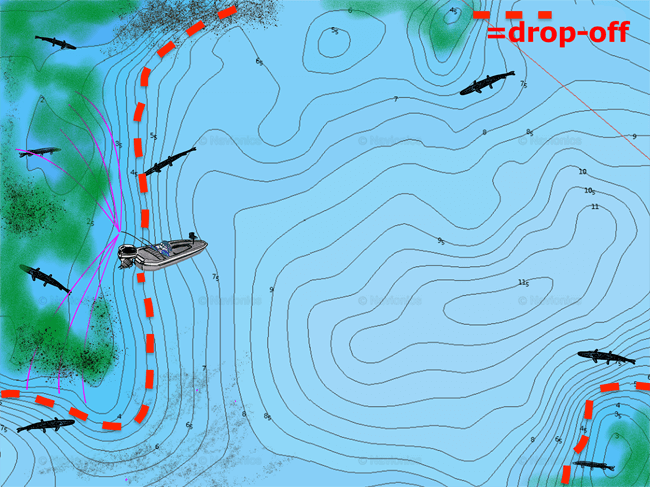
8. Where is the best place to fish for pike in rivers?
Of course, pike that live in rivers display similar behaviors to those that live in standing waters. They hunt the same prey, and they prefer to attack from an ambushing position. However, of course, their behavior differs in some aspects, as rivers differ substantially from standing waters.
Flowing water requires its inhabitants to make some special adaptations to their habitat. A river therefore does not generally provide a good habitat for pike, as they do not cope well with the current, as it counteracts their habitual way of hunting.
Sometimes it is also more difficult for river-dwelling pike to reach their spawning grounds — travelled distances of up to 30 mi (50 km) have been recorded. Furthermore rising and falling water levels can transform their habitat within a few days – or even hours.
The worst river swimmer – ever!
Well, the pike is not a terrible swimmer – but certainly not the best one in flowing water. To get an idea of its swimming ability agains the current, a few numbers might help:
At a flow velocity of 0.8 ft/s (0.25 m/s), a pike of about 10“ (50 cm) length swimming against the current needs about 10 minutes for a distance of 330 ft (100 m).
In a river pike therefore generally prefer the zones of lower water speed near the bank edges, obstacles or the ground. Many prey fish inhabit these areas and the vegetation also finds sufficient support to grow their roots.
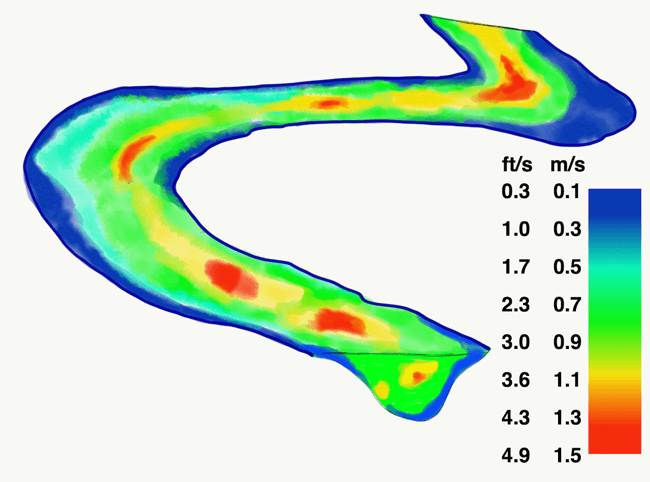
We know that the flow velocity in rivers can change even at short intervals. The picture above gives us a very good impression of this. The deep blue color indicates the optimal habitat for the pike where they can rest and hunt (about < 1 ft/s – 0.3 m/s). We ourselves were surprised how small this area can be.
This area (in particular in the river bends) therefore is the ultimate hotspot, if you want to catch a pike from the shore of a river. Of course, they also swim through sections with stronger currents, whereby the larger individuals can do better than the smaller ones. But generally, they don´t hunt in a stronger current, making them less susceptible to our baits.
9. The northern pike as a predator: How do they hunt and what is their preferred prey?
Pike hunt easy prey. Like any predator, it weighs the costs of an attack against the probabilities of success. That is the only way to save energy and to feed efficiently. To us, one pike is like another, but in reality, each specializes in different aspects. One may be more successful at attacking large prey fish, while others are better at attacking smaller ones.
9.1 The view has to be unobstructed
The eyes of the pike are optimally designed to spot prey, as they are essential for its hunting success. Unsurprisingly they hunt best, when they can clearly see their prey, as that allows them to estimate
- the distance,
- general circumstances
- and subsequently the probability of success.
Only once its instincts have concluded a positive outcome, the hunt begins. The pike must keep constant visual contact with its prey. Sometimes, it may attack very quickly. Other times, it pursues the prey over a longer time.
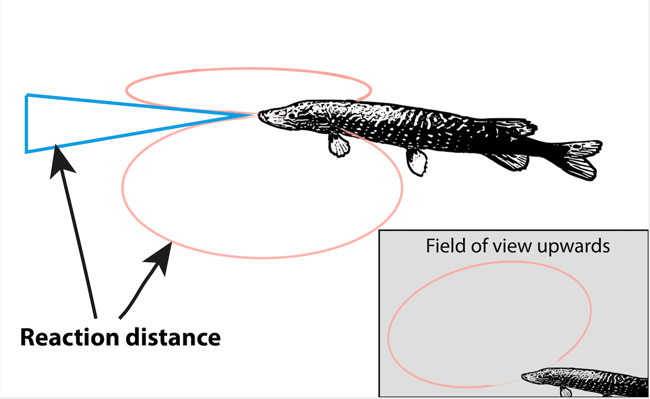
The pike has a broad field of vision created by its two eyes on each side of the head. It can detect even the tiniest movement in its vicinity.
In the area, where the vision overlaps, its eyesight becomes binocular – similar to our view. That means its eyes can see jointly and spatially classify an object. It can estimate depth and distance. Only with this sight, its instincts can optimaly calculate the attack.
9.2 Olfactory perception or sense of smell of a pike
Pheromones and other scents play an essential role in the water. With the help of these scents, fish can accurately determine their location in a water body. Among other things, they primarily serve for navigation. Fragrance traces are one reason why fish find their way back into certain waters.
The pike is therefore not only a visual predator. Nature has equiped it with other senses too. It can scent, for example, injured fish. These are easy prey, quasi a quick snack around the corner.
These scents are perceived by different odor receptors, not only by the nose. As the pike uses pheromones to locate and identify its prey, the worse the visibility in the water gets, the more important the sense of smell becomes.
9.3 The hunting process of a northern pike
Every hunt for prey follows the same pattern. The individual steps differ only in their duration.
- Without regard to the prey: The pike floats motionless in the water. Possible prey fish do not interest it.
- Attention to the prey: Its attention is shifting to the prey – the body is turning towards their direction. It observes but remains motionless.
- The pursuit of the prey: Depending on the prey and the situation, the pike starts the pursuit if necessary. Slowly and inconspicuously. It is focused entirely on the single fish or shoal.
- Sprint: The fins stand up and bring the body into position for a short but fast sprint. The instincts of the pike tell it exactly, when the right moment has arrived to launch its attack.
- The attack: Differs from prey to prey. For one prey, the pike attacks the head, for another the middle or rear. The attack ends when the prey has been caught – or the first sprint was unsuccessful.
- Failure: Not every attack ends with a success. Although the pike is a good and fast predator, there occur more failed attacks than you might think. On the one hand, this is due to the excellent defensive strategies of the prey fish. On the other, caused by the conditions of the environment.
- Back to step 2 or 3: If an attack was unsuccessful, either a chase ensues,
or the pike looks for another opportunity. The prey species and environment play a big role in deciding whether a second attack is launched. A pursuit and renewed attack depends mainly on the prey and whether the opportunity seems favorable.
The more a pike specializes in a prey, the better its odds.
Read more about how to catch a pike fast (in 10 minutes)!
-

Finding Fish The Smart Way – The Pike
Download 40 pages now for free
This article is an excerpt from:
Reviews ( 64 )
Martin
Hi Garry, i saw that contacting Jens has solved your problem. As written in the Order Mail, download is limited to 3 times. We introduced the limit to prevent fraud. However, if you lose your eBook in the future, please email us and you will of course get new downloads. Martin- Rated 1 out of 5
Garry Gregg
I bought the book online, but try as I might it would not save on my iPad mini 3, from the small amount i was able to read it looked very good. I was given a link that was promised to ALWAYS be available to me, but this was not the case! I wanted to learn how to find Pike in Lough Neagh, the largest lake in the U.K. but I can only fish it blind, useless. Make sure you can save this book BEFORE you buy. - Rated 5 out of 5
Andreas Eden
Unlike other reviewers, I am NOT in favor of shortening or streamlining. The detailed but not generalized aspects provided are scientifically sound and outline the respective topics exceedingly well. Looking forward to more of this, and keep up the great work! Martin
Hi Claus, Thank you for the info about the Tolino. So far, there have been no problems with the popular Android or Apple smartphones and tablets. We’ll take a look at it. Did the upload via the Tolino web reader not work either? Regards Martin- Rated 2 out of 5
Claus Erhard
The content is decent – maybe a little too detailed. Note: I bought the e-book version. The fact that you can’t print it out is alright (this option would be great though). However, I cannot read the PDF file on my Tolino. I uploaded it 1000 times, and nothing is displayed. So reading is only possible on the PC. Too bad! - Rated 5 out of 5
Dieter Gundacker
Highly recommended, lots of fascinating information. It is not easy to put the book down once you have started reading. - Rated 5 out of 5
Kurt Sattler
Great book. I also have “The Pikeperch”. Both are highly recommended. - Rated 5 out of 5
Mirko
A very well written book. - Rated 4 out of 5
Holzblinker
Among the advantages: -statistics and their interpretation -written in a simple and understandable way Among the disadvantages: -advertising -A lot of generally known information - Rated 3 out of 5
Bruno
Exciting content (****) with a tendency to be long-winded (**) - Rated 5 out of 5
Stefan
The book keeps what it promises. An all-around great book that stands out from the rest. The purchase was worth it! - Rated 5 out of 5
Fischfreund
A truly superb book. I also own the book on pikeperch and have to admit that they are two completely different books. There are very few overlaps, so I never had the feeling that I already knew a passage in the book. For this reason, I can unreservedly recommend the pike book. It was so much fun reading it and gradually learning more about the pike. - Rated 5 out of 5
Paul KraUS
An elaborate approach to the behavior of the fish to conclude your fishing behavior, etc. I also like that other professional opinions are taken into account and partly questioned and analyzed. You can learn a lot to save the one or the other unsuccessful day. Thank you! - Rated 5 out of 5
barney1at
I am impressed with the book! I have read many books about fishing, and this was by far the best. It reflects not only the experiences and interpretations of the authors but uses scientific studies as a basis. Some of the findings knocked my socks off, e.g., the distance of attention of the pike. Strong recommendation for anyone who wants to improve their pike fishing skills! - Rated 5 out of 5
Michael Hügel
Sehr gutes Buch hat mir weitergeholfen das Leben des Hechtes zu verstehen. - Rated 5 out of 5
frankadam67
Sehr, sehr schönes Buch mit vielen Informationen! Nun muss ich nur noch alles in die Tat umsetzen! Danke für das gut ausgearbeitete Buch! - Rated 5 out of 5
Thomas Asamer
Bin gerade am Lesen des Buches. Sehr interessant und informativ. Werde meine Hechtfänge sicherlich noch um einiges steigern können mit dem KnowHow des Buches! Weiter so!? - Rated 5 out of 5
Andre Scholz
Hallo Zusammen, ich kann nur sagen, das habt ihr wirklich sehr gut gemacht! Wahnsinnig informativ, Super gegliedert und mit vielen guten Tipps behaftet. Das Zanderbuch war schon ein Knaller!!! Ich freu mich schon auf das Barschbuch. Und nebenbei erwähnt, die Videolektionen Köderkurs 1 sind ebenfalls Mega spannend! Bitte weiter so machen…. Petri Andre - Rated 5 out of 5
Manfred Parbs
Ich finde die Bücher ” Der Hecht ” sowie ” Der Zander ” sind für erfahrene Angler und auch für den Anfänger sehr lehrreich und somit auch informativ gestaltet. Auch die vielen Tips haben mich persönlich schon so manches mal vor einem Schneidertag bewahrt. Ich besitze zudem auch noch das Buch ” Der grosse Echolotratgeber ” . Dieses Buch liefert gute Erklärungen für die Funktionen und Einstellungen von Echoloten. Desweiteren besitze ich auch noch zwei Angelkurse: zum einen Köderfarbe und zum anderen Der Deeper. Beide Kurse sind mit sehr viel Informationen und verständlichen Erklärungen gespickt die jederman sehr gut verstehen kann. Freue mich schon auf weitere Bücher. Ein grosser Dank als auch ein grosses Lob an das Fischfinderteam. Petri Heil & immer dicke Fische Manfred Parbs - Rated 4 out of 5
Fabius Voigt
Klasse Buch! Fundiertes Wissen auf gute Art und Weise zusammengefasst und übermittelt, damit Angler ihren Zielfisch besser verstehen. An einigen Ecken im Buch, wäre ein weitere genauere Ausarbeitung toll gewesen (wurde vom Autor aber selbst bemerkt und begründet). Desweiteren beruhen die meisten Angaben (90%) von Hechten aus Seen und leider nur sehr wenig aus Flüssen. Das sind meiner Meinung nach die einzigen Sachen die fehlen, aber ansonsten würde ich es als Bereicherung für jeden Angler beschreiben! - Rated 5 out of 5
Julia
Genau wie das Zanderbuch wieder der totale Hammer! Wobei für mich die Voraussetzungen etwas anders waren: Während ich meine Zanderfänge wirklich mal dringend etwas ankurbeln musste, fing ich alleine im vorigen Jahr 47 Hechte, es ging hier also eher um Optimierung. Und das ist voll gelungen! Massen von überaus hilfreichen Forschungsergebnissen, Statistiken und Tafeln. Ich bin beim Spinnangeln bisher zu viel gewandert und habe die einzelnen Spots zu kurz beangelt, das weiß ich jetzt. Und so ganz nebenbei ist mir jetzt noch klar, weshalb man in einigen durchaus interessanten Seen in meiner Umgebung von Juni bis Januar partout keinen Fisch fängt. Habe nämlich so einiges über die Schichtung gelernt, und dass eine Abkühlung eben nicht automatisch gleich Verbesserung bedeutet. Klasse! Her mit dem nächsten Buch bitte! - Rated 5 out of 5
Pascal Schlenker
Top nicht das letzte Buch für mich…. - Rated 5 out of 5
Heinz-Otto Schoel
Auf den 50zig Seiten, die ich bis jetzt gelesen habe ,bin ich begeistert. Aber die anderen Bücher über das Echolot und dem Zander waren sehr lehrreich. Weiter so. Freue mich schon auf das Barschbuch. - Rated 5 out of 5
Andreas Hillers
Modernes Fischen – Der Hecht. Ein sehr gut geschriebenes Buch. Bin begeistert von den vielen tollen Hilfestellungen. Sogar als erfahrener Angler kann hier bestimmt jeder noch den ein oder anderen Tipp für sich nutzen. Vielen lieben Dank, und weiter so für vielleicht weitere noch nicht erschienene Bücher über den Aal, Barsch, Karpfen etc. - Rated 5 out of 5
Stephandargel
Das Buch ist einfach nur klasse super beschrieben sehr verständlich beschrieben kann ich nur weiter empfehlen ? gebe dem Buch und dem Autor ne 1+ - Rated 5 out of 5
Rolf Wilde
Sehr praxisnah und auch mit viel Hintergrundinformationen gefülltes Buch. Ich habe über die Feiertage die ersten Seiten verschlungen. Sehr viele Details die ich noch bis zur Schonzeit versuche umzusetzen. - Rated 5 out of 5
Blankmaster
Die Referenz. Umfassend, kein blabla, über den Tellerrand hinausschauend, fundiert, sinnvolle und gut gemachte Graphiken, und das Ganze zu allem Überfluss auch noch unterhaltsam geschrieben. Als bekennender Wenigleser habe ich das Buch innerhalb von 3 Tagen einmal komplett durchgelesen. Uneingeschränkte Kaufempfehlung. - Rated 5 out of 5
Rudolf Knopf
Endlich ein Buch, welches man durchaus als Fachliteratur beschreiben kann. Es werden viele Erfahrungen, welche ich beim meiner Suche nach dem Hecht gemacht habe, bestätigt. Ebenso ist auch sehr viel Neues für mich in dem Buch, was ich bisher in meiner vieljährigen Anglerlaufbahn so nicht gewust habe. Absolute Kaufempfehlung. - Rated 5 out of 5
markus s
Großes Kompliment zum Buch! Ich fische seit meiner Kindheit auf Hecht (und das sind schon mehr als dreißig Jahre) und ich muss sagen, es gibt keine interessantere Lektüre zum Hecht! Viele eigene Theorien finde ich hier bestätigt, aber noch besser: Dieses Buch bietet auch wirklich neue Ansätze! - Rated 5 out of 5
Mitja
Beeindruckende Leistung von Euch, ein so komplexes Thema derart runterzubrechen, daß man das Buch in einem Rutsch durchlesen kann, ohne sich dauernd zu fragen: „verdammt, wovon labern die denn da?“ Superspannend: die Trophieklassifizierung und die Sache mit der Sprungschicht! Ich sehe meine Gewässer jetzt mit ganz anderen Augen und auf einmal kommen mir die 150 Kracher für das Anaconda-GTM gar nicht mehr so übertrieben teuer vor! Und weil es mir so gut gefallen hat, zieh ich mir morgen direkt das Echolot-Buch rein, das mit der Postbote heute morgen in den Kasten geworfen hat….für das Barschbuch hätte ich übrigens gerne einen Gutscheincode 🙂 Danke! Ich freu mich auf weitere spannende Lektüre aus eurem Stall… - Rated 5 out of 5
schoenfeld.oli
Absolut feine Lektüre. Ich gehe nach Lesen des Buches ganz anders ans Wasser. Zwischendrin etwas fader Stoff, der aber einfach dazu gehört. Dafür sind die spannenden Themen so spannend, dass ich nicht im Sitzen lesen konnte. - Rated 5 out of 5
Robert Häusler
Die beiden Autoren Martin Jacobs und Jens Biegemeier sind der Hammer. Ich habe schon viel gut recherchierte Medizinbücher gelesen und oft haben sie mir zu mehr Erfolg verholfen, dass das auch mal Zum Hechtangeln möglich wird ist großartig. Danke an dieses Meisterwerk! Ich habe mit dem Wissen aus dem Buch jetzt schon meinen Angelrekord auf Hecht gebrochen und bin mir sicher da geht noch was. Danke für eure Arbeit, den Fleiß und die Begeisterung die ihr geleistet haben müsst dieses moderne Fische finden für uns und unsrer Seekrokodiele zu ermöglichen. Petri Robert Häusler Martin
Edi, wir danken Dir und wünschen euch gute Fänge. Petri Martin vom Fischfindertestteam- Rated 5 out of 5
Edi Brader
Das beste Buch über die Fischerei auf Hecht, das ich bisher in Händen gehalten habe! Sehr ausführlich und praxisnah wird dem Einsteiger in diese Fischerei veranschaulicht worauf es ankommt und auch der eingefleischte Hechtprofi kann noch sehr viel Nützliches aus diesem Buch herausholen! Absolut EMPFEHLENSWERT! Besonders möchte ich das äußerst nette Team loben! Bei meiner Bestellung ging etwas schief, ich bekam zwei anstatt nur einer Ausgabe. Nach Rücksprache bedankten sie sich für die Information und sagten mir, dass das Zurücksenden ohnehin zu teuer wäre und ich das zweite Exemplar auch behalten dürfte. Danke Jungs, ihr habt gerade einem befreundeten Jungangler eine große Freude gemacht, ich werde euch auf jeden Fall weiterempfehlen! Macht weiter so! Petri Heil Edi Brader - Rated 5 out of 5
lusox
Prima Lektüre , wirklich zu empfehlen ! Besonders gut fand ich das Kapitel mit der Ködergröße. Ebenso das Kapitel mit den Standplätzen und die Rolle der Vegetation Ich habe viele Anregungen daraus mitgenommen und bin mal gespannt wie sich meine Hechtfänge verbessern. Weiter so ! - Rated 5 out of 5
Stefan Fischer
Ich finde, das Buch “Der Hecht” lüftete viele Geheminisse. Hatte das Buch “Der Zander” auch, alles top tock. Hoffentlich folgt das Buch auch über den Barsch, evtl. Waller/Wels. Mir fehlt die Anglerpraxis. Das Buch “Das große Echolot” ist auch klasse. Weiter studieren!!! ^^ Namaste und Petri Fischer Stefan - Rated 5 out of 5
Lasse Wiedenhöft
Wie schon beim Zanderbuch werden für alle denkbaren Situationen (Jahreszeiten, Gewässer, Wetter etc.) hilfreiche Tipps zur Strategieverbesserung gegeben. Dabei helfen die Ergebnisse aus diversen Versuchen und Tests den Hecht und sein Verhalten besser zu verstehen. Gerade die wissenschaftliche Begleitung in Kombination mit eigenen Erfahrungen hat mir schon nach wenigen Kapiteln neue Ideen vermittelt! - Rated 5 out of 5
Johann Burgstaller
Wie bereits “Der Zander”, ist auch die Hechtausgabe wieder jeden Cent wert. Ein must-have für jeden Raubfischangler. Tolle Studien, jede Menge neue Erkenntnisse und enifach zu lesen. Na dann nichts wie auf zum “Der Barsch”! - Rated 5 out of 5
Barschhunter
Das Buch ist Euch wirklich super gelungen!!!!! Es ist sehr informativ und es ist für jeden etwas dabei, ob man nun Anfänger im Angeln ist oder ein erfahrener Angler ist. Man kann immer noch was dazu lernen. Für mich persönlich war das Kapitel “Jagd und Beute” sehr interessant und spannend und möchte deswegen keine einzelnen Punkt hervorheben. Macht weiter so und ich freue mich schon auf Euer nächstes Buch “Modernes Fische Finden Der Barsch” mein persölicher favorite Fisch. Dickes Petrie Barschhunter - Rated 5 out of 5
Andre Scholz
Genauso spannend und aufschlussreich wie das Zander Buch! Wenn man seinen Zielfisch besser verstehen möchte und mehr Erfolg haben will, kommt man nicht um das Buch herum! Allein die Thematik um die Wassertemperaturen, einfach irre! Volle 5 Sterne und Danke für so viel geilen Input! Petri Andre - Rated 5 out of 5
Andreas F.
Sehr schön finde ich die Aufmachung des Buches und die logisch aufbauenden Kapitel. Das Lesen macht viel Spaß. Hier treffen die Autoren genau den richtigen Ton, einen “mitzunehmen”, obwohl die Grundlagen ja wissenschaftlich/biologisch sind. Es ist nicht einfach, plausibel und allgemein verständlich, verschiedene wissenschaftliche Erkenntnisse miteinander zu verknüpfen und hieraus die passenden Schlussfolgerungen zu ziehen. Das ist jedoch durchaus gelungen. Abläufe in der Natur sind nie statisch sondern unterliegen Abweichungen, es gibt aber Tendenzen. Deshalb kann es nicht immer genaue Gesetzmäßigkeiten geben. Hierauf weist das Buch in verschiedenen Kapitel immer wieder hin. Hier hätte ein grundlegender Hinweis in der Einleitung m.e. jedoch ausgereicht. Randnotiz: Ein Absatz erscheint wortgleich an zwei Stellen (S. 11, 1.Abs. und S. 15 3. Abs.). Im Ergebnis ist es ein Buch, was sogar enthusiastischen Raubfischanglern richtig weiterhilft! Meine Erwartungshaltung wurde sogar übertroffen. Ich freue mich auf euer Barschbuch! Vielen Dank! - Rated 5 out of 5
Pascal Kreutzmann
Wie die beiden Bücher zuvor hat mich auch das Buch über den Hecht mal wieder total begeistert. Unglaublich was ihr für einen Aufwand betreiben müsst um all dieses Wissen und die Studien zusammen zu tragen. Besonders interessant fand ich zb. die Frage danach wieviele Hechte sich denn in so einem Gewässer aufhalten. An wievielen Fischen man vorbei angelt. Das war echt interessant. Ebenso die Standplätze der Fische zu den verschiedenen Jahreszeiten und wie sehr vieles von der Wassertemperatur abhängt finde ich sehr Aufschlussreich. Auch über das fressen und gefressen werden kann man einiges erfahren. Jetzt ist mir klar warum der Hecht die Beute am liebsten am Kopf packt und sie möglichst schnell verschlingen muss. Tja die Themenvielfalt ist echt groß. Was mich noch interessiert hätte….wie/was sieht der Hecht durch seine Augen ? Was für Farben nimmt er wahr etc ? Aber das wäre eventuell zu speziell ?! Freue mich auf das nächste Buch! Bloß nicht nachlassen und genauso ausführlich weiter machen. Danke dafür. Ps…ich rezensiere aus Überzeugung , nicht wegen einem Gummifisch ! Grüße und Petri Pascal - Rated 5 out of 5
Ralf B.
Genauso interessant und prall gefüllt mit wertvollen Infos wie das Zanderbuch, einfach TOP! - Rated 5 out of 5
Bickes
Sehr gut strukuriert, sehr informativ, mir hat es definitiv geholfen, meine Taktik zu verbessern und selbstbewusster meine Stellen auszuwählen. - Rated 5 out of 5
opto
Habe alle 3 Bücher! Bin begeistert und dankbar!! Interessieren würde mich warum gerade der Hecht an einem Tag wie verrückt beißt und am nächsten Tag bei absolut gleichen Bedingungen am selben Ort wie ausgestorben erscheint! Interessieren würde mich auch wie der Zander als Augentier mit Sichtigkeiten unter 5cm klarkommt! (Hochwasser) Diese Fragen beschäftigen mich schon ein ganzes Anglerleben. - Rated 5 out of 5
Adrian Drzezla
Das Buch hat sehr viele Informationen über unseren Esox Lucius;). Jedes Kapitel ist sehr spannend und reichhaltig an Informationen. Nach diesem Buch habe ich meine Angelstrategie verbessern können und ich habe nun eine andere Ansicht von unserem Hecht im Wasser bekomme. Petri ! „ sehr empfehlenswert , Genau so wie die letzten Bücher von Fischfindertest“ - Rated 5 out of 5
Evgenij
Suuuper Buch, genau so wie das Zander Buch. Bin total begeistert. Sieht wie eine Doktorarbeit aus. Wissenschaftlich überprüft mit Verweisen, vielen Abbildungen und vielen praktischen Tips. Freue mich auf die neue Bücher! - Rated 5 out of 5
Daniel
Ich kann das Buch jedem Raubfischangler weiterempfehlen. Viele neue und nützliche Informationen rund um unseren Zielfisch Nr. 1. Tolle Arbeit! - Rated 5 out of 5
Jörg
Tolles Buch, hochinformativ von der ersten bis zur letzten Seite. Das Jahr des Hecht hat mir am besten gefallen. Man kann das Buch nur weiterempfehlen! - Rated 5 out of 5
Dirk Lindner
Top buch.umfangreich.logisch.sollte jeder haben.das Zander buch habe ich auch - Rated 5 out of 5
Jörg Thielke
Hoch interessant und verständlich geschrieben. In jedem Fall vollumfänglich weiterzuempfehlen. Danke Männers ? - Rated 5 out of 5
Stefan Klingbeil
Es war nicht anders zu erwarten. Nach dem Zander Buch bin ich wieder voll zufrieden.Die Bücher unterscheiden sich von anderen Büchern und Artikeln aus Zeitschriften. Mehr input brauch ich nicht. Alles erklärt und vernünftig erklärt. Ich lese wirklich nicht gerne Bücher. Aber hier ist es wie ein guter Krimi. Man kann nicht aufhören. Wir haben es alle gelesen und Diskutieren unser Wissen zusammen um es nochmal zu vertiefen. Jetzt freuen wir uns auf Der Barsch ? - Rated 5 out of 5
Jörg Rolle
Ein sehr gutes Buch so wie ich es erwartet habe nach dem ich Euer Zander-Buch gelesen habe. bin begeistert viele Tipps in Jagd und Beute,Umweltfaktoren,Lebensräume Kapitel 5.2.2 und Das Jahr des Hechtes.Habe noch nicht viel Erfahrung Hecht angeln ,das Buch hat mir viel Wissen übermittelt auch wenn ich noch nicht alles gelesen habe. Danke weiter so Petri - Rated 5 out of 5
Philipp
Kurz und knapp, Top! Wie auch bereits im Buch “Modernes Fische finden Der Zander” erneut abgeliefert. Besten Dank, macht weiter so! - Rated 5 out of 5
Ben
Glaube ich hab gerade vergessen die Sterne zu drücken! Auf jeden Fall 5 Sterne da es super verständlich geschrieben ist! Es beschreibt das Verhalten der Fische in verschiedenen Situationen und wenn man das versteht und nutzt fängt man sicher bald besser! Auch die Grafiken und Bilder vereinfachen es sehr gut. Bin sehr zufrieden und hoffe das noch eins für Barsche und Wels kommt! ?? - Rated 5 out of 5
Nico Drabner
Volle Punktzahl ?? Ein dickes Lob. Sehr schön aufgebaut. Am besten hat mir die Gewässeranalyse und die Aussage mit der Wassertemperatur gefallen, das passt zu 100% und Danke an den vielen nützlichen Tipps - Rated 5 out of 5
Kuhnert Giso
Also ich habe schon das Buch vom Zander gelesen. Und auch dieses Buch vom Hecht ist sehr Lehrreich mit vielen interessanten Kapiteln.. Ich bin noch nicht ganz durch mit dem lesen, aber ich weiß das es toll ist und mir auf alle Fälle weiter helfen wird um den ein oder anderen Hecht mehr an den Haken zu bekommen. Ich empfehle es auf alle Fälle weiter.. Und auch das nächste Buch über den Barsch werde ich mir holen. Macht weiter so fünf Sterne gibt’s vom mir. LG Giso - Rated 5 out of 5
David Götze
Hallo zusammen, ich habe mittlerweile alle 3 Bücher und kann ehrlich behaupten, dass es mir beim Angeln bzw. Fische finden sehr viel gebracht hat. Vorallem das Angeln unter Einfluss der Mitwelt (Wind, Temperatur…etc) lässt mich jetzt meine Spotwahl genauer überdenken. Vielen Dank dafür und ich freu mich schon auf den Barsch ^^ Petri David - Rated 4 out of 5
Peter
absolute Empfehlung - Rated 5 out of 5
Ben
Finde das Buch sehr gut! Genau wie das Zander Buch beschreibt es worauf es ankommt… das Verhalten der Fische in verschiedenen Situationen. Es ist verständlich erklärt und die Bilder und Grafiken machen es noch einfacher zu verstehen worauf es ankommt! Weiter so! Barsch und Wels können kommen? - Rated 5 out of 5
Kantor Alfred (Hatschi)
Ich habe viele Jahre viel Zeit verschwendet weil ich den Fisch nicht immer gefunden habe, dass Buch hilft wirklich die Fische zu finden. Ich habe es nicht nur gelesen sondern auch schon teilweise am Wochenende umgesetzt und das mit Erfolg (einige schöne Hechte), vielen dank ich freue mich auf euer nächstes Werk Der Barsch. Weiter so!!! Petri Heil Hatschi - Rated 5 out of 5
Patrick
Also ich muss jetzt mal eine Lanze brechen, es gibt doch noch qualitativ hochwertige Bücher zum Thema Fisch und dann noch direkt zum Thema Hecht, in einer Qualität die ihres gleichen sucht. Selten das ich derart im „Rausch“ ein Buch gelesen habe. Hut ab und weiter so. - Rated 5 out of 5
Tacklefever
Ich war sehr positiv überrascht. Der Anfänger erhält im ersten Teil des Buches wirklich brauchbares Basiswissen vermittelt. Und der ein oder andere Profi wird vielleicht sagen: “Mache ich doch immer so”. Und das ist doch das beste Lob für den ersten Teil des Buches. Aber wenn der Profi ehrlich ist, kann er wahrscheinlich schon zugeben, das ein oder andere gefunden zu haben was er vergessen hatte oder doch noch nicht wusste. Und richtig spannend für Anfänger und Profi ist der Hautteil des Buches, das Kapitel “Jahr des Hechtes”. Dieser Teil hat absolut zu Recht den meisten Platz im Buch bekommen. Bei den einfach gegliederten und nachvollziehbaren Abschnitten im Jahr des Hechtes findet sicher nicht nur der Anfänger sondern auch der Profi jede Menge tolle Infos. Meine volle Buchbesprechung findet ihr unter https://www.tacklefever.de/index.php?topic=7396.0 - Rated 5 out of 5
Andreas
Wie erwartet, ein sehr gutes Buch das nicht in dem Köderwahnsinn hinterherläuft. Besonders gut gefällt mir die Analyse der Wassertemperaturbereiche passend für meine großen See in Mecklenburg. Die Gewässeranalysen passen wie die Faust auf Auge auf dieses sehr große Gewässer. Die neuen Möglichkeiten und überragenden Fänge von einigen lokalen Guides erzielt werden, welche in Großen Teilen durch die gewaltigen Technologiesprünge im Echolotbereich und Bootsnavigation begründet sind, wurde hier sehr gut zusammengefasst. Eine Pflichtlektüre für jeden der sich an die großen Gewässer mit den noch größeren Fische wagen will. Definitiv 5 Sterne, das Buch wurde auch innerhalb von 2 Nachmittagen gelesen. Danke! - Rated 5 out of 5
Wolfgang Konter
Habe das Buch heute bekommen .Dafür erstmal ein großes Danke schön an Euch . Nach dem ersten Durchblättern war ich begeistert . Habe eigentlich auch nichts anderes erwartet . “Modernes Fische finden – Der Zander” habe ich ja schon lange durch und blättere immer wieder drin rum . Beide Bücher zeugen von viel Sachverstand und Erkenntnissen , die ich so nicht erwartet hätte . Einfach super und verständlich erklärt . Jetzt will ich nur hoffen , dass noch ein Barsch Buch auf dieses Duo folgt . Petri Heil Wolfgang Konter - Rated 5 out of 5
Catchmaster
Habe das Buch heute direkt durchgelesen. Es ist gut aufgebaut und es gibt viele nützliche Tip’s. Anfang Mai waren wir in Schweden auf Hecht angeln. Schade, dass ich dieses Buch nicht schon vorher hatte. Aufgrund der neuen Erkenntnis hätte ich bestimmt mehr Erfolg gehabt. An sich ein super Buch. Werde jetz die Tip’s in die Praxis umsetzen. Vielen Dank für dieses Buch. - Rated 5 out of 5
Jörg Rolle
Habe das Buch Heute erhalten und sofort durchgestöbert,bin Begeistert! Sehr schöne Aufmachung, gut Gegliedert und nicht zu wissenschaftlich so das es jeder Angler verstehen kann.Habe auch schon Kapitel gefunden die mir reichlich neues und gute Tipps für meine Angelpraxis gefunden. Weiter so!!!!!!! Petri Jörg Rolle
10. Which is the best strategy to catch a northern pike?
The are two scenarios that require different fishing tactics.
- An active pike is easier to catch than an ambushing one. Those that move are a lot more likely to cross paths with our baits. Also, active pike will have to feed more as their calorie consumption is higher. And one who is feeding more is also easier to hook.
- With an ambushing pike, things look different. It does not chase after every prey. It leverages its hiding spot and camouflage. It remains motionless in its hiding spot for long periods of time, waiting for the right prey and moment. Therefore, we have to get our bait as close as possible in front of him – and in addition make it enticing. The ambushing pike must see it as an easy prey. Let the bait rest from time to time as you reel it in.
The good thing is that an ambushing pike stays in one spot. To reach his spot with our bait, we should not approach without a plan. If you just cast your bait randomly, you will most certainly miss the motionless predator, as we can´t tempt him from its hiding spot with this strategy. That is more of a strategy for an active pike.
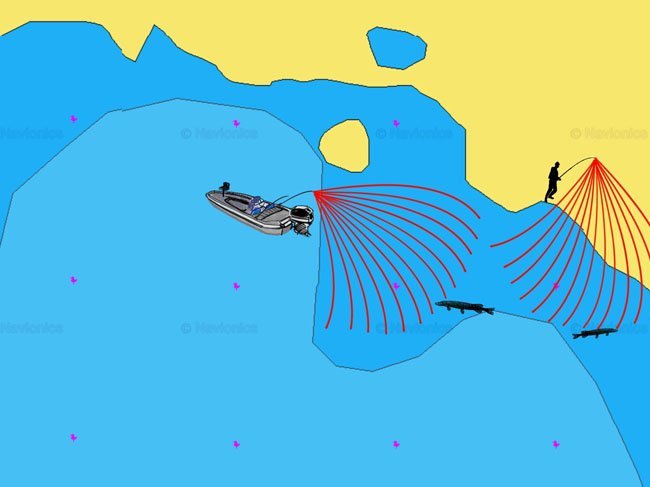
Our best chance to hook this elusive predator in this case is to strategically fish the area. You start to cast at twelve o‘clock and work your way clockwise, cast after cast. Since we do not know how deep the pike is staying, it is not easy to pick the right bait.
11. What is the best bait for pike fishing?
Thinking about the different seasons of the year for pike fishing, we have to choose different bait strategies in all of these.
11.1 Spring
Firstly, the chance of catching big pike is biggest in spring, when most other fish start to reproduce. By then, the pike spawning process is long over. Eye-catching lures that stand out among the thousands of spawning fish are essential at this time of year.
Since pike are mostly located in shallow areas of the water, it doesn’t matter if the lures are green, yellow red, or just mixed in colors, as almost all colors stand out, if the water is not very deep. It is only important to use exclusively colors that pike actually can see.
11.2 Autumn or fall
This season also offers great opportunities for pike fishing. At a water temperature of 10 – 17°C pike are most active and feed a lot to produce fat for the winter.
Fish, frogs, rats – all the pike baits you have, can be tried. The important thing is that the baits at this time of year may be rather big than small. You do not need to be afraid of 30 cm long baits.
Pike are specialized in their hunt for certain prey fish and normally focus on only one or two prey species – which two exactly varies over the year. They know exactly how to best ambush and attack their prey. If your bait falls into the pike‘s scheme, this is a big advantage. For this reason, a basic understanding of water as a habitat for the pike as well as its prey is fundamental.
Very important in this aspect is the underwater visibility, which varies between the different trophic states. A change in visibility forces the pike to adapt its hunting strategy. The clearer the water, the more visible the prey is. In this context, the appearance of the bait matters most. On the other hand, in murky waters, the outline and vibration of the bait take a leading role – and in turn appearance plays a less significant role.
Remember: The pike is an efficient predator and adapts its hunting strategy between prey fish. We should remember this when choosing our bait. The pike knows to distinguish between a perch, a roach or minnow flees – and adapts its hunting strategy accordingly. In the case of unknown prey, it does not instinctively know how to react. We therefore conclude that an unknown prey will get one pike curious while leaving another unimpressed.
Without vegetation, the composition of the soil inhabitants also changes. Fish that feed on plants and microorganisms find less food and are less numerous. Their numbers inevitably decrease. Other species use the unlimited zooplankton as a new food source.
These changes can occur sporadically throughout the year or can be long-lasting. All this has temporary or permanent effects on predators such as the pike. It must adapt to the changing conditions and adjust to other prey. So, if you are using the same bait all year round, you are ignoring that life underwater is in constant flux.
11.3 Pike baits for clear water
In clear and nutrient-poor (oligotrophic) water, only a few whitefish can be found. That has a big impact on the prey selection of the pike. It includes vendace, trout, european smelt, zander and perch. Here, „predators hunt predators“ is the rule.
Take this into account when choosing your bait and go for one that imitates predators. Medium-sized pike concentrate in the few larger shore zones. The big ones prefer open water. The pike population itself is usually not very large, as there are only a few small shore areas for the young individuals. Cannibalism is rare when enough other predators are available as prey. If they are missing, the larger pike start to hunt for the smaller ones.
11.4 Pike baits for turbid water
Hunting is challenging for pike in eutrophic waters, as the visibility is often very turbid – and moreover varies over the course of the year. That influences the hunting behavior of predatory fish to varying degrees. At lower visibility, the pike must rely on senses other than its eyes.
- The olfactory sense,
- hearing
- as well as the lateral lines
gain in importance. For us, this means that pressure-wave and sound-generating baits should be the first choice.
Eutrophic lakes are often shallow and moreover show lush vegetation in its shallower areas. There is an abundance of pike so that
- cannibalism,
- food competition
- and even the defense of territory
cause them to collide. We must be conscious of the relationship between the trophic state and the pike‘s population size, behavior, and prey.
Note: It appears to be necessary to hold the bait in the pike‘s vision for as long as possible. But how can we ensure this? Simply try to reduce the speed at which you reel.
Many wobblers, blinkers and spinners are reeled in quickly. Lurking pike may not be attracted by baits that speed past them. If you cast heavy baits in shallow water, you will be forced to reel quickly as otherwise it will sink to the bottom. So we suggest using a bait that does not sink that easily.
-

Finding Fish The Smart Way – The Pike
Download 40 pages now for free
This article is an excerpt from:
Reviews ( 64 )
Martin
Hi Garry, i saw that contacting Jens has solved your problem. As written in the Order Mail, download is limited to 3 times. We introduced the limit to prevent fraud. However, if you lose your eBook in the future, please email us and you will of course get new downloads. Martin- Rated 1 out of 5
Garry Gregg
I bought the book online, but try as I might it would not save on my iPad mini 3, from the small amount i was able to read it looked very good. I was given a link that was promised to ALWAYS be available to me, but this was not the case! I wanted to learn how to find Pike in Lough Neagh, the largest lake in the U.K. but I can only fish it blind, useless. Make sure you can save this book BEFORE you buy. - Rated 5 out of 5
Andreas Eden
Unlike other reviewers, I am NOT in favor of shortening or streamlining. The detailed but not generalized aspects provided are scientifically sound and outline the respective topics exceedingly well. Looking forward to more of this, and keep up the great work! Martin
Hi Claus, Thank you for the info about the Tolino. So far, there have been no problems with the popular Android or Apple smartphones and tablets. We’ll take a look at it. Did the upload via the Tolino web reader not work either? Regards Martin- Rated 2 out of 5
Claus Erhard
The content is decent – maybe a little too detailed. Note: I bought the e-book version. The fact that you can’t print it out is alright (this option would be great though). However, I cannot read the PDF file on my Tolino. I uploaded it 1000 times, and nothing is displayed. So reading is only possible on the PC. Too bad! - Rated 5 out of 5
Dieter Gundacker
Highly recommended, lots of fascinating information. It is not easy to put the book down once you have started reading. - Rated 5 out of 5
Kurt Sattler
Great book. I also have “The Pikeperch”. Both are highly recommended. - Rated 5 out of 5
Mirko
A very well written book. - Rated 4 out of 5
Holzblinker
Among the advantages: -statistics and their interpretation -written in a simple and understandable way Among the disadvantages: -advertising -A lot of generally known information - Rated 3 out of 5
Bruno
Exciting content (****) with a tendency to be long-winded (**) - Rated 5 out of 5
Stefan
The book keeps what it promises. An all-around great book that stands out from the rest. The purchase was worth it! - Rated 5 out of 5
Fischfreund
A truly superb book. I also own the book on pikeperch and have to admit that they are two completely different books. There are very few overlaps, so I never had the feeling that I already knew a passage in the book. For this reason, I can unreservedly recommend the pike book. It was so much fun reading it and gradually learning more about the pike. - Rated 5 out of 5
Paul KraUS
An elaborate approach to the behavior of the fish to conclude your fishing behavior, etc. I also like that other professional opinions are taken into account and partly questioned and analyzed. You can learn a lot to save the one or the other unsuccessful day. Thank you! - Rated 5 out of 5
barney1at
I am impressed with the book! I have read many books about fishing, and this was by far the best. It reflects not only the experiences and interpretations of the authors but uses scientific studies as a basis. Some of the findings knocked my socks off, e.g., the distance of attention of the pike. Strong recommendation for anyone who wants to improve their pike fishing skills! - Rated 5 out of 5
Michael Hügel
Sehr gutes Buch hat mir weitergeholfen das Leben des Hechtes zu verstehen. - Rated 5 out of 5
frankadam67
Sehr, sehr schönes Buch mit vielen Informationen! Nun muss ich nur noch alles in die Tat umsetzen! Danke für das gut ausgearbeitete Buch! - Rated 5 out of 5
Thomas Asamer
Bin gerade am Lesen des Buches. Sehr interessant und informativ. Werde meine Hechtfänge sicherlich noch um einiges steigern können mit dem KnowHow des Buches! Weiter so!? - Rated 5 out of 5
Andre Scholz
Hallo Zusammen, ich kann nur sagen, das habt ihr wirklich sehr gut gemacht! Wahnsinnig informativ, Super gegliedert und mit vielen guten Tipps behaftet. Das Zanderbuch war schon ein Knaller!!! Ich freu mich schon auf das Barschbuch. Und nebenbei erwähnt, die Videolektionen Köderkurs 1 sind ebenfalls Mega spannend! Bitte weiter so machen…. Petri Andre - Rated 5 out of 5
Manfred Parbs
Ich finde die Bücher ” Der Hecht ” sowie ” Der Zander ” sind für erfahrene Angler und auch für den Anfänger sehr lehrreich und somit auch informativ gestaltet. Auch die vielen Tips haben mich persönlich schon so manches mal vor einem Schneidertag bewahrt. Ich besitze zudem auch noch das Buch ” Der grosse Echolotratgeber ” . Dieses Buch liefert gute Erklärungen für die Funktionen und Einstellungen von Echoloten. Desweiteren besitze ich auch noch zwei Angelkurse: zum einen Köderfarbe und zum anderen Der Deeper. Beide Kurse sind mit sehr viel Informationen und verständlichen Erklärungen gespickt die jederman sehr gut verstehen kann. Freue mich schon auf weitere Bücher. Ein grosser Dank als auch ein grosses Lob an das Fischfinderteam. Petri Heil & immer dicke Fische Manfred Parbs - Rated 4 out of 5
Fabius Voigt
Klasse Buch! Fundiertes Wissen auf gute Art und Weise zusammengefasst und übermittelt, damit Angler ihren Zielfisch besser verstehen. An einigen Ecken im Buch, wäre ein weitere genauere Ausarbeitung toll gewesen (wurde vom Autor aber selbst bemerkt und begründet). Desweiteren beruhen die meisten Angaben (90%) von Hechten aus Seen und leider nur sehr wenig aus Flüssen. Das sind meiner Meinung nach die einzigen Sachen die fehlen, aber ansonsten würde ich es als Bereicherung für jeden Angler beschreiben! - Rated 5 out of 5
Julia
Genau wie das Zanderbuch wieder der totale Hammer! Wobei für mich die Voraussetzungen etwas anders waren: Während ich meine Zanderfänge wirklich mal dringend etwas ankurbeln musste, fing ich alleine im vorigen Jahr 47 Hechte, es ging hier also eher um Optimierung. Und das ist voll gelungen! Massen von überaus hilfreichen Forschungsergebnissen, Statistiken und Tafeln. Ich bin beim Spinnangeln bisher zu viel gewandert und habe die einzelnen Spots zu kurz beangelt, das weiß ich jetzt. Und so ganz nebenbei ist mir jetzt noch klar, weshalb man in einigen durchaus interessanten Seen in meiner Umgebung von Juni bis Januar partout keinen Fisch fängt. Habe nämlich so einiges über die Schichtung gelernt, und dass eine Abkühlung eben nicht automatisch gleich Verbesserung bedeutet. Klasse! Her mit dem nächsten Buch bitte! - Rated 5 out of 5
Pascal Schlenker
Top nicht das letzte Buch für mich…. - Rated 5 out of 5
Heinz-Otto Schoel
Auf den 50zig Seiten, die ich bis jetzt gelesen habe ,bin ich begeistert. Aber die anderen Bücher über das Echolot und dem Zander waren sehr lehrreich. Weiter so. Freue mich schon auf das Barschbuch. - Rated 5 out of 5
Andreas Hillers
Modernes Fischen – Der Hecht. Ein sehr gut geschriebenes Buch. Bin begeistert von den vielen tollen Hilfestellungen. Sogar als erfahrener Angler kann hier bestimmt jeder noch den ein oder anderen Tipp für sich nutzen. Vielen lieben Dank, und weiter so für vielleicht weitere noch nicht erschienene Bücher über den Aal, Barsch, Karpfen etc. - Rated 5 out of 5
Stephandargel
Das Buch ist einfach nur klasse super beschrieben sehr verständlich beschrieben kann ich nur weiter empfehlen ? gebe dem Buch und dem Autor ne 1+ - Rated 5 out of 5
Rolf Wilde
Sehr praxisnah und auch mit viel Hintergrundinformationen gefülltes Buch. Ich habe über die Feiertage die ersten Seiten verschlungen. Sehr viele Details die ich noch bis zur Schonzeit versuche umzusetzen. - Rated 5 out of 5
Blankmaster
Die Referenz. Umfassend, kein blabla, über den Tellerrand hinausschauend, fundiert, sinnvolle und gut gemachte Graphiken, und das Ganze zu allem Überfluss auch noch unterhaltsam geschrieben. Als bekennender Wenigleser habe ich das Buch innerhalb von 3 Tagen einmal komplett durchgelesen. Uneingeschränkte Kaufempfehlung. - Rated 5 out of 5
Rudolf Knopf
Endlich ein Buch, welches man durchaus als Fachliteratur beschreiben kann. Es werden viele Erfahrungen, welche ich beim meiner Suche nach dem Hecht gemacht habe, bestätigt. Ebenso ist auch sehr viel Neues für mich in dem Buch, was ich bisher in meiner vieljährigen Anglerlaufbahn so nicht gewust habe. Absolute Kaufempfehlung. - Rated 5 out of 5
markus s
Großes Kompliment zum Buch! Ich fische seit meiner Kindheit auf Hecht (und das sind schon mehr als dreißig Jahre) und ich muss sagen, es gibt keine interessantere Lektüre zum Hecht! Viele eigene Theorien finde ich hier bestätigt, aber noch besser: Dieses Buch bietet auch wirklich neue Ansätze! - Rated 5 out of 5
Mitja
Beeindruckende Leistung von Euch, ein so komplexes Thema derart runterzubrechen, daß man das Buch in einem Rutsch durchlesen kann, ohne sich dauernd zu fragen: „verdammt, wovon labern die denn da?“ Superspannend: die Trophieklassifizierung und die Sache mit der Sprungschicht! Ich sehe meine Gewässer jetzt mit ganz anderen Augen und auf einmal kommen mir die 150 Kracher für das Anaconda-GTM gar nicht mehr so übertrieben teuer vor! Und weil es mir so gut gefallen hat, zieh ich mir morgen direkt das Echolot-Buch rein, das mit der Postbote heute morgen in den Kasten geworfen hat….für das Barschbuch hätte ich übrigens gerne einen Gutscheincode 🙂 Danke! Ich freu mich auf weitere spannende Lektüre aus eurem Stall… - Rated 5 out of 5
schoenfeld.oli
Absolut feine Lektüre. Ich gehe nach Lesen des Buches ganz anders ans Wasser. Zwischendrin etwas fader Stoff, der aber einfach dazu gehört. Dafür sind die spannenden Themen so spannend, dass ich nicht im Sitzen lesen konnte. - Rated 5 out of 5
Robert Häusler
Die beiden Autoren Martin Jacobs und Jens Biegemeier sind der Hammer. Ich habe schon viel gut recherchierte Medizinbücher gelesen und oft haben sie mir zu mehr Erfolg verholfen, dass das auch mal Zum Hechtangeln möglich wird ist großartig. Danke an dieses Meisterwerk! Ich habe mit dem Wissen aus dem Buch jetzt schon meinen Angelrekord auf Hecht gebrochen und bin mir sicher da geht noch was. Danke für eure Arbeit, den Fleiß und die Begeisterung die ihr geleistet haben müsst dieses moderne Fische finden für uns und unsrer Seekrokodiele zu ermöglichen. Petri Robert Häusler Martin
Edi, wir danken Dir und wünschen euch gute Fänge. Petri Martin vom Fischfindertestteam- Rated 5 out of 5
Edi Brader
Das beste Buch über die Fischerei auf Hecht, das ich bisher in Händen gehalten habe! Sehr ausführlich und praxisnah wird dem Einsteiger in diese Fischerei veranschaulicht worauf es ankommt und auch der eingefleischte Hechtprofi kann noch sehr viel Nützliches aus diesem Buch herausholen! Absolut EMPFEHLENSWERT! Besonders möchte ich das äußerst nette Team loben! Bei meiner Bestellung ging etwas schief, ich bekam zwei anstatt nur einer Ausgabe. Nach Rücksprache bedankten sie sich für die Information und sagten mir, dass das Zurücksenden ohnehin zu teuer wäre und ich das zweite Exemplar auch behalten dürfte. Danke Jungs, ihr habt gerade einem befreundeten Jungangler eine große Freude gemacht, ich werde euch auf jeden Fall weiterempfehlen! Macht weiter so! Petri Heil Edi Brader - Rated 5 out of 5
lusox
Prima Lektüre , wirklich zu empfehlen ! Besonders gut fand ich das Kapitel mit der Ködergröße. Ebenso das Kapitel mit den Standplätzen und die Rolle der Vegetation Ich habe viele Anregungen daraus mitgenommen und bin mal gespannt wie sich meine Hechtfänge verbessern. Weiter so ! - Rated 5 out of 5
Stefan Fischer
Ich finde, das Buch “Der Hecht” lüftete viele Geheminisse. Hatte das Buch “Der Zander” auch, alles top tock. Hoffentlich folgt das Buch auch über den Barsch, evtl. Waller/Wels. Mir fehlt die Anglerpraxis. Das Buch “Das große Echolot” ist auch klasse. Weiter studieren!!! ^^ Namaste und Petri Fischer Stefan - Rated 5 out of 5
Lasse Wiedenhöft
Wie schon beim Zanderbuch werden für alle denkbaren Situationen (Jahreszeiten, Gewässer, Wetter etc.) hilfreiche Tipps zur Strategieverbesserung gegeben. Dabei helfen die Ergebnisse aus diversen Versuchen und Tests den Hecht und sein Verhalten besser zu verstehen. Gerade die wissenschaftliche Begleitung in Kombination mit eigenen Erfahrungen hat mir schon nach wenigen Kapiteln neue Ideen vermittelt! - Rated 5 out of 5
Johann Burgstaller
Wie bereits “Der Zander”, ist auch die Hechtausgabe wieder jeden Cent wert. Ein must-have für jeden Raubfischangler. Tolle Studien, jede Menge neue Erkenntnisse und enifach zu lesen. Na dann nichts wie auf zum “Der Barsch”! - Rated 5 out of 5
Barschhunter
Das Buch ist Euch wirklich super gelungen!!!!! Es ist sehr informativ und es ist für jeden etwas dabei, ob man nun Anfänger im Angeln ist oder ein erfahrener Angler ist. Man kann immer noch was dazu lernen. Für mich persönlich war das Kapitel “Jagd und Beute” sehr interessant und spannend und möchte deswegen keine einzelnen Punkt hervorheben. Macht weiter so und ich freue mich schon auf Euer nächstes Buch “Modernes Fische Finden Der Barsch” mein persölicher favorite Fisch. Dickes Petrie Barschhunter - Rated 5 out of 5
Andre Scholz
Genauso spannend und aufschlussreich wie das Zander Buch! Wenn man seinen Zielfisch besser verstehen möchte und mehr Erfolg haben will, kommt man nicht um das Buch herum! Allein die Thematik um die Wassertemperaturen, einfach irre! Volle 5 Sterne und Danke für so viel geilen Input! Petri Andre - Rated 5 out of 5
Andreas F.
Sehr schön finde ich die Aufmachung des Buches und die logisch aufbauenden Kapitel. Das Lesen macht viel Spaß. Hier treffen die Autoren genau den richtigen Ton, einen “mitzunehmen”, obwohl die Grundlagen ja wissenschaftlich/biologisch sind. Es ist nicht einfach, plausibel und allgemein verständlich, verschiedene wissenschaftliche Erkenntnisse miteinander zu verknüpfen und hieraus die passenden Schlussfolgerungen zu ziehen. Das ist jedoch durchaus gelungen. Abläufe in der Natur sind nie statisch sondern unterliegen Abweichungen, es gibt aber Tendenzen. Deshalb kann es nicht immer genaue Gesetzmäßigkeiten geben. Hierauf weist das Buch in verschiedenen Kapitel immer wieder hin. Hier hätte ein grundlegender Hinweis in der Einleitung m.e. jedoch ausgereicht. Randnotiz: Ein Absatz erscheint wortgleich an zwei Stellen (S. 11, 1.Abs. und S. 15 3. Abs.). Im Ergebnis ist es ein Buch, was sogar enthusiastischen Raubfischanglern richtig weiterhilft! Meine Erwartungshaltung wurde sogar übertroffen. Ich freue mich auf euer Barschbuch! Vielen Dank! - Rated 5 out of 5
Pascal Kreutzmann
Wie die beiden Bücher zuvor hat mich auch das Buch über den Hecht mal wieder total begeistert. Unglaublich was ihr für einen Aufwand betreiben müsst um all dieses Wissen und die Studien zusammen zu tragen. Besonders interessant fand ich zb. die Frage danach wieviele Hechte sich denn in so einem Gewässer aufhalten. An wievielen Fischen man vorbei angelt. Das war echt interessant. Ebenso die Standplätze der Fische zu den verschiedenen Jahreszeiten und wie sehr vieles von der Wassertemperatur abhängt finde ich sehr Aufschlussreich. Auch über das fressen und gefressen werden kann man einiges erfahren. Jetzt ist mir klar warum der Hecht die Beute am liebsten am Kopf packt und sie möglichst schnell verschlingen muss. Tja die Themenvielfalt ist echt groß. Was mich noch interessiert hätte….wie/was sieht der Hecht durch seine Augen ? Was für Farben nimmt er wahr etc ? Aber das wäre eventuell zu speziell ?! Freue mich auf das nächste Buch! Bloß nicht nachlassen und genauso ausführlich weiter machen. Danke dafür. Ps…ich rezensiere aus Überzeugung , nicht wegen einem Gummifisch ! Grüße und Petri Pascal - Rated 5 out of 5
Ralf B.
Genauso interessant und prall gefüllt mit wertvollen Infos wie das Zanderbuch, einfach TOP! - Rated 5 out of 5
Bickes
Sehr gut strukuriert, sehr informativ, mir hat es definitiv geholfen, meine Taktik zu verbessern und selbstbewusster meine Stellen auszuwählen. - Rated 5 out of 5
opto
Habe alle 3 Bücher! Bin begeistert und dankbar!! Interessieren würde mich warum gerade der Hecht an einem Tag wie verrückt beißt und am nächsten Tag bei absolut gleichen Bedingungen am selben Ort wie ausgestorben erscheint! Interessieren würde mich auch wie der Zander als Augentier mit Sichtigkeiten unter 5cm klarkommt! (Hochwasser) Diese Fragen beschäftigen mich schon ein ganzes Anglerleben. - Rated 5 out of 5
Adrian Drzezla
Das Buch hat sehr viele Informationen über unseren Esox Lucius;). Jedes Kapitel ist sehr spannend und reichhaltig an Informationen. Nach diesem Buch habe ich meine Angelstrategie verbessern können und ich habe nun eine andere Ansicht von unserem Hecht im Wasser bekomme. Petri ! „ sehr empfehlenswert , Genau so wie die letzten Bücher von Fischfindertest“ - Rated 5 out of 5
Evgenij
Suuuper Buch, genau so wie das Zander Buch. Bin total begeistert. Sieht wie eine Doktorarbeit aus. Wissenschaftlich überprüft mit Verweisen, vielen Abbildungen und vielen praktischen Tips. Freue mich auf die neue Bücher! - Rated 5 out of 5
Daniel
Ich kann das Buch jedem Raubfischangler weiterempfehlen. Viele neue und nützliche Informationen rund um unseren Zielfisch Nr. 1. Tolle Arbeit! - Rated 5 out of 5
Jörg
Tolles Buch, hochinformativ von der ersten bis zur letzten Seite. Das Jahr des Hecht hat mir am besten gefallen. Man kann das Buch nur weiterempfehlen! - Rated 5 out of 5
Dirk Lindner
Top buch.umfangreich.logisch.sollte jeder haben.das Zander buch habe ich auch - Rated 5 out of 5
Jörg Thielke
Hoch interessant und verständlich geschrieben. In jedem Fall vollumfänglich weiterzuempfehlen. Danke Männers ? - Rated 5 out of 5
Stefan Klingbeil
Es war nicht anders zu erwarten. Nach dem Zander Buch bin ich wieder voll zufrieden.Die Bücher unterscheiden sich von anderen Büchern und Artikeln aus Zeitschriften. Mehr input brauch ich nicht. Alles erklärt und vernünftig erklärt. Ich lese wirklich nicht gerne Bücher. Aber hier ist es wie ein guter Krimi. Man kann nicht aufhören. Wir haben es alle gelesen und Diskutieren unser Wissen zusammen um es nochmal zu vertiefen. Jetzt freuen wir uns auf Der Barsch ? - Rated 5 out of 5
Jörg Rolle
Ein sehr gutes Buch so wie ich es erwartet habe nach dem ich Euer Zander-Buch gelesen habe. bin begeistert viele Tipps in Jagd und Beute,Umweltfaktoren,Lebensräume Kapitel 5.2.2 und Das Jahr des Hechtes.Habe noch nicht viel Erfahrung Hecht angeln ,das Buch hat mir viel Wissen übermittelt auch wenn ich noch nicht alles gelesen habe. Danke weiter so Petri - Rated 5 out of 5
Philipp
Kurz und knapp, Top! Wie auch bereits im Buch “Modernes Fische finden Der Zander” erneut abgeliefert. Besten Dank, macht weiter so! - Rated 5 out of 5
Ben
Glaube ich hab gerade vergessen die Sterne zu drücken! Auf jeden Fall 5 Sterne da es super verständlich geschrieben ist! Es beschreibt das Verhalten der Fische in verschiedenen Situationen und wenn man das versteht und nutzt fängt man sicher bald besser! Auch die Grafiken und Bilder vereinfachen es sehr gut. Bin sehr zufrieden und hoffe das noch eins für Barsche und Wels kommt! ?? - Rated 5 out of 5
Nico Drabner
Volle Punktzahl ?? Ein dickes Lob. Sehr schön aufgebaut. Am besten hat mir die Gewässeranalyse und die Aussage mit der Wassertemperatur gefallen, das passt zu 100% und Danke an den vielen nützlichen Tipps - Rated 5 out of 5
Kuhnert Giso
Also ich habe schon das Buch vom Zander gelesen. Und auch dieses Buch vom Hecht ist sehr Lehrreich mit vielen interessanten Kapiteln.. Ich bin noch nicht ganz durch mit dem lesen, aber ich weiß das es toll ist und mir auf alle Fälle weiter helfen wird um den ein oder anderen Hecht mehr an den Haken zu bekommen. Ich empfehle es auf alle Fälle weiter.. Und auch das nächste Buch über den Barsch werde ich mir holen. Macht weiter so fünf Sterne gibt’s vom mir. LG Giso - Rated 5 out of 5
David Götze
Hallo zusammen, ich habe mittlerweile alle 3 Bücher und kann ehrlich behaupten, dass es mir beim Angeln bzw. Fische finden sehr viel gebracht hat. Vorallem das Angeln unter Einfluss der Mitwelt (Wind, Temperatur…etc) lässt mich jetzt meine Spotwahl genauer überdenken. Vielen Dank dafür und ich freu mich schon auf den Barsch ^^ Petri David - Rated 4 out of 5
Peter
absolute Empfehlung - Rated 5 out of 5
Ben
Finde das Buch sehr gut! Genau wie das Zander Buch beschreibt es worauf es ankommt… das Verhalten der Fische in verschiedenen Situationen. Es ist verständlich erklärt und die Bilder und Grafiken machen es noch einfacher zu verstehen worauf es ankommt! Weiter so! Barsch und Wels können kommen? - Rated 5 out of 5
Kantor Alfred (Hatschi)
Ich habe viele Jahre viel Zeit verschwendet weil ich den Fisch nicht immer gefunden habe, dass Buch hilft wirklich die Fische zu finden. Ich habe es nicht nur gelesen sondern auch schon teilweise am Wochenende umgesetzt und das mit Erfolg (einige schöne Hechte), vielen dank ich freue mich auf euer nächstes Werk Der Barsch. Weiter so!!! Petri Heil Hatschi - Rated 5 out of 5
Patrick
Also ich muss jetzt mal eine Lanze brechen, es gibt doch noch qualitativ hochwertige Bücher zum Thema Fisch und dann noch direkt zum Thema Hecht, in einer Qualität die ihres gleichen sucht. Selten das ich derart im „Rausch“ ein Buch gelesen habe. Hut ab und weiter so. - Rated 5 out of 5
Tacklefever
Ich war sehr positiv überrascht. Der Anfänger erhält im ersten Teil des Buches wirklich brauchbares Basiswissen vermittelt. Und der ein oder andere Profi wird vielleicht sagen: “Mache ich doch immer so”. Und das ist doch das beste Lob für den ersten Teil des Buches. Aber wenn der Profi ehrlich ist, kann er wahrscheinlich schon zugeben, das ein oder andere gefunden zu haben was er vergessen hatte oder doch noch nicht wusste. Und richtig spannend für Anfänger und Profi ist der Hautteil des Buches, das Kapitel “Jahr des Hechtes”. Dieser Teil hat absolut zu Recht den meisten Platz im Buch bekommen. Bei den einfach gegliederten und nachvollziehbaren Abschnitten im Jahr des Hechtes findet sicher nicht nur der Anfänger sondern auch der Profi jede Menge tolle Infos. Meine volle Buchbesprechung findet ihr unter https://www.tacklefever.de/index.php?topic=7396.0 - Rated 5 out of 5
Andreas
Wie erwartet, ein sehr gutes Buch das nicht in dem Köderwahnsinn hinterherläuft. Besonders gut gefällt mir die Analyse der Wassertemperaturbereiche passend für meine großen See in Mecklenburg. Die Gewässeranalysen passen wie die Faust auf Auge auf dieses sehr große Gewässer. Die neuen Möglichkeiten und überragenden Fänge von einigen lokalen Guides erzielt werden, welche in Großen Teilen durch die gewaltigen Technologiesprünge im Echolotbereich und Bootsnavigation begründet sind, wurde hier sehr gut zusammengefasst. Eine Pflichtlektüre für jeden der sich an die großen Gewässer mit den noch größeren Fische wagen will. Definitiv 5 Sterne, das Buch wurde auch innerhalb von 2 Nachmittagen gelesen. Danke! - Rated 5 out of 5
Wolfgang Konter
Habe das Buch heute bekommen .Dafür erstmal ein großes Danke schön an Euch . Nach dem ersten Durchblättern war ich begeistert . Habe eigentlich auch nichts anderes erwartet . “Modernes Fische finden – Der Zander” habe ich ja schon lange durch und blättere immer wieder drin rum . Beide Bücher zeugen von viel Sachverstand und Erkenntnissen , die ich so nicht erwartet hätte . Einfach super und verständlich erklärt . Jetzt will ich nur hoffen , dass noch ein Barsch Buch auf dieses Duo folgt . Petri Heil Wolfgang Konter - Rated 5 out of 5
Catchmaster
Habe das Buch heute direkt durchgelesen. Es ist gut aufgebaut und es gibt viele nützliche Tip’s. Anfang Mai waren wir in Schweden auf Hecht angeln. Schade, dass ich dieses Buch nicht schon vorher hatte. Aufgrund der neuen Erkenntnis hätte ich bestimmt mehr Erfolg gehabt. An sich ein super Buch. Werde jetz die Tip’s in die Praxis umsetzen. Vielen Dank für dieses Buch. - Rated 5 out of 5
Jörg Rolle
Habe das Buch Heute erhalten und sofort durchgestöbert,bin Begeistert! Sehr schöne Aufmachung, gut Gegliedert und nicht zu wissenschaftlich so das es jeder Angler verstehen kann.Habe auch schon Kapitel gefunden die mir reichlich neues und gute Tipps für meine Angelpraxis gefunden. Weiter so!!!!!!! Petri Jörg Rolle
This brings us to the end of our article about the northern pike. If you have any questions, additions or comments, please let us know – we are looking forward to your feedback. Here you can find more tips on pike fishing. Have fun on your next fishing trip and “Petri Heil”! – Martin and Jens.
Could you take 1 Click to share your experiences?
We will be forever grateful. With your rating we can improve.
average rating 5 / 5. Number of ratings: 2
Be the first to rate this post!

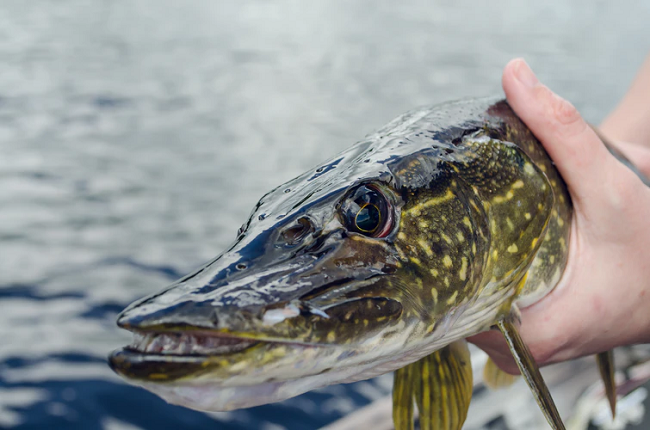
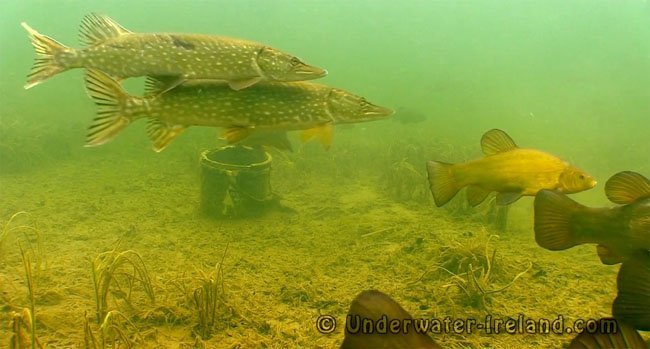
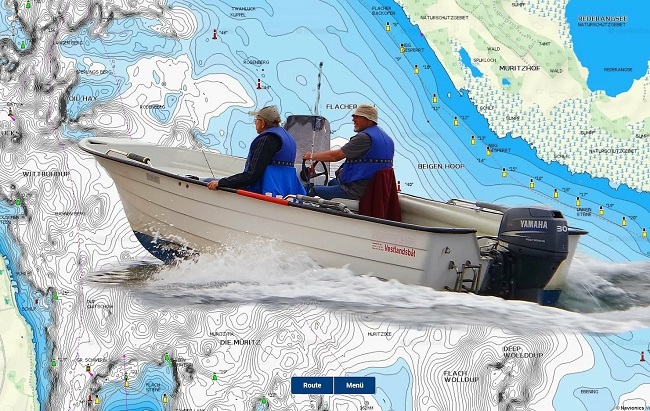
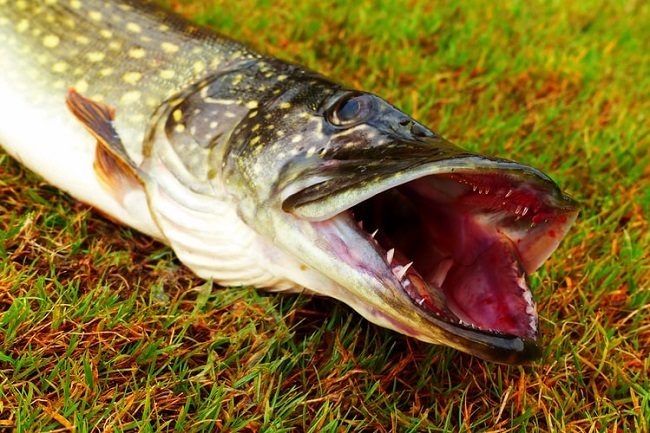
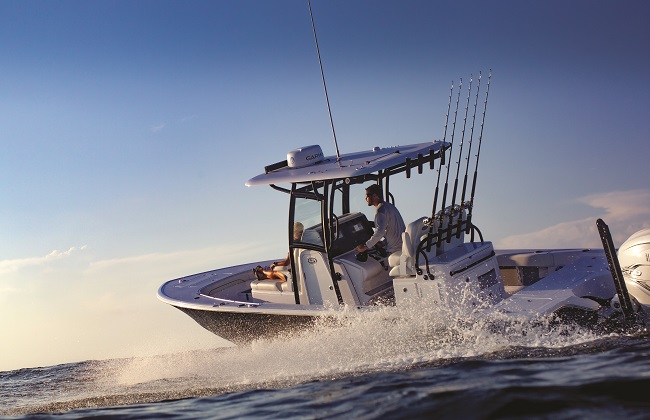
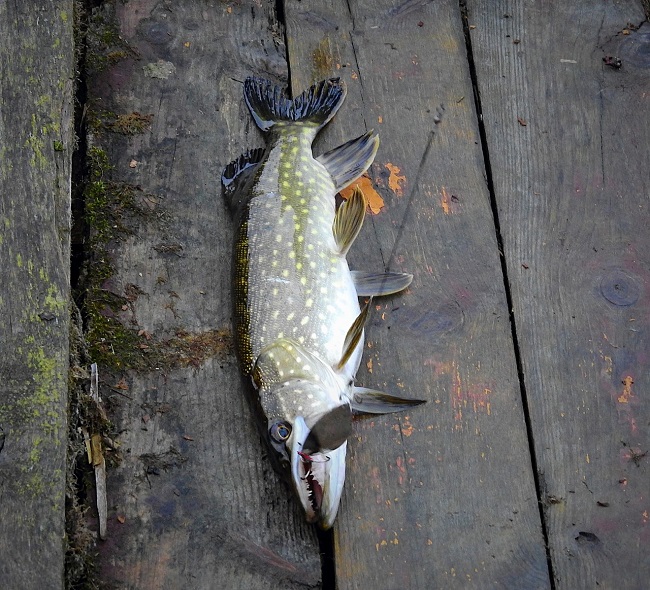
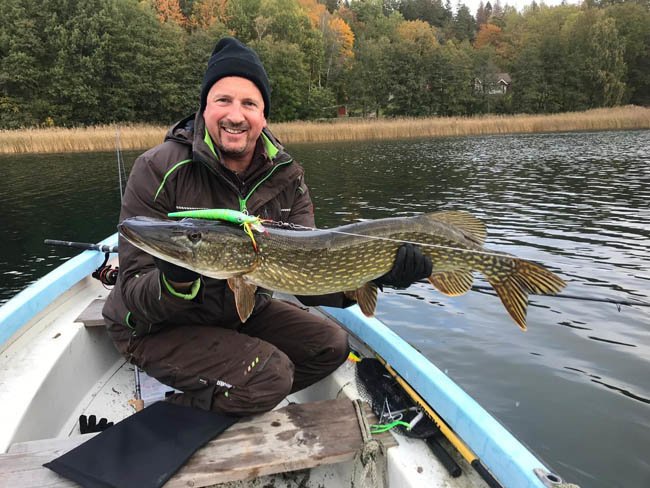
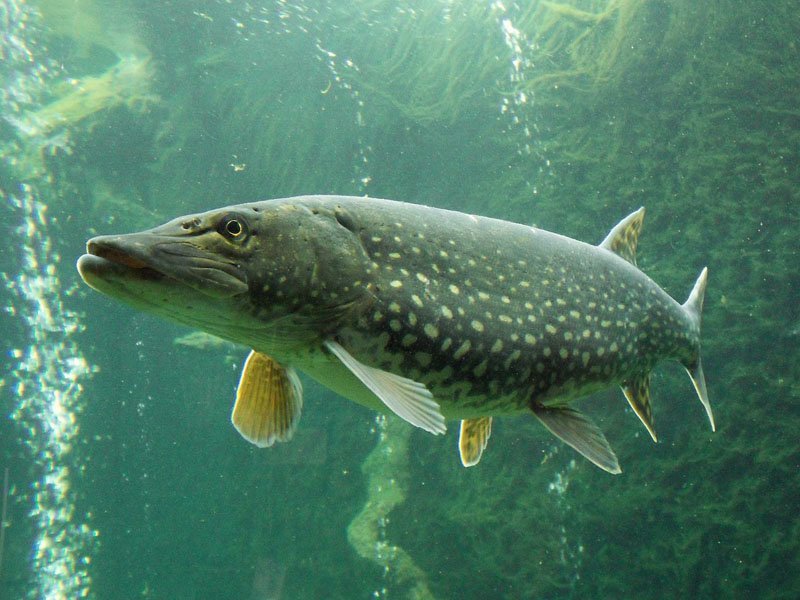
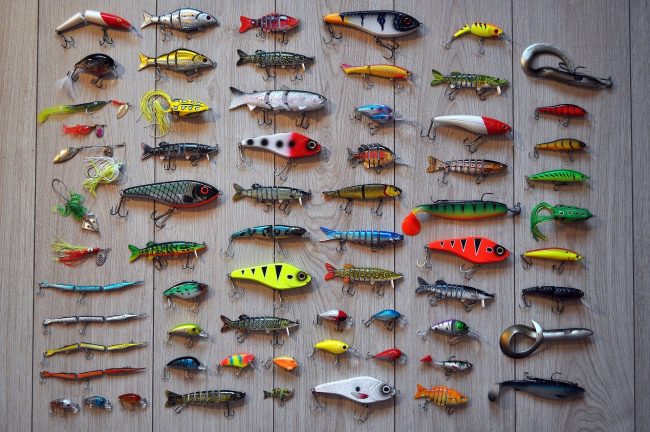
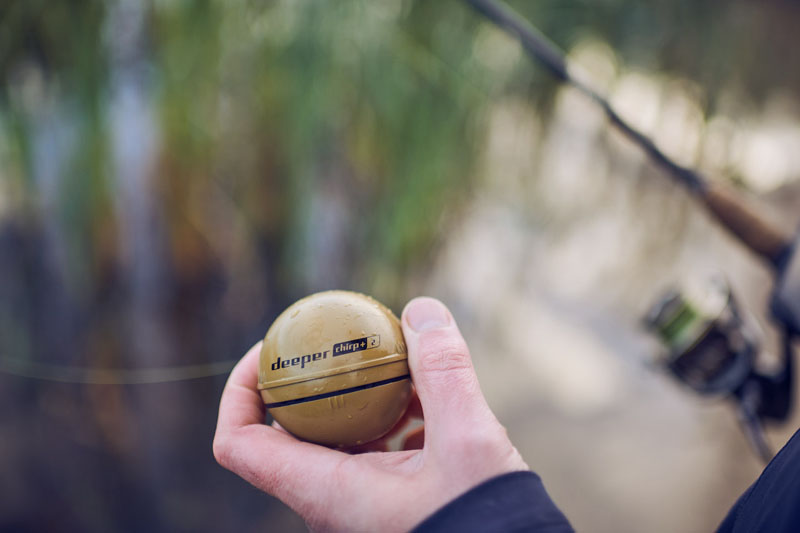

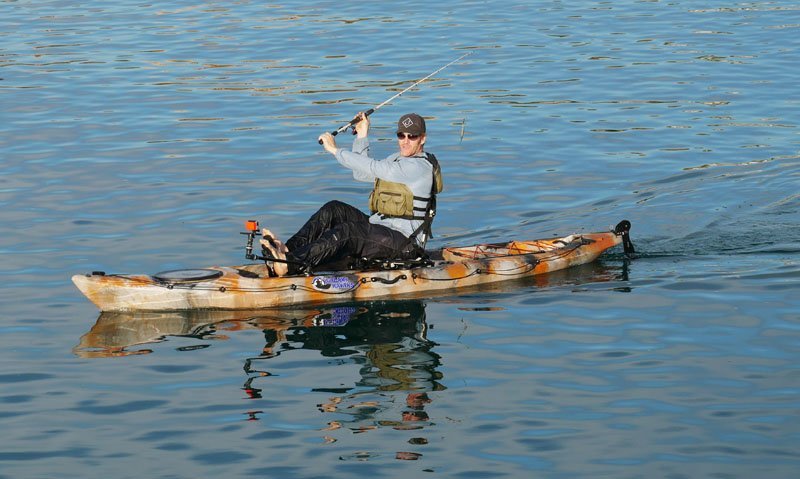

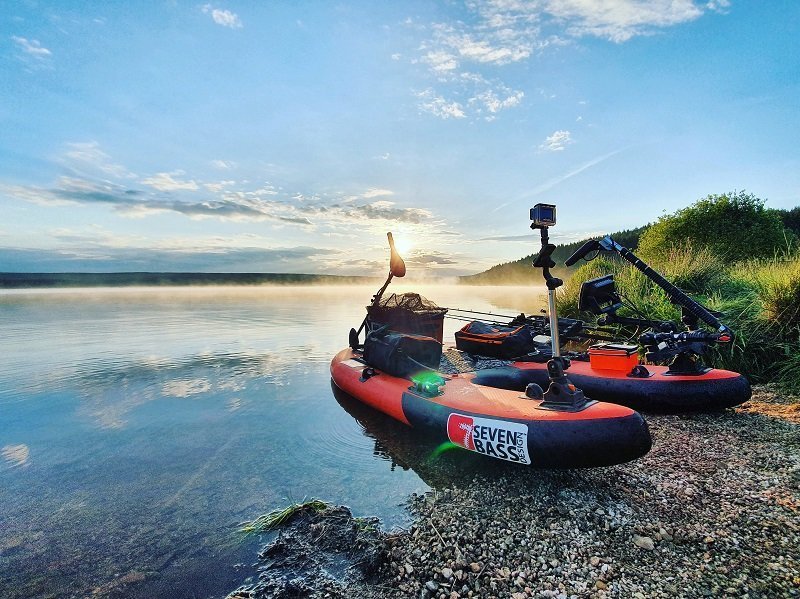
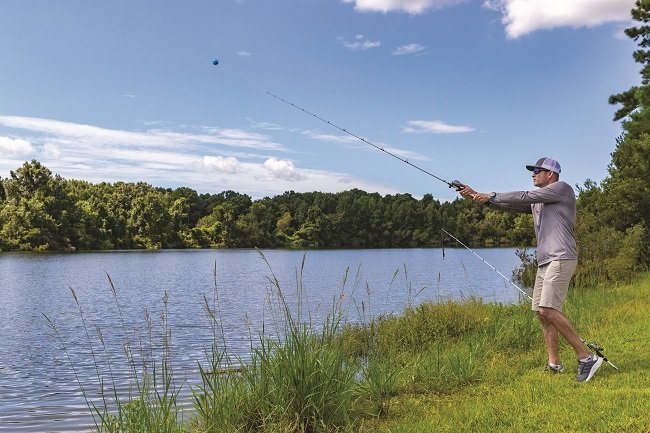
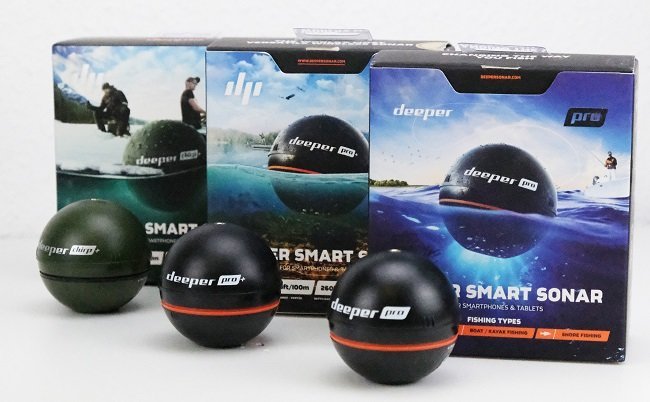

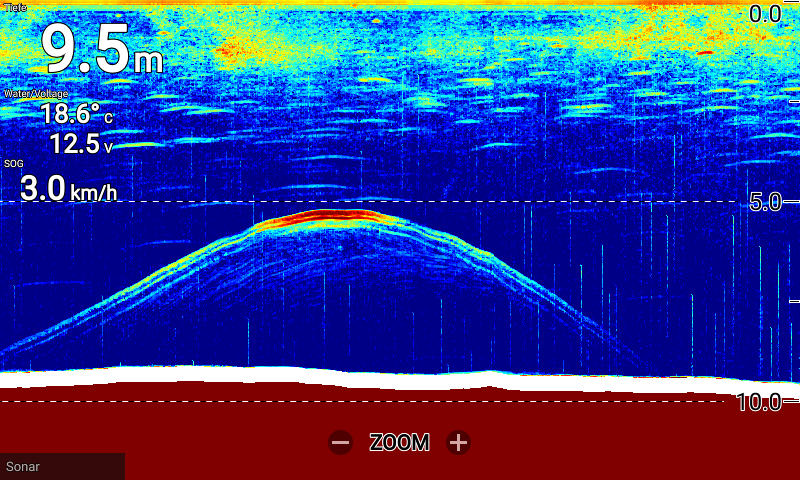
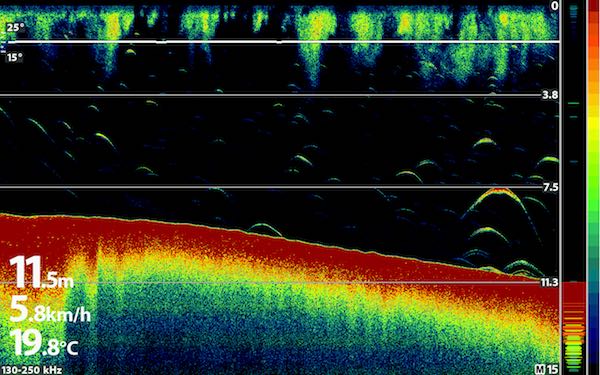
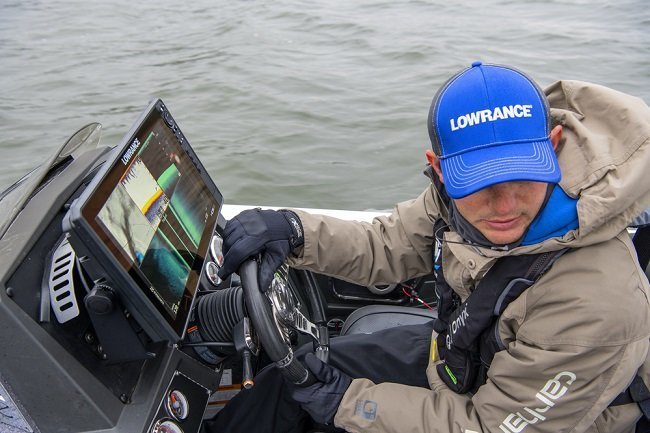
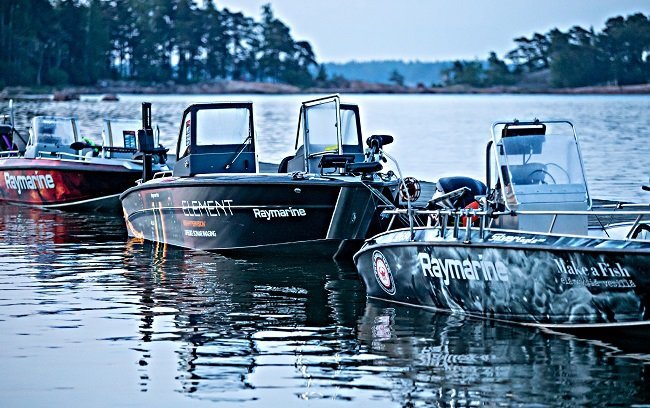
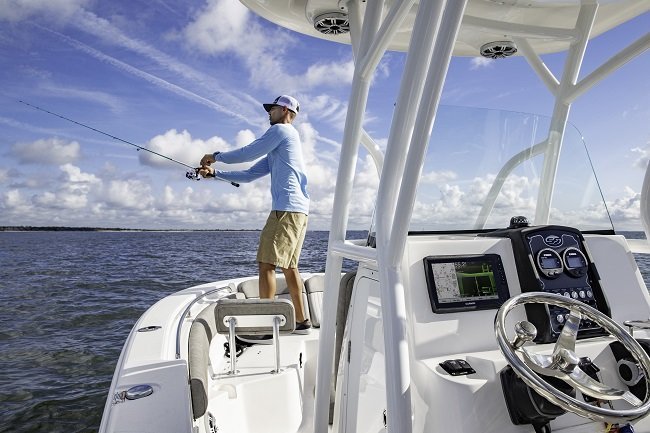


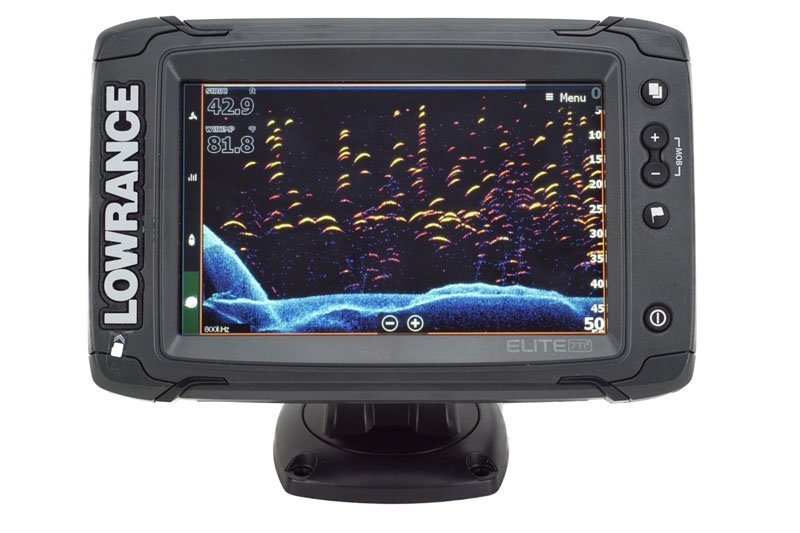
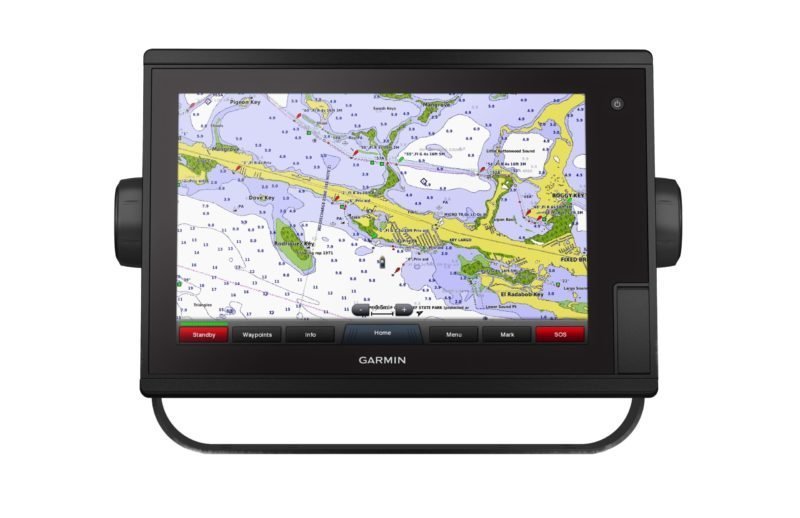

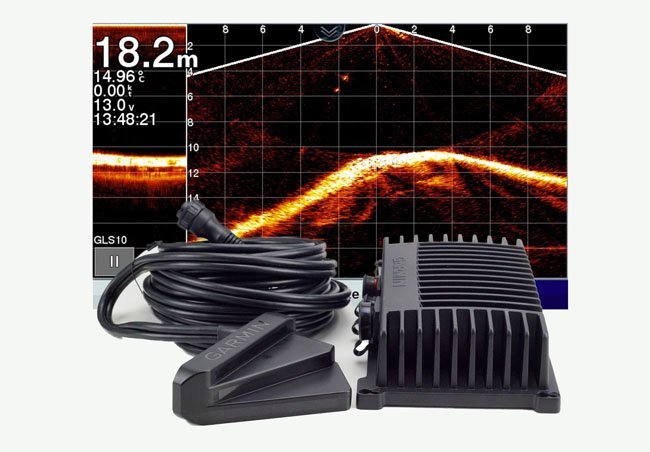
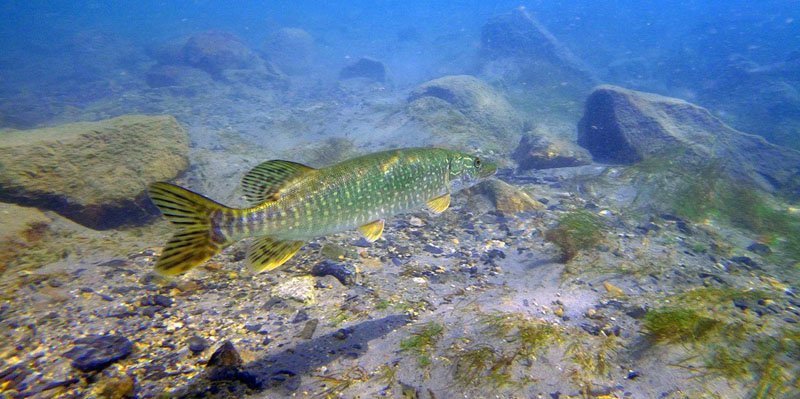
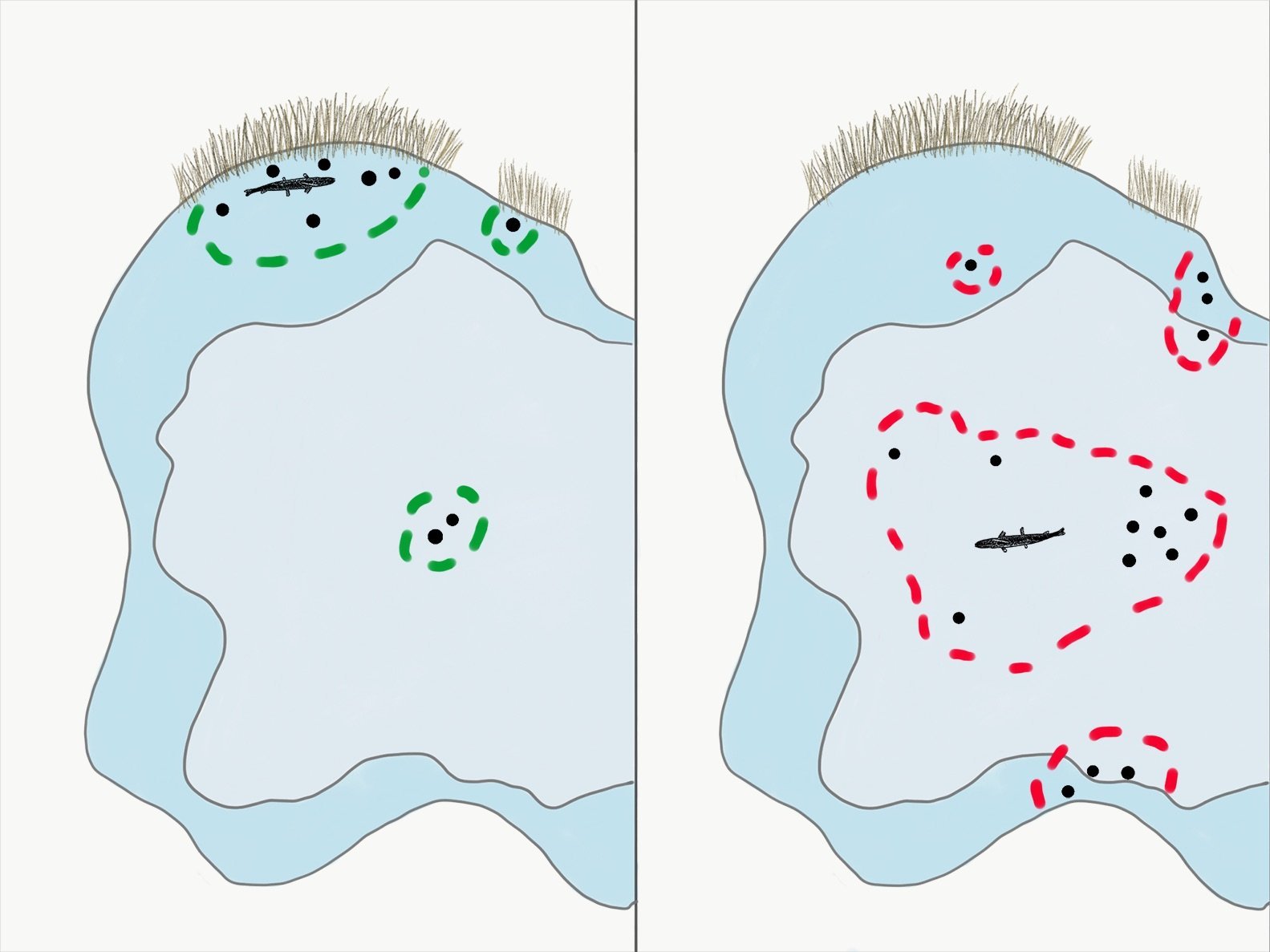
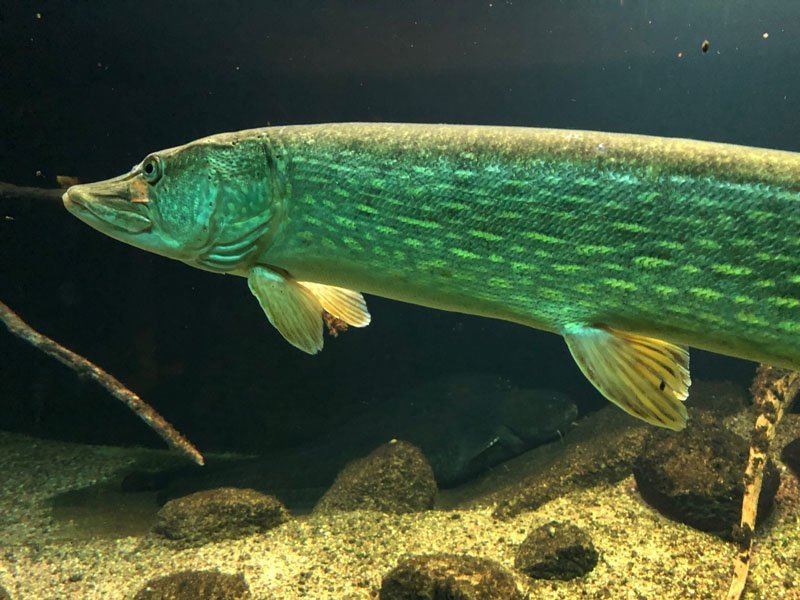
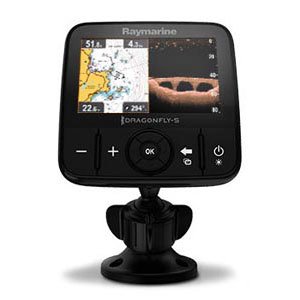
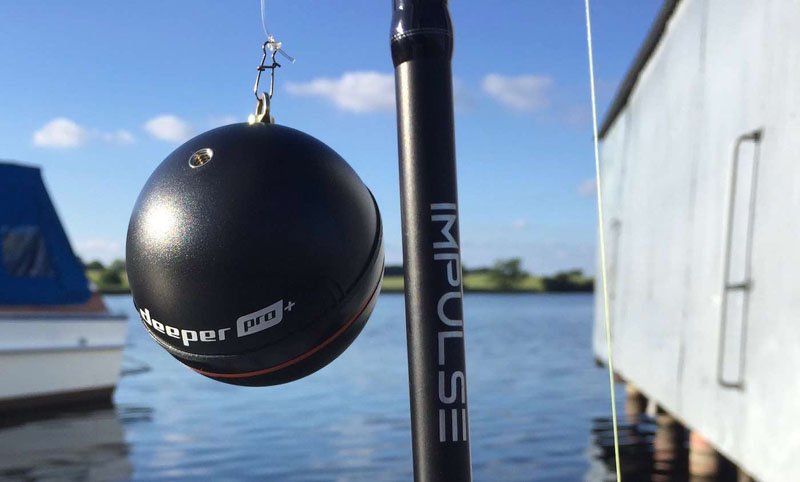
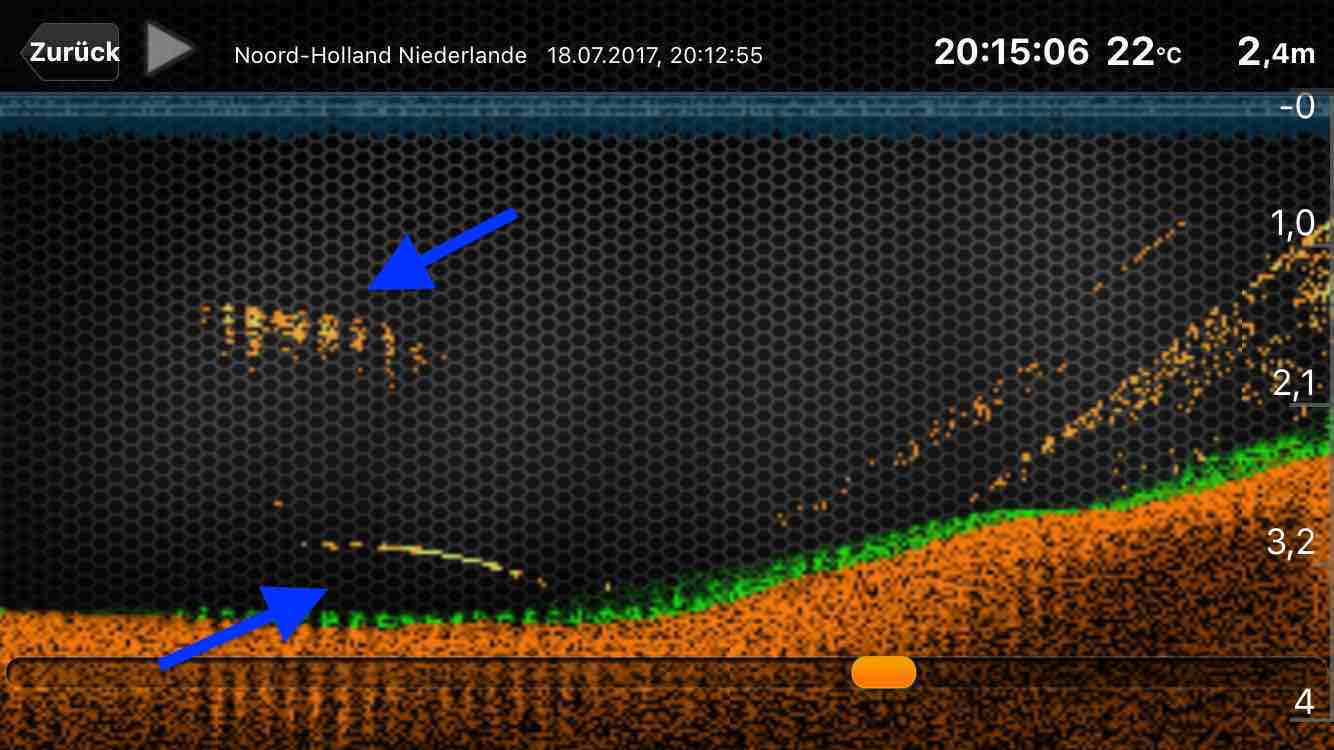
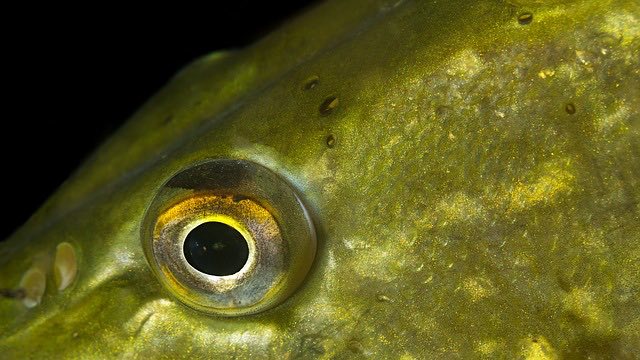


Martin
Garry Gregg
Andreas Eden
Martin
Claus Erhard
Dieter Gundacker
Kurt Sattler
Mirko
Holzblinker
Bruno
Stefan
Fischfreund
Paul KraUS
barney1at
Michael Hügel
frankadam67
Thomas Asamer
Andre Scholz
Manfred Parbs
Fabius Voigt
Julia
Pascal Schlenker
Heinz-Otto Schoel
Andreas Hillers
Stephandargel
Rolf Wilde
Blankmaster
Rudolf Knopf
markus s
Mitja
schoenfeld.oli
Robert Häusler
Martin
Edi Brader
lusox
Stefan Fischer
Lasse Wiedenhöft
Johann Burgstaller
Barschhunter
Andre Scholz
Andreas F.
Pascal Kreutzmann
Ralf B.
Bickes
opto
Adrian Drzezla
Evgenij
Daniel
Jörg
Dirk Lindner
Jörg Thielke
Stefan Klingbeil
Jörg Rolle
Philipp
Ben
Nico Drabner
Kuhnert Giso
David Götze
Peter
Ben
Kantor Alfred (Hatschi)
Patrick
Tacklefever
Andreas
Wolfgang Konter
Catchmaster
Jörg Rolle